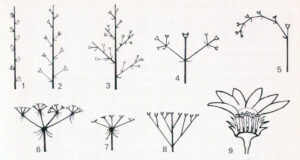Kaj Halberg - writer & photographer
Travels ‐ Landscapes ‐ Wildlife ‐ People
Himalayan flora 3
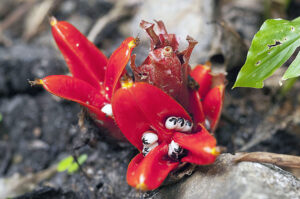

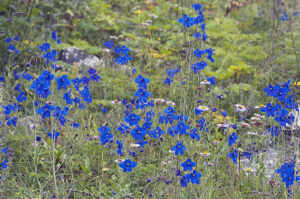
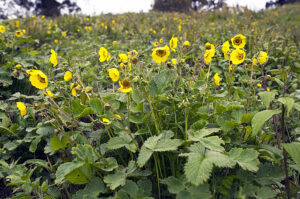
On this page, Tibet (in Chinese Xizang), Qinghai, and Xinjiang are treated as separate areas. The term ‘western China’ indicates Chinese territories just east of Tibet and Qinghai. The term ‘south-western China’ encompasses the provinces Yunnan, Guizhou, and Sichuan.
I would be grateful to receive information on any errors on this page, or if you are able to identify any of the species left unidentified. You may use this address: respectnature108@gmail.com.
The flower structure of these plants is unique, with 5 coloured sepals, the upper ones forming an erect hood, and 2-10 inner petals, 2 of which have nectar-producing spurs hidden under the hood. The fruit is a follicle, which is pod-like, but at maturity splitting along one side only.
The major part of the species are deadly poisonous, even in small dosages. In the old days, the poisonous juice of aconite species was applied to hunting arrows all over Eurasia, and it was also applied to arrows and spears during wars. In some areas, it was utilized to eliminate criminals.
The generic name refers to the mythical mountain Akonitos, near the Black Sea, where the Greek hero Heracles (in Latin known as Hercules) went to the underworld Hades to bring up its guardian, the three-headed dog Kerberos. As he tugged this terrible animal out of Hades, its froth fell on the ground as drops, from which aconite sprouted – a figure of the extreme toxicity of the genus.
The common names monkshood and helmet flower refer to the flower structure (see above), whereas the name wolfsbane refers to lycoctonine (derived from Ancient Greek lykos, ‘wolf’), an alkaloid found in these plants, which was formerly utilized to kill wolves, either by shooting them with arrows smeared in aconite juice, or by placing stakes, smeared in the juice, in trenches, in which a bait had been placed.
The role of these plants in traditional medicine and folklore is related on the page Plants: Plants in folklore and poetry.
It is distributed from central Nepal eastwards to Bhutan, growing in shrubberies and on open slopes at elevations between 2,100 and 3,800 m.
One of the most poisonous plants in the world. Nevertheless, it is widely used in traditional medicine. In Nepal, a paste of the root is applied to treat neuralgia, leprosy, cholera, and rheumatism. It is also considered diuretic and diaphoretic. The leaves are burned as incense. Hunters smear arrows in juice to kill prey. Formerly, shamans used this plant to create visions.
It is threatened by excessive collecting.
The specific name is Latin, meaning ‘wild’ or ‘fierce’, presumably alluding to its toxicity.
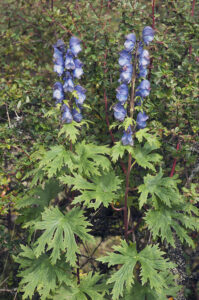
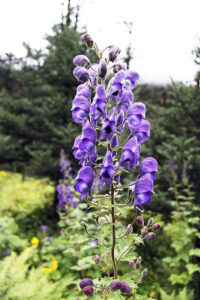
It is easily identified by the pale flowers and the leaves, which are divided into very narrow segments. Stem to 1 m tall, branched. Leaves few, lower stalked, to 10 cm across, rounded in outline, deeply divided 3 times into narrow segments, ultimate segments narrowly triangular to linear, to 2 mm broad. Flowers variable, to 3 cm long, in a spike-like, few-flowered, terminal cluster, to 9 cm long, corolla bluish, greenish-yellow, white with purplish tinge, or white with a purple hood. The hood is rather open. Flowering occurs August-October.
In Nepal, juice of the root is used for stomach ache.
The specific name commemorates Scottish gardener and botanist James Alexander Gammie (1839-1924), who collected plants for the Calcutta Herbarium. He also studied mammals, birds, and reptiles.
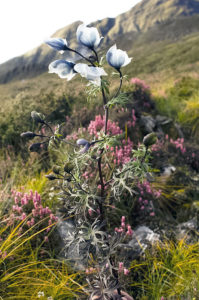
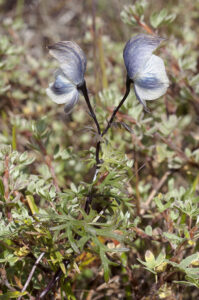
The flower colour in this genus is very variable, scarlet, orange, yellow, white, or blue. The fruit is a cluster of achenes.
The generic name refers to the Greek god Adonis, who died of his wounds while hunting wild boar, and was transformed into a blood-red flower, stained by his blood. Some species in this genus have scarlet flowers. See also Anemone below.
The common name also alludes to the members with scarlet flowers, which have a dark centre.
It has a rather limited distribution, found from central Nepal eastwards to Sikkim, growing on open slopes at elevations between 3,600 and 4,500 m.
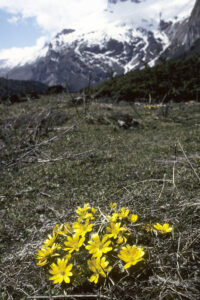
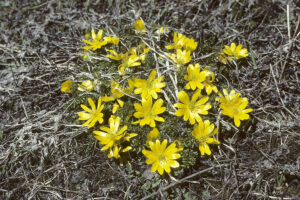
These plants have no sepals – or maybe the sepals are coloured, and the petals missing. On this page, I call them petals. The fruit is a cluster of tiny, nut-like achenes, in some species hidden among woolly hairs.
The name anemone is often linked to the Ancient Greek word anemos (’wind’), and windflower is a common English name of these plants. The connection, however, is hard to see, and, as indicated below, it is probably a wrong assumption.
According to Philip K. Hitti, in his book History of Syria including Lebanon and Palestine (1951), the Arabic name of the crown anemone (A. coronaria) is shaqa’iq an-Nu’man, which literally translates as ‘the wounds, or pieces, of Nu’man’. Nu’man probably refers to the Sumerian god of food and vegetation, Tammuz, whose Phoenician name was Nea’man. It is generally believed that the Arabic an-Nu’man became anemos in Ancient Greek, and that Tammuz was adopted by the Greeks as Adonis, who died of his wounds while hunting wild boar, and was transformed into a blood-red flower, stained by his blood. In the Near East, the crown anemone is often of the blood-red variety.
Lately, many species of this genus have been transferred to the genera Eriocapitella, Anemonoides, and Anemonastrum by Kew Gardens, based on small differences. This is a bit of a mystery to me, and, for the time being, I retain the old systematics.
A number of anemone species from other parts of the world are described on the page Plants: Anemones and pasque flowers.
It is very variable, more or less hairy on all parts, except flowers. Leaves numerous, stalked, blade 3-partite, ovate or rhombic in outline, to 8 cm long and broad, hairy, base heart-shaped, segments again 3-partite.
Flower-stalks may grow to 50 cm tall, but are usually much lower, inflorescence a terminal umbel with up to 8 flowers, involucral bracts 3-partite or 3-lobed, to 4 cm long. Individual flowers stalked, petals 5-7, white, blue, purple, or red, to 1.8 cm long and 1.2 cm wide. They appear May-July.
The specific name is Latin, in a botanical context with two meanings, ‘pendent’ or ‘low’. What it refers to in this case is not clear.
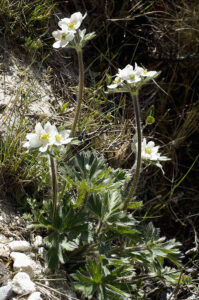
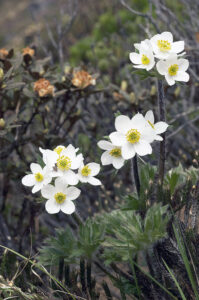
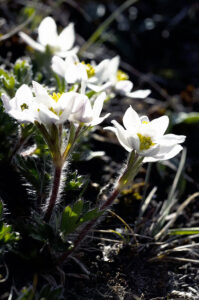
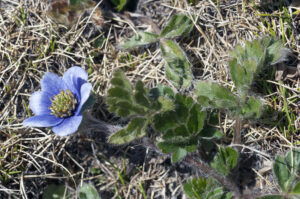
Leaves are numerous, basal, soft-haired, rounded in outline, blade to 8 cm across, 3-lobed, rather rounded-toothed. Flower-stalk to 15 cm long, flowers numerous, in spreading umbels, involucral bracts stalkless, very variable in shape, 3-lobed or undivided, to 3 cm across, corolla to 5 cm across, but usually smaller, petals 5-8, elliptic to obovate, soft-haired beneath, colour variable, white, blue, or bright yellow, the latter restricted to Kashmir and northern Pakistan. It has a long flowering period, from May to September.
In Nepal, juice of the root is used for eye trouble.
The specific name is Latin, meaning ‘with rounded lobes’, alluding to the leaves.

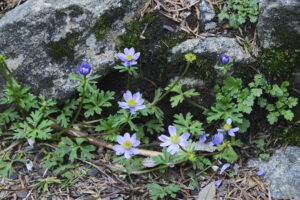
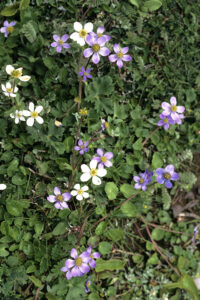
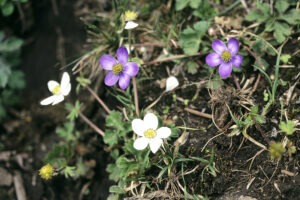
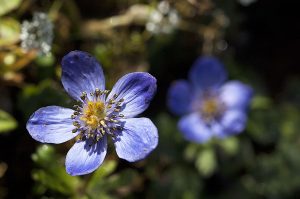
It is distributed from Pakistan eastwards to Bhutan, found in forests and shrubberies, and on open slopes, at elevations between 2,400 and 4,300 m.
The specific name is derived from Ancient Greek polys (‘many’) and antheros (‘anther’).
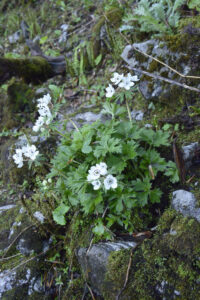
Often a large plant, stem to 1 m long, leaves 3-5, long-stalked, soft-haired, rounded in outline, blade to 15 cm across, lobes 3, toothed or cut. Flowers to 3 cm across, many in a terminal long-stalked umbel, involucral bracts 3-4, like the leaves, but stalkless, blade 3-lobed, lobes narrower than on the leaves. Petals 5-10, white above, purplish-violet beneath, elliptic to obovate, soft-haired beneath. Flowering occurs May-August.
In Nepal, the seeds are roasted and pickled. Medicinally, a paste of the plant is used for cough and fever, a decoction of the root is applied to wounds, and juice from the leaves is mixed with water and inhaled to relieve sinusitis.
Some authorities place this species in the genus Eriocapitella.
The specific name is derived from the Latin rivus (‘small stream’), thus ‘growing along streams’.
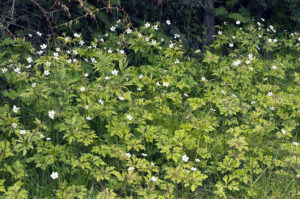
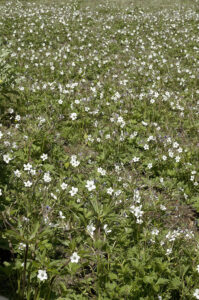
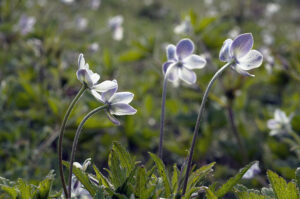
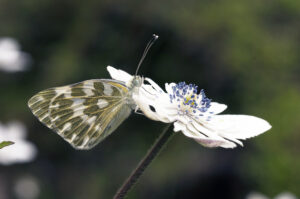
It is found in Central Asia, from Uttarakhand eastwards across the Himalaya to northern Myanmar and south-western China, growing in forests and shrubberies, and on open slopes, at elevations between 2,500 and 5,000 m.
Some authorities place this species in the genus Anemonastrum.
The specific name is Latin, meaning ‘growing on rocks’ – not a suitable name, as it is mainly found on open slopes or among shrubs.
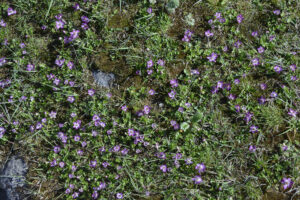
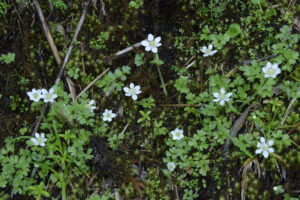
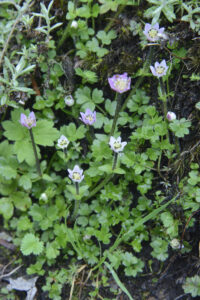
Basal leaves 3-7, sparsely hairy, leathery, blade heart- or kidney-shaped, to 20 cm across, lobes 5, deeply cut, toothed, leaf-stalk to 40 cm long. Flower-stalk to 75 cm tall, hairy, involucral bracts 2-5, stalkless, blade 3-lobed, lobes narrow, toothed, downy, flowers white, to 3 cm across, 7-15 in a terminal umbel, petals 4-7, obovate to oblong. The flowering period is from June to August.
The specific name is Ancient Greek, meaning ‘with 4 sepals’ (on this page called petals). However, it may have up to 7.
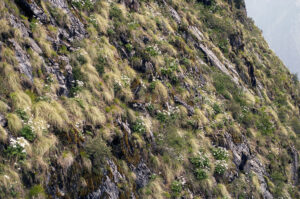
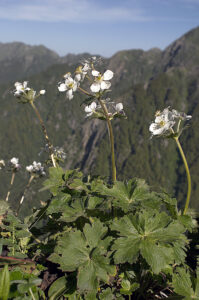
It is found from Afghanistan eastwards across the Himalaya and southern Tibet to south-western China, and also in Taiwan, growing in open forests and grasslands, and along streams. In the Himalaya, it may be encountered at elevations between 2,000 and 3,300 m.
In Nepal, it is used medicinally for various ailments, including toothache, headache, and dysentery. A paste of the root is applied to treat scabies, and juice of the root is used to expel intestinal worms. The toxic leaves are strewn in rivers to stupefy fish, and powdered leaves are applied to the head to kill lice. The woolly seed hairs were formerly used as tinder.
The specific and popular names were given in allusion to the upper stem leaves, which resemble those of the grape vine (Vitis vinifera).
Some authorities place this species in the genus Eriocapitella.
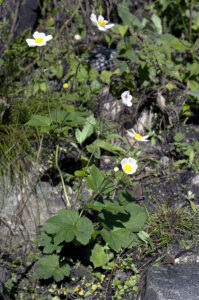
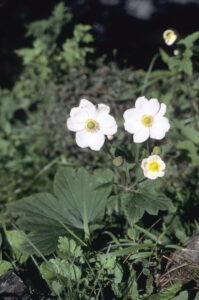
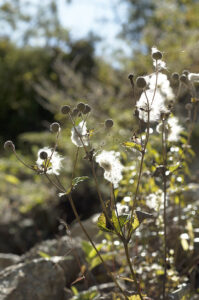
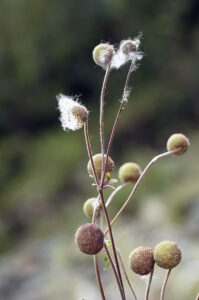
They are characterized by the peculiar shape of the flowers, each of the 5 petals having a spur, pointing backwards, and curved in many species. The petals alternate with 5 narrower and smaller sepals, usually of the same colour as the petals. The leaves are tripartite, with blunt lobes. The upper stem leaves are small, bract-like.
The generic name was first used by Swiss botanist Gaspard Bauhin (see below), when he described the Alpine columbine (A. alpina, presented on the page Plants: Flora in the Alps and the Pyrenees). The name is derived from the Latin aqua (‘water’) and legere (‘to collect’), thus ‘water jar’, referring to the shape of the flower.
Another interpretation claims that it is derived from the Latin aquila (‘eagle’), where the spurs are likened to eagle claws.
The common name columbine is derived from the Latin columba (‘dove’), referring to the alleged resemblance of the inverted flower to five doves, clustered together. Another popular name is granny’s bonnet, again referring to the flower shape.
In his outstanding work Pinax theatri botanici (‘Illustrated exposition of plants’), from 1623, this brilliant scientist described about 6,000 plant species, classifying them in a form, which almost equals the binominal nomenclature, introduced by Swedish botanist Carl Linnaeus (1707-1778) in 1753.
The major part of the information above is from the website en.wikipedia.org/wiki/Gaspard_Bauhin.

Stem to 80 cm tall, branched above. Basal leaves twice divided into 3 parts, each leaflet with 3 toothed lobes, to 4 cm long, leaves getting gradually smaller up the stem, the uppermost bract-like with 1-3 lanceolate, pointed segments. Flowers several on each branch, horizontal or slightly nodding, to 5 cm across, white or cream-coloured, fragrant, spurs straight or hooked, to 1.8 cm long, sepals to 3 cm long and 1.2 cm wide, blunt or pointed. It flowers June-August. Follicles 6-9, densely hairy.
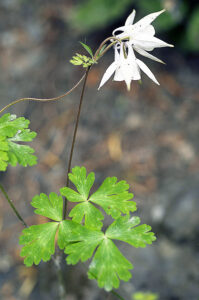
Flowers are mostly nodding, to 3.5 cm across, 2 or more on each branch, sepals ovate, to 2.1 cm long, bluish, purplish, or white with a purplish tinge, petals yellowish or white with a bluish tinge, erect, to 1.3 cm long, spur straight or slightly curved, to 2 cm long. Blooming period is June-August. Follicles 5-6, hairy, to 2.5 cm long.
It is distributed from Afghanistan eastwards to south-western Tibet and western Nepal, growing on open slopes and in shrubberies near streams, found at altitudes between 2,700 and 4,200 m. It is common in Ladakh.
The specific name was given in honour of British veterinary surgeon and botanist William Moorcroft (1765-1825), who explored several areas in the Himalaya and Central Asia. He was the first European to make botanical collections in western Tibet and Kashmir.
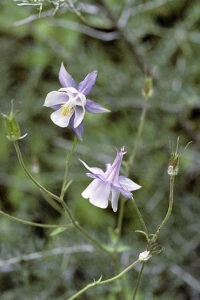
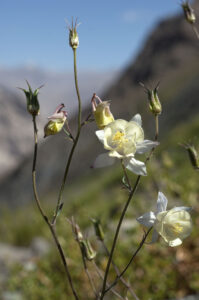
It occurs from Pakistan eastwards to western Nepal, growing at elevations between 2,400 and 3,300 m. Habitats include forests, shrubberies, and grasslands.
The specific name is Latin, meaning ‘with downy flowers’.
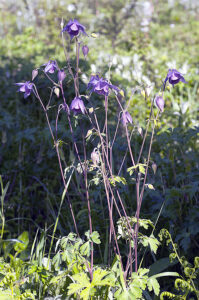
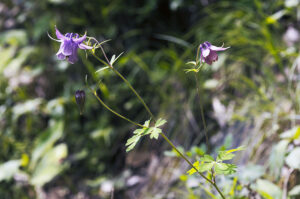
Roman naturalist Pliny the Elder (23-79 A.D.) states that “Caltha is a plant with yellow flowers.” The word is possibly derived from Ancient Greek kalthe (‘of yellow colour’).
Inflorescences are terminal, branched, with up to 8 flowers, to 3 cm across, petals 5, broadly ovate, deep yellow, with numerous yellow stamens. Self-pollination occurs in rainy weather, as the flowers fill with water, and anthers and stigma are at the same height. The plant may also spread by rooting at the nodes.
At lower elevations, flowers may appear as early as March, but blooming may also take place late in the summer, in August, especially at higher altitudes.
As its name implies, this is a plant of marshy areas, in meadows, ditches, wet forests, and along streams. Its distribution is circumpolar in subarctic and temperate areas, southwards to Oregon, South Carolina, the Mediterranean, Iran, and northern Indochina. It is found throughout the Himalaya, at elevations between 2,400 and 4,200 m.
The specific name is derived from the Latin palus (‘swamp’), alluding to its preferred habitat.
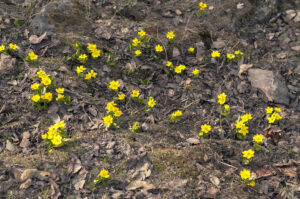
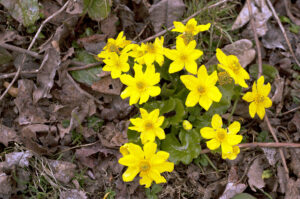
It is distributed from central Nepal eastwards to south-western China, and thence northwards to Gansu and Qinghai, growing in marshy meadows and along streams, at altitudes between 2,800 and 4,100 m.
The specific name is Latin, meaning ‘with leafless flower-stalks’.
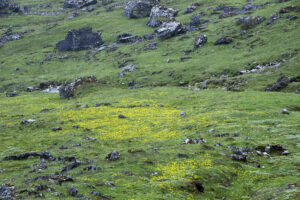
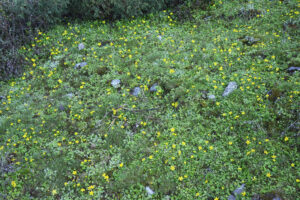
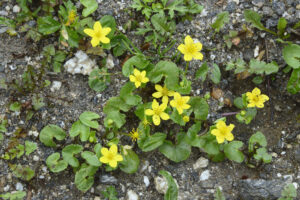
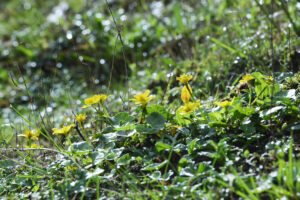
These plants are climbing due to the sensitivity of the leafstalks which, when touching another plant or something else, start twisting, curling around the object.
The generic name is derived from Ancient Greek klema (‘climber’).
Inflorescences are axillary, branched clusters, bracts narrowly ovate to lanceolate, to 4 cm long, flowers to 2 cm long and across, white or yellowish, petals recurved. Flowering takes place August-October, ripening of fruits September-November.
It is found from Pakistan eastwards to south-western China, growing at altitudes between 1,800 and 3,400 m. Habitats include forests, shrubberies, and along streams.
In Nepal, juice of the plant is inhaled to treat sinusitis.
The specific name is Latin, meaning ‘born at the same time’, but in a botanical context it refers to two connected items, in this case the leaf-stalks.
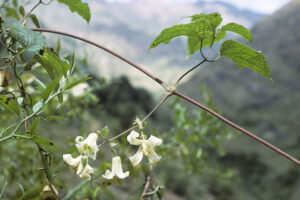
A woody climber, to 10 m long, branches with up to 10 shallow grooves, leaves trifoliate, long-stalked, in axillary clusters, stalk to 9 cm long, blade of leaflet ovate or elliptic, to 10 cm long and 5 cm broad, margin toothed, tip pointed.
Flowers are stalked, to 6 cm across, up to 6 together in axillary clusters, petals 4, white, sometimes pinkish, spreading, obovate or oblong, to 6.5 cm long and 3.5 cm wide, tip usually blunt. Stamens numerous, filaments white, to 5 mm long, anthers violet. It blooms between April and June, and ripening of fruits takes place June-September.
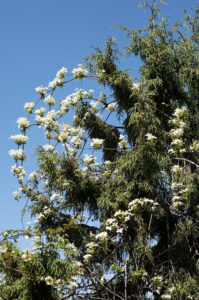
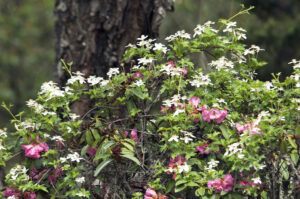
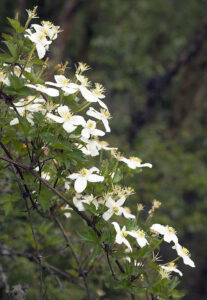
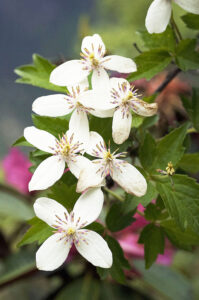
Flowers axillary, to 4.5 cm across, up to 3 together, stalk to 13 cm long, petals 4, yellow with brown dots, sometimes purplish-brown, orange, or yellowish-green, to 2.8 cm long and 1.7 cm wide, ovate or oblong, pendent or spreading, woolly-hairy above and on margin, tip pointed. It flowers May-August, and ripening of fruits takes place July-October.
This plant is distributed from Xinjiang southwards across Tibet to Pakistan and Ladakh, and thence eastwards to Nepal, growing in dry open areas, especially on stone walls along fields, at altitudes between 1,700 and 4,000 m. It is very common in Ladakh.

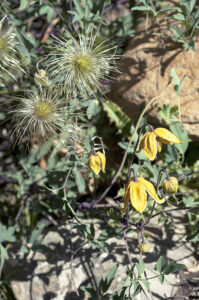
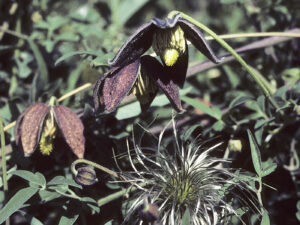
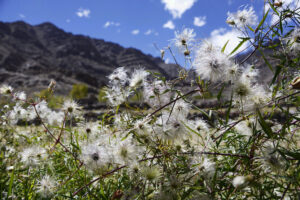
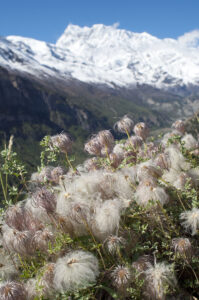
Flowers are irregular, with 5 sepals, the upper one with a large, back-pointing spur, and 4 inner petals, of which the upper 2 have nectar-producing spurs that are enclosed in the larger spur.
Despite being extremely poisonous, these plants were previously much used in folk medicine as a sedative, and to treat various ailments, including fluid retention, poor appetite, and insomnia, and to get rid of intestinal worms. Some members were formerly included in the genus Consolida, the name derived from the fact that these plants were used in the Middle Ages to help consolidate (i.e. coagulate) blood. They are deadly if consumed by livestock.
The generic name is derived from Ancient Greek delphinion (‘dolphin’). In his De Materia Medica, Greek physician, pharmacologist, and botanist Pedanius Dioscorides (died 90 A.D.) says that the these plants are named for their dolphin-shaped flowers. The English names refer to the long spur.
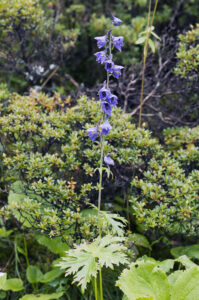
It grows on stony slopes in dry areas, at altitudes between 3,500 and 5,500 m, distributed from Afghanistan, Pakistan, Ladakh, and Himachal Pradesh eastwards across southern Tibet to eastern Nepal. It is quite common in Ladakh and Lahaul.
In Ladakh, juice of the plant is used for treating colic, flowers and leaves for fever, bile, food poisoning, skin disease, and to expel intestinal worms. In Nepal, juice of the plant is used to kill ticks on domestic animals.
The specific name probably commemorates Scottish botanist Robert Brown (see below).

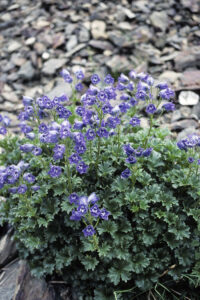
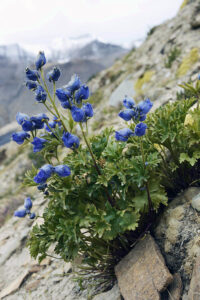
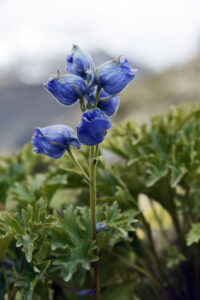
By 1800, Brown was one of the foremost botanists in Ireland, corresponding with a number of established botanists. In 1801, he became a member of an expedition to Madeira, South Africa, and Australia, on board the Investigator, whose captain was British navigator and cartographer Matthew Flinders (1774-1814). For three and a half years, Brown studied Australian plants, collecting about 3,400 species, of which about 2,000 were previously unknown to science.
In 1810, he published his results from the expedition in Prodromus Florae Novae Hollandiae et Insulae Van Diemen (‘Preliminary Flora of New Holland [today Australia] and van Diemens Island’ [today Tasmania]), the first systematic account of the Australian flora.
The same year, he was appointed librarian of the famous botanist Joseph Banks (1743-1820), and when Banks died in 1820, Brown inherited his library and herbarium, which were transferred to the British Museum in 1827.
In 1830, Brown was one of the founding members of the Royal Geographical Society, and he served as president of the Linnean Society 1849-1853.

Inflorescences are widely branched, few-flowered, terminal clusters, bracts to 1.5 cm long, linear, flowers to 2.5 cm long, including the straight spur to 1.5 cm long, corolla blue or violet, spur white. Flowering takes place May-August.
A rather common plant, found from Pakistan eastwards to central Nepal, growing at elevations between 1,500 and 2,700 m. Habitats include open forests, grassy areas, and along fields and trails.
In Nepal, a paste of the root is applied to treat toothache.
The specific name is Latin, meaning ‘naked’, presumably alluding to the stem, which is usually smooth.
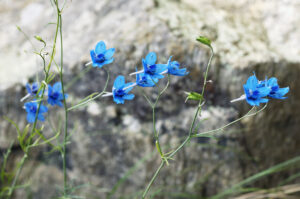
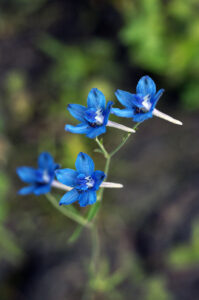
It is hairy all over, stem usually below 15 cm long, at lower elevations up to 30 cm. Leaf-blade to 4 cm across, 3-lobed, each lobe cut into many narrow, toothed segments. Inflorescences are branched, few-flowered, terminal clusters, bracts leaf-like, bracteoles entire, lanceolate or linear, to 1.2 cm long, flowers short-stalked, pale-blue or mauve, to 4 cm long, including the straight, conical spur, to 1.4 cm long, thick at the base. Flowering occurs July-September.
The specific name is derived from the Latin glacies (‘ice’), referring to the plant growing at very high elevations.
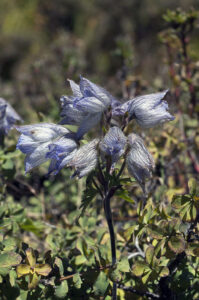
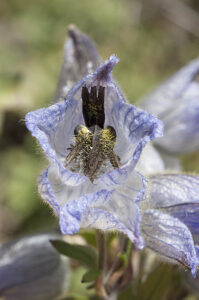
This plant is endemic to western and central Nepal, growing in open areas at elevations between 2,000 and 4,500 m.
In Nepal, juice of the root is given for cough and colds. An infusion of the root is applied to wounds in the hooves of cattle to expel maggots or kill germs.
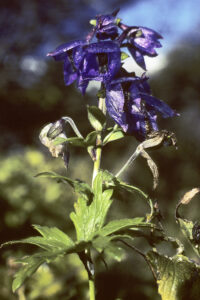
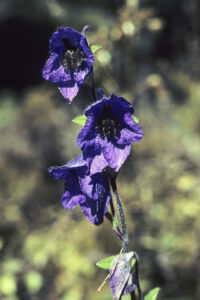
It is distributed from Uttarakhand eastwards to central Nepal, across southern Tibet to the Yunnan Province, and thence nortwards to Gansu and Qinghai, in the Himalaya growing in grasslands and on open slopes at elevations between 3,000 and 4,300 m.
In Nepal, a decoction of the plant is applied to treat scabies.
The specific name refers to the district of Kumaon, in present-day Uttarakhand, which was formerly a kingdom, known as Kemaon or Kamaon. Presumably, the type specimen was collected in this area.
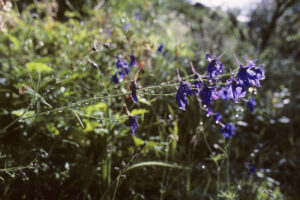
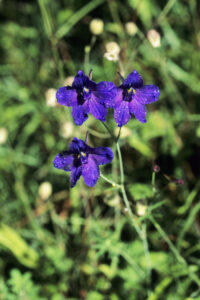
These plants were previously included in Ranunculus (below), but they are possibly more closely related to Oxygraphis (below), or to the American genus Cyrtorhyncha.
The stem is to 35 cm long, smooth, branched, rooting at the nodes. Leaves variable, 3-5-lobed or rarely entire, blade to 2.6 cm long and 2.2 cm across, smooth, lobes often rhombic, blunt. Flowers are solitary, short-stalked, to 1.2 cm across, sepals 4-5, ovate or elliptic, to 5 mm long, petals 5, bright yellow. Blooming occurs June-August.
In Ladakh, leaves, stem, flowers, and fruit are used for heat disorders of tendons and ligaments.
The specific name is derived from the Latin tria (‘three’) and cuspis (‘point of a spear’), alluding to the leaves often being tripartite, with pointed segments.
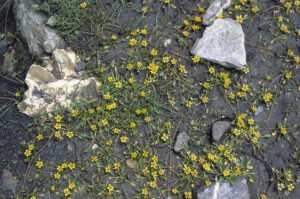
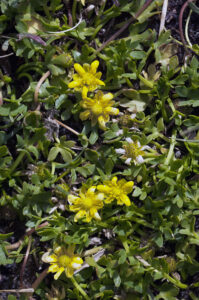
It grows on open slopes, often where the snow has recently melted, at elevations between 2,200 and 5,000 m, distributed from Pakistan eastwards to Bhutan.
The specific name commemorates Austrian botanist and sinologist Stephan Ladislaus Endlicher, born István László Endlicher (1804-1849), director of the Botanical Garden in Vienna. In his work Genera Plantarum (1831-41), he produced a new system of plant classification.
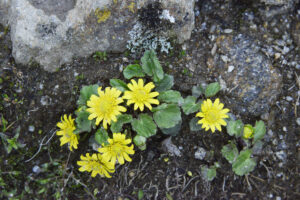
The generic name is a diminutive of rana (’frog’), thus ’little frog’, referring to the fact that many buttercup species grow in wet areas, where frogs live. The English name refers to the butter-yellow flowers of many species, and the tiny ‘cup’, formed by the petals. The name crowfoot was given in allusion to the tripartite leaves of some species, which somewhat resemble a bird’s foot, whereas spearwort alludes to species with long, undivided leaves.
When left unharmed, many buttercup species may cover huge areas. Grazing animals avoid them, as they contain the toxic anemonol. However, when dried as hay, the toxicity disappears.
According to an old belief, cows grazing on buttercups would produce the sweetest and most flavourful milk, rich in cream. Of course, this is pure superstition, as cows avoid these plants due to their toxicity. Rather, the richness of the milk would stem from the succulent grass in the meadows.
Stem to 12 cm long, erect or ascending, sometimes branched, basal leaves many, stalked, rounded in outline, divided into narrow lobes, stem leaves dissected into linear, pointed segments, to 1.5 cm long, upper ones stalkless. Flowers solitary, terminal, to 1.3 cm across, sepals 5, hairy, ovate, reflexed, to 3.2 mm long, petals 5, obovate or elliptic, bright yellow, to 8 mm long and 4 mm wide. Blooming takes place between May and August.
The specific name was given in honour of Finnish botanist Viktor Ferdinand Brotherus (1849-1929), an expert of mosses.
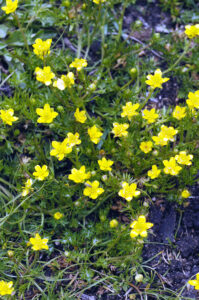
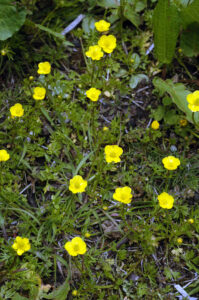
Flowers solitary, axillary, long-stalked, to 1.5 cm across, sepals ovate, to 6 mm long, hairy, petals 5-6, obovate, to 7 mm long and 4 mm wide, bright yellow. Flowering takes place March-July.
It is distributed from Afghanistan eastwards to Myanmar and south-western China, growing at altitudes between 1,000 and 4,000 m. Habitats include grasslands, shrubberies, among rocks, and along streams.
In Nepal, young shoots are dried and cooked as a vegetable, and also fermented to make gundruk (see Arisaema utile, Himalayan flora 1). The pounded root is applied to wounds. Juice of the root is used for stomach ache.
What the specific name refers to is not clear.
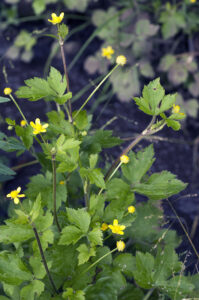
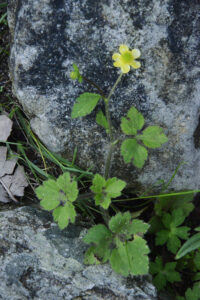
Stem usually below 10 cm tall, occasionally to 20 cm, creeping, ascending, or erect, smooth, often branched. Leaves very variable, to 1.6 cm long and 9 mm wide, linear, elliptic, or ovate, usually entire, sometimes lobed or toothed. Flowers solitary, terminal, short- or long-stalked, to 1 cm across, sepals 5, elliptic or ovate, to 7 mm long and 5 mm broad, hairy, sometimes black-tipped, petals 5, bright yellow. Flowering period June-August.
The specific name is Latin, meaning ‘pretty’ or ‘beautiful’.
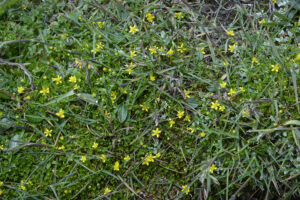
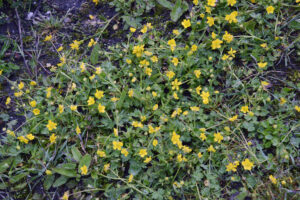
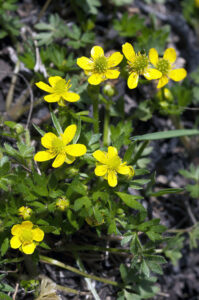
The leaves of these plants are large and divided two or three times, and the flowers are arranged in many-branched clusters, in which the numerous, often brightly coloured stamens have taken over the role as display apparatus instead of the petals, which are often small or absent. However, 3 species below, T. chelidonii, T. reniforme, and T. virgatum, have conspicuous petals.
The generic name is a Latinized form of the Ancient Greek name of these plants, thaliktron. The popular name stems from the similarity of the leaves to those of the genuine rues (Ruta).
It grows in forests and shrubberies at elevations between 2,600 and 4,300 m, distributed from Kashmir eastwards to south-eastern Tibet and northern Myanmar.
The specific name is Greek, meaning ‘swallow-like’. What it refers to is not clear, perhaps the shape of the flower.
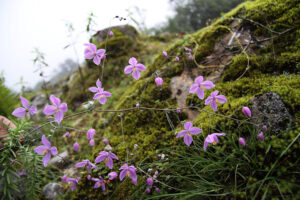
Inflorescences are terminal or axillary, many-flowered clusters, petals small, green or yellowish-green, to 4 mm long and 1.5 mm wide, stamens many, to 1 cm long, filaments purple, anthers purplish-yellow. The flowering period is long, from May to September.
It is widespread, found from southern Europe eastwards to south-eastern Siberia, southwards to Turkey, Iran, the Himalaya, and central China. In the Himalaya, it is restricted to the western part, from Pakistan eastwards to central Nepal, growing in forests, grasslands, and rocky areas at elevations between 1,500 and 4,700 m.
The specific name is Latin, meaning ‘stinking’.
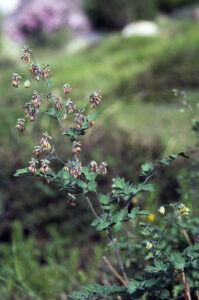
A tall plant, stem to 2.6 m long, branched, leafy, leaves to 45 cm long, divided 3-4 times, leaflets rounded, to 1.5 cm across, with 3-7 blunt teeth. The inflorescences are terminal or axillary, many-flowered panicles, to 20 cm long, petals 4, white, yellow, purplish, or greenish, narrowly elliptic, to 4.5 mm long and 2 mm wide, soon falling, often giving the impression that the plant has no petals. Stamens longer than petals, filaments thread-like, white or purplish, anthers yellow. Flowering occurs July-September.
Medicinally, this plant is used as a tonic, diuretic, febrifuge, and purgative, and for stomach trouble.
The specific name is Latin, meaning ‘with many leaves’.
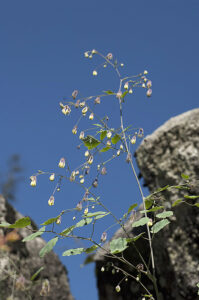
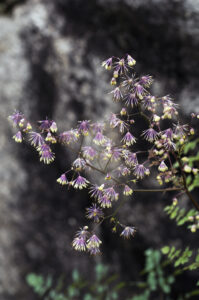
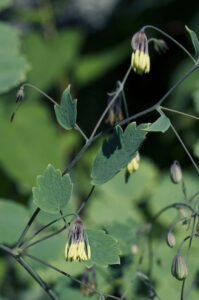
Inflorescences to 30 cm long, few-flowered, flower-stalk glandular-hairy, flowers large, to 3.5 cm across, petals 4, reddish-pink or mauve, anthers yellow. Flowering takes place July-October.
It is distributed from central Nepal eastwards to Bhutan and south-eastern Tibet, growing in forests and shrubberies at elevations between 2,800 and 3,700 m.
The specific name is Latin, meaning ‘shaped like a kidney’. This term is usually applied to plants, whose leaves are rounded, broader than long.
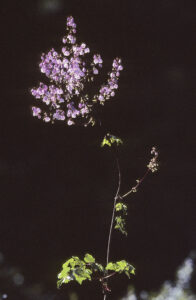

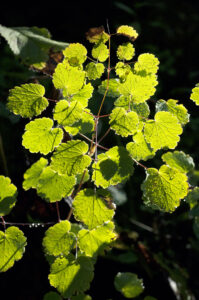
Stem to 65 cm long, branched or unbranched. Leaves simple, 3 together, broadly triangular, to 2.5 cm across, 3-lobed, lobes with rounded teeth. Flowers to 2 cm across, in terminal or axillary, few-flowered clusters, petals 4 or 5, white or pinkish, to 8 mm long and 4 mm broad, stamens only a little longer, white. It blooms June-August.
The specific name is derived from the Latin virga (‘staff’), alluding to the numerous straight stems.
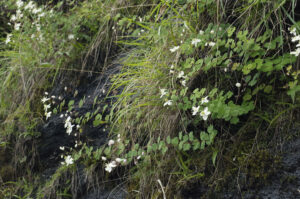
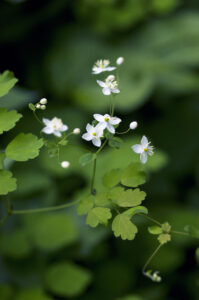
Many members of this family have a hypanthium, in which the basal portions of calyx, corolla, and stamens form a cup-shaped tube, also called floral cup.
Amygdaleae, genus Prunus (trees or shrubs, fruit a drupe).
Exocordeae, genus Prinsepia (shrubs, fruit a drupe).
Maleae, genera Cotoneaster, Pyracantha, Pyrus, and Sorbus (trees or shrubs, fruit a pome).
Neillieae, genus Neillia (shrubs, fruit hairy carpels, encircled by the persistent calyx).
Sorbarieae, genus Sorbaria (shrubs, fruit achenes or aggregated follicles).
Spiraeeae, genus Spiraea (shrubs, fruit a follicle).
About 40 species occur the Himalaya, of which up to 12 are evergreen, creeping, and mat-forming, all very similar and difficult to distinguish. The plants called C. microphyllus below are only tentatively identified to this species.
Most species have white flowers, some pink or red. The fruit is a pome, berry-like, with a swollen receptacle, enclosing 2-5 carpels.
The generic name is derived from the Latin cotonium, a corruption of cydonium malum, which means ‘the apple (or quince) from Kydonia’ (a town in Ancient Greece, situated on the northern coast of Crete, near present-day Chania), combined with the suffix aster (‘resembling’), thus ‘the fruit which resembles cotonium’.
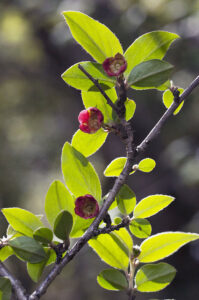
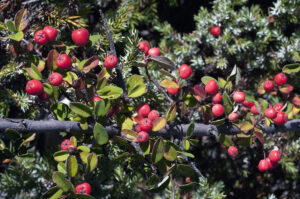
Inflorescences are dense clusters with up to 40 flowers, stalk densely hairy. Flowers to 7 mm across, hypanthium bell-shaped, woolly-hairy, sepals tiny, triangular, petals white, spreading, ovate or rounded, to 3.5 mm long, stamens slightly shorter than petals. Flowering takes place May-July. The fruit is scarlet, ellipsoid, to 5 mm long, ripening September-November.
It is distributed from Uttarakhand eastwards to Bhutan and south-eastern Tibet, found in open forests and shrubberies, and along streams, at elevations between 2,200 and 3,400 m. It is very common in Upper Langtang Valley, central Nepal.
In Nepal, the fruit is eaten to treat blood deficiency.
The specific name is Latin, meaning ‘growing in cold places’.
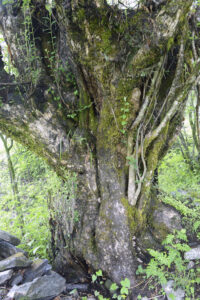
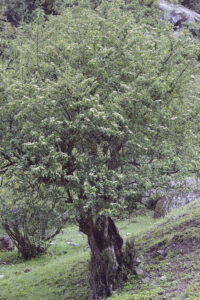

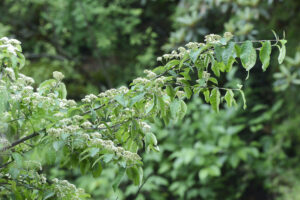
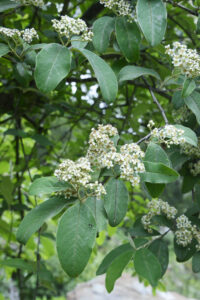
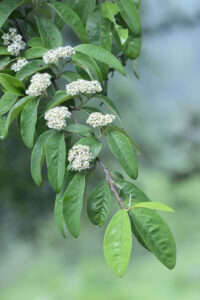
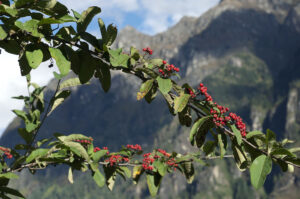
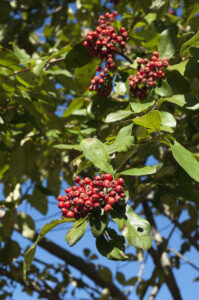
Flowers are axillary, solitary or 2-3 together, to 1 cm across, pinkish in bud, later white, hypanthium bell-shaped, hairy, sepals ovate-triangular, tiny, pointed, petals 5, spreading, rounded, to 4 mm across, stamens 15-20, shorter than petals. Flowering occurs April-June. The fruit is scarlet, globular, to 1 cm across, ripening July-October.
It is distributed from Afghanistan eastwards to Myanmar and south-western China, growing on rocks and in open areas at altitudes between 2,000 and 5,400 m.
In Nepal, it is planted to prevent soil erosion. Branches are used for fences, as fuel, and for basket-making. The leaves are burned as incense. Ripe fruits are edible, but tasteless.
The specific name is derived from Ancient Greek mikros (‘small’) and phyllon (‘leaf’).
The plants in the pictures below are only tentatively identified to this species.
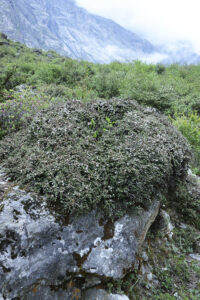
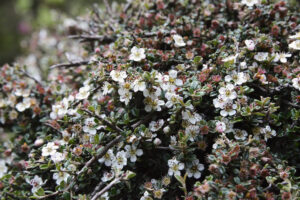

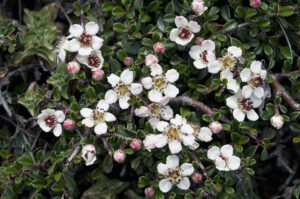
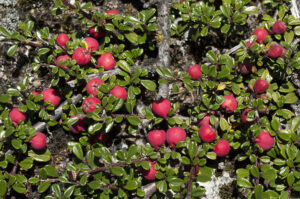
It grows on rocky slopes at elevations between 1,800 and 3,100 m, found from Afghanistan eastwards to Uttarakhand.
The specific name is Latin, meaning ‘rose-coloured’, referring to the flowers.
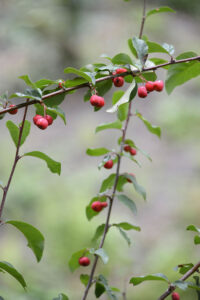
The generic name commemorates Scottish printer and naturalist Patrick Neill (1776-1851), founding member of the Wernerian Natural History Society and the Caledonian Horticultural Society. His work A Tour Through Some of the Islands of Orkney and Shetland (1806) caused much public debate due to its descriptions of the economic misery of the islanders.
A shrub to 2 m tall, branches slender, often pendent, reddish-purple, angular, hairy when young. Leaves to 10 cm long and 5 cm wide, blade broadly ovate to almost triangular, 3-lobed, base heart-shaped, smooth on both surfaces, margin coarsely toothed, tip long-pointed, nerves impressed on the upper surface.
Inflorescences are axillary or terminal clusters, to 5 cm long, with up to 12 short-stalked flowers, to 8 mm across, hypanthium cup-shaped, sepals triangular, hairy, petals reddish, pink, pinkish-white, or greenish-white, obovate, to 3 mm long. Flowering occurs June-August.
The specific name is Latin, meaning ‘with red flowers’.
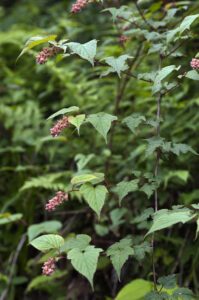
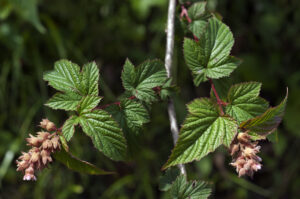
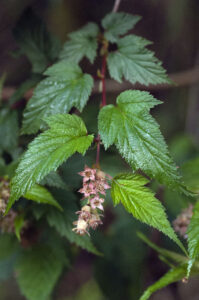
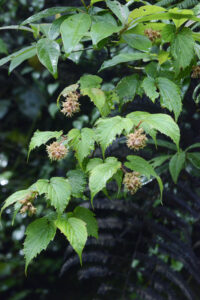
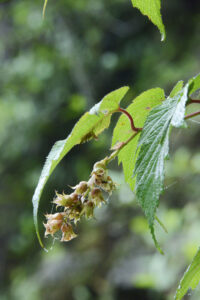
The fruit is a drupe, with a fleshy outer layer and an inner hard stone, enclosing the seed.
The generic name commemorates English scholar and orientalist James Prinsep (1799-1840), best remembered for deciphering the Kharosthi and Brahmi scripts of ancient India. He also studied many aspects of numismatics, metallurgy, and meteorology, and was the founding editor of the Journal of the Asiatic Society of Bengal.
Inflorescences are short racemes, to 6 cm long, in axils of spines, flowers short-stalked, to 1.5 cm across, hypanthium cup-shaped, with 5 unequal lobes, brown-downy, persistent in fruit. Petals white, rounded. They appear in the winter period, from October to May. The fruit is blue to blackish-purple, oblong-cylindric, to 1.7 cm long, ripening April-September.
It occurs from Pakistan eastwards to Myanmar and south-western China, growing in shrubberies and villages, on open slopes, and along trails, at elevations between 1,200 and 2,900 m.
In Nepal, oil from the seeds is applied for rheumatism and muscular pain, and to the forehead to relieve cough and colds. Heated oil cake is applied to the abdomen in case of stomach ache, and the oil cake is also used for washing clothes. The oil can be burned in lamps. This species is planted to prevent soil erosion, and to make fences. Goats browse on the leaves. A purple colour is obtained from the fruits, which is used for painting. Ripe fruits are edible.
The specific name is Latin, meaning ‘of much usage’. A suitable name!
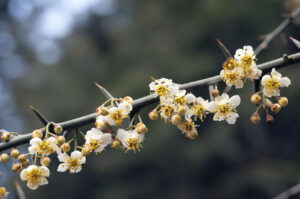
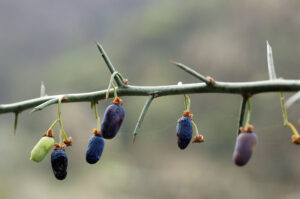
The fruit is a drupe, with a fleshy outer layer and an inner hard stone, enclosing the seed.
The generic name is a Latinized version of the Ancient Greek name of the plum tree, prounos.
Flowers are long-stalked, solitary or up to 4, terminal, appearing when the tree is without leaves, or with the young leaves. Sepals usually reddish, triangular, pointed, petals pink or whitish, ovate or obovate, spreading, to 1.5 cm long. It is flowering from September and through the winter. The drupe is yellow, red, or purplish-black, ovoid, smooth, to 1.6 cm long and 1.2 cm broad, ripening between March and May.
It is distributed from Pakistan eastwards along the Himalaya to northern Indochina, growing in forests and open areas at altitudes between 1,200 and 2,400 m.
This tree is often planted at villages, cultivated for the edible fruits, and as an ornamental. Fruits and leaves yield a dark green dye. The wood is hard and durable. In Nepal, the foliage is lopped for fodder. Walking sticks are made from the branches, necklaces and rosaries from the drupes. Juice of the bark is applied in case of backache.
The specific name is Latin, meaning ‘resembling Cerasus‘, an older generic name of cherry trees.
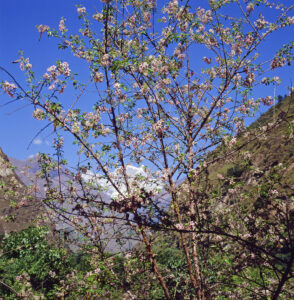
A medium-sized tree to 18 m tall, with rough grey-brown bark. Leaves oblong or lanceolate, to 15 cm long, margin with numerous fine teeth, tip long-pointed, nerves creating a net-like pattern.
Inflorescences are drooping clusters, to 15 cm long, with numerous flowers, to 1 cm across, calyx with blunt lobes, petals rounded, white. Flowering takes place April-May. The fruit is globular, to 8 mm in diameter, at first red, later dark purple or black, ripening August-October.
In Nepal, the foliage is lopped for fodder. Ripe fruits are eaten and also used to produce an alcoholic beverage.
The specific name is Latin, meaning ‘shaped like a horn’. The fruits of this species are often infected by insects, causing them to grow long and horn-like.
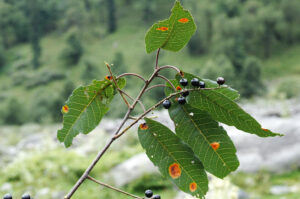
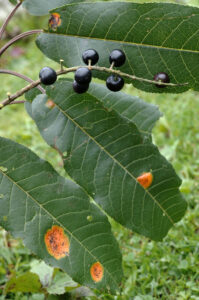
The fruit is a pome, with a swollen receptacle, enclosing 2-5 carpels.
The generic name is derived from Ancient Greek pyr (‘fire’) and akanthos (‘thorn’), alluding to the sharp thorns and the red fruits of these plants. Thus, the English name is a direct translation of the Latin name.
The many-flowered inflorescences are axillary clusters, to 5 cm across, arranged along the branches, flower-stalk to 1 cm long, flowers to 9 mm across, hypanthium bell-shaped, hairless, sepals triangular, tiny, petals rounded, white, to 5 mm across. It flowers between March and May. The fruit is globular, scarlet or orange-red, to 8 mm across, ripening August-November. The nuts are protruding from the persistent calyx.
It is distributed from Kashmir eastwards to northern Myanmar and south-western China, found at elevations between 1,000 and 2,500 m. Habitats include shrubberies, open slopes, and along trails.
In Nepal, it is planted as a hedge, and walking sticks are made from the wood. Ripe fruits are edible. Powdered fruits are used for blood dysentery.
In a botanical context, crenulate means ‘with small, rounded teeth’, derived from the Latin crenula, a diminutive of crena (‘incision’), referring to the leaves.

The fruit is a pome, with a swollen receptacle, enclosing 2-5 carpels.
The generic name is derived from pirus, the classical Latin word for pear.
The branches are often spiny. Leaf-stalk to 3 cm, leaves ovate, sometimes 3-5-lobed, to 10 cm long and 5 cm broad, long-pointed, toothed, downy when young, later hairless, shining.
Inflorescences are umbel-like, with 7-13 flowers, stalk to 3 cm long, flowers to 5 cm across, sepals triangular, to 6 mm long, downy, petals white with darker veins, obovate, to 1 cm long and 6 mm broad. Flowering takes place March-April. The fruit is globular, to 1.5 cm across, at first brownish-green, later brown, with white dots and raised lenticels, flesh with gritty cells. It ripens August-October.
Over-ripe fruits are edible. They are often eaten by birds. In Nepal, the foliage is lopped for fodder, and the wood is used for making walking sticks and small tools, and as fuel. Juice of the fruit is taken for diarrhoea. This juice is also dripped into the eyes of livestock suffering from inflammation of the eyelids.
The specific name is derived from a local Nepalese name for this tree.
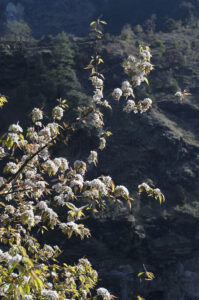
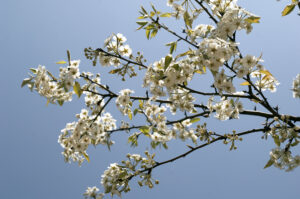
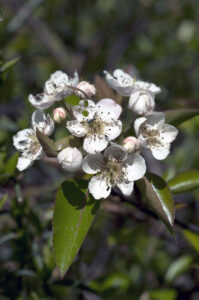
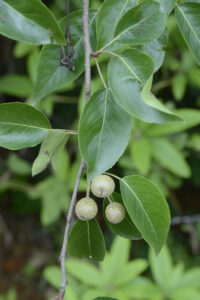
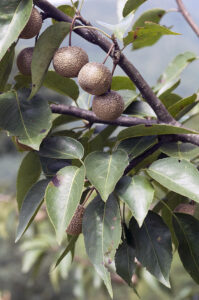
These plants resemble the well-known genus Spiraea (below), but the leaves are pinnate. The fruit is dry, with 5 carpels.
The generic name is Latin, meaning ‘resembling Sorbus‘ (whitebeams, below), presumably alluding to the pinnate leaves.
Inflorescences are very large, many-flowered, branched, terminal clusters, to 45 cm long, flowers to 7 mm across, petals rounded, white. They appear between May and August. Carpels 5, hairless, many-seeded.
It is native to western Central Asia, found from Uzbekistan and Kyrgyzstan southwards to Afghanistan and north-western Himalaya, eastwards to central Nepal. In the Himalaya, it grows in open forests and shrubberies, and along streams and trails, found at elevations between 1,800 and 2,900 m. It is common in the Great Himalayan National Park, Himachal Pradesh.
In Nepal, juice of the seeds is used to treat liver ailment.
The specific name is Latin, meaning ‘very hairy’. It is not clear what it refers to.
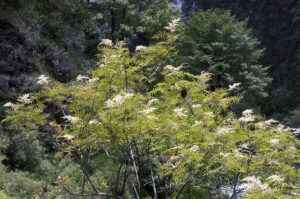
Leaves are pinnate, lobed, or simple. Flower clusters compound, fruit a pome, with a swollen receptacle, enclosing 2-5 carpels.
The name whitebeam is from Middle English witbeam (‘white tree’), alluding to the colour of the hairs on the underside of the leaves of some species. The alternative name mountain-ash refers to the leaves of some species, whose leaves resemble those of the common ash (Fraxinus excelsior).
The generic name is the classical Latin word for whitebeams, rooted in the Indo-European sor (‘red’), alluding to the fruit colour of most species.
A large deciduous tree, to 25 m tall. Branches purple when young, greyish-brown when older. Leaves simple, short-stalked, stipules brownish, lanceolate, to 1.2 cm long, blade elliptic, to 22 cm long and 12 cm wide, green and shining above, white-woolly below, lateral veins 10-15 pairs, margin unevenly toothed, sometimes lobed, tip pointed.
The inflorescences, each with 30-45 flowers, are up to 10 cm long and across, stalk initially white-woolly, later almost smooth. Flowers to 1.3 cm across, sepals triangular or lanceolate, to 3 mm long and broad, petals white, obovate, to 8 mm long and 6 mm wide. Flowering takes place May-July. The fruit is almost globular, red, to 1.5 cm across, ripening August-September.
Ripe fruits are edible.
The specific name is Latin, meaning ‘pointed’, referring to the leaf shape.
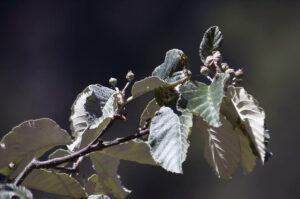
Inflorescences are terminal, lax, few-flowered clusters, to 6 cm long, flowers to 1 cm across, hypanthium purplish-black, broadly bell-shaped, to 3 mm long, hairless, sepals triangular, to 2 mm long, petals rounded, to 4 mm long, pink or white. Blooming time is May-June. The fruit is bluish-white or white, sometimes flushed pink or crimson, globular or ovoid, to 1 cm across, ripening September-October.
It is found at elevations between 3,000 and 4,200 m, from Himachal Pradesh eastwards to northern Myanmar and south-western China. Habitats include forests, shrubberies, and open areas.
In Nepal, the foliage is lopped for fodder.
The specific name is Ancient Greek, meaning ‘small-leaved’, alluding to the pinnately divided leaves.
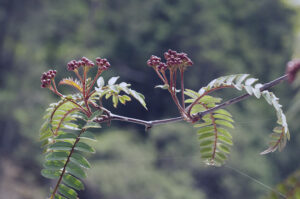
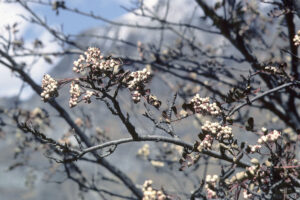
Twigs are brownish or greyish-brown, leaves pinnately divided, short-stalked, to 18 cm long, stipules broadly ovate or rounded, to 1.2 cm long, cleft or toothed, 9-15 pairs of leaflets, dark green above, paler below, linear or narrowly lanceolate, to 5 cm long and 1.5 cm wide, on the underside with rusty-brown hairs along the midvein, base rounded, margin with short, sharp teeth, tip with a short point.
Inflorescences are terminal, many-flowered, to 10 cm long and across, rachis and flower-stalks densely covered in rusty-brown hairs, flowers to 8 mm in diameter, sepals greenish or reddish, triangular, to 1.5 mm long, smooth, petals rounded, obovate, or rhombic, to 3 mm long and 2 mm broad, white or pale pink. It flowers from May to July. The fruit is globular, pink or red, to 8 mm across, ripening September-October.
In Nepal, a paste of the leaves is applied to boils.
The specific name is Latin, meaning ‘relating to bears’, presumably referring to the dense layer of reddish-brown hairs on the flower-stalk, which somewhat resembles a bear’s fur.
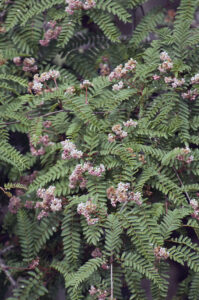
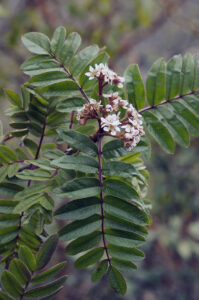
Leaves are simple. Carpels 5, free or fused at the base. The fruit is a follicle.
The generic name is derived from Ancient Greek speira (‘spiral’), alluding to the spirally arranged inflorescences of some species (see 3rd picture below).
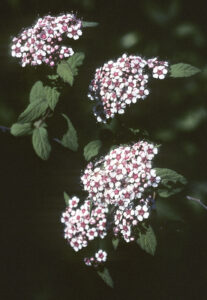
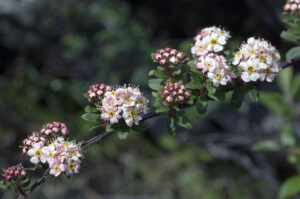
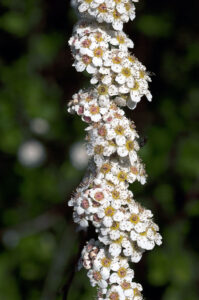
Inflorescences are domed clusters of white, cream-coloured, or dark pink flowers, to 8 mm across, sepals triangular, petals rounded. Flowering takes place May-July. The ripe carpels are exposed, shining.
It occurs from Himachal Pradesh eastwards to Myanmar and the Yunnan Province, growing in shrubberies and open areas at altitudes between 3,000 and 4,900 m. It is common in upper, drier valleys of Nepal.
The specific name is Latin, meaning ‘arched’, referring to the arched branches.
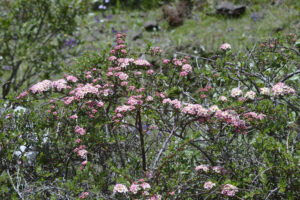
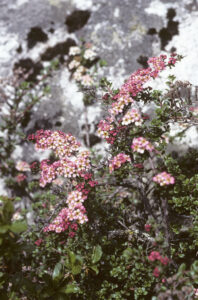
It is a deciduous shrub, to 2 m tall, branches erect or ascending, yellow-brown to red-brown, leaves ovate or ovate-lanceolate, to 4 cm long and 2 cm wide, base rounded, margin toothed, tip pointed.
Inflorescences are terminal or axillary, many-flowered, to 4 cm long and across, flowers to 7 mm in diameter, sepals triangular-ovate, to 2.5 mm long and across, petals rounded or oblong, pink, rarely white. Flowering occurs May-July.
In Nepal, the plant is used as fodder for goats and sheep.
The specific name is Latin, meaning ‘beautiful’.
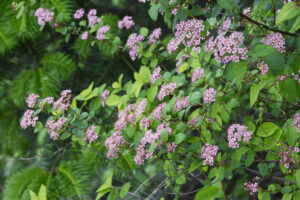
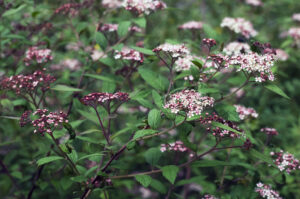
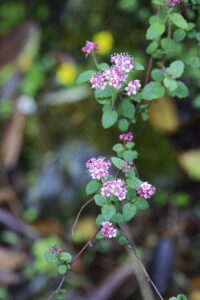
Inflorescences are long, dense, many-flowered, terminal clusters on short side branches, flowers to 6 mm across, sepals triangular, to 2.5 mm long, petals rounded, to 3.5 mm long, white. Flowering takes place between May and August. Ripe carpels are long-haired, partly enclosed by the calyx-tube.
It is distributed from Pakistan eastwards to Myanmar and south-western China, growing at elevations between 1,500 and 4,000 m. Habitats include shrubberies, streamsides, and open slopes.
In Nepal, the plant is used as fodder for goats and sheep.
The specific name is Latin, meaning ‘becoming grey’. What it refers to is not clear.
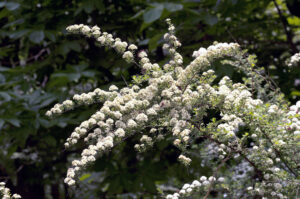
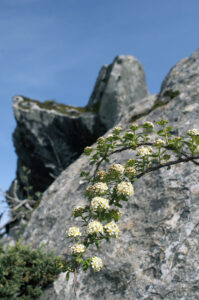
The generic name stems from Argemone, derived from Ancient Greek argemos, meaning ‘a white spot on the eye’ (cataract), which a species of Argemone (Papaveraceae), according to the Ancient Greeks, was able to cure. Despite their medicinal properties, agrimonies are not known to cure eye diseases, so why the generic name was applied to them is uncertain.
A common name of these plants, church steeples, refers to the long, spire-like inflorescence, whereas cocklebur and sticklewort allude to the prickly fruits, which easily detach when in contact with socks, sweaters, animal furs, etc.
Stem to 1.5 m tall, unbranched, hairy below. Stipules large, sickle-shaped, margin sharply toothed, leaves hairy, gradually smaller up the stem, pinnately divided with 3-4 pairs of very unequal leaflets, larger ones lanceolate or elliptic, toothed, to 5 cm long and 2.5 cm broad, alternating with much smaller ones.
Flowers to 9 mm across, in a terminal, slender, spike-like cluster, calyx tube to 8 mm long, grooved, bristly-hairy, petals yellow. In the Himalaya, flowering occurs May-October. The fruit is very distinctive, top-shaped, 10-ribbed, to 8 mm long and 4 mm broad, with a crown of hooked prickles. It ripens October-December.
In Nepal, this species is used for a large number of ailments, including stomach ache, diarrhoea, dysentery, haemorrhoids, tuberculosis, headache, and peptic ulcer. A decoction of the plant is applied to treat snakebite.
The specific name is Latin, meaning ‘hairy’.
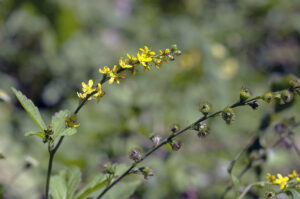
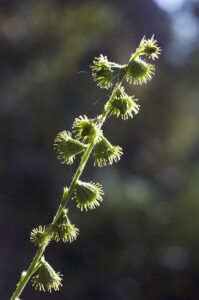
The generic name is derived from Ancient Greek dasys (‘hairy’) and phoros (‘bearing’), alluding to the hairy hypanthium.
A prostrate plant, stem woody, bark reddish-brown, peeling off, branches creeping or ascending, to 15 cm long. Leaves are in fact pinnate, with 5-7 pinnae, but this is hard to see, leaflets crowded, to 6 mm long and 3 mm wide, ovate-elliptic, silky-hairy, tip pointed. Flowers solitary, to 1.7 cm across, petals rounded, yellow, to 8 mm long. They appear June-August.
Plants formerly known as D. fruticosa var. pumila, or Potentilla fruticosa var. pumila, are now included in this species.
The specific name is derived from the genus name Dryas, and Ancient Greek anthos (‘flower’), combined with the suffix oides (‘resembling’), thus ‘resembling flowers of Dryas‘. This genus, likewise in Rosaceae, is presented on the page Plants: Flora of the Alps and the Pyrenees.
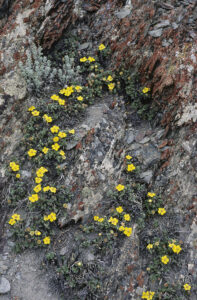
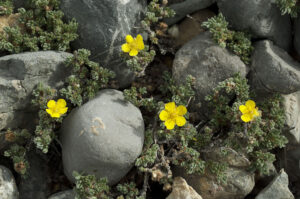
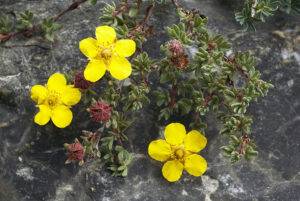
It is widely distributed in the northern temperate and subarctic zones, southwards to Arizona, the Mediterranean, Turkey, the Himalaya, and China. In the Himalaya, it grows in grasslands, open areas, and shrubberies at elevations between 2,400 and 5,000 m.
In the West, this species is very commonly cultivated as an ornamental. In Nepal, juice of the root is used for indigestion. The leaves can be used as a substitute for tea. Dried leaves and branches are burned as incense.
The formerly accepted variety pumila of Central Asia is today included in D. dryadanthoides (above).
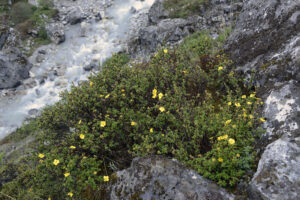
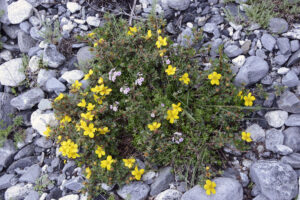
Inflorescences are terminal or axillary clusters, flowers to 3 cm across, stalk densely hairy, farinose, to 3 cm long, bracts reddish-brown, linear-lanceolate, to 2 cm long, tip pointed, sepals pale green, reddish, or purple, triangular-ovate, to 1.5 cm long, tip long-pointed, alternating with the white or red, obovate petals, to 1.5 cm long, tip rounded. Flowering takes place June-August. The fruit is a cluster of numerous achenes.
It is distributed from Kazakhstan and Kyrgyzstan southwards to northern Pakistan, Ladakh, and northern Himachal Pradesh, eastwards across Xinjiang and Qinghai to Inner Mongolia, growing in dry rocky areas at altitudes between 3,200 and 4,200 m.
The generic name alludes to the many farinose parts of the plant. The specific name probably refers to a Russian colonel, P. Salesov, who conducted surveys of roads in Russian occupied Turkestan in the 1860s. I have not been able to find any other information about him.
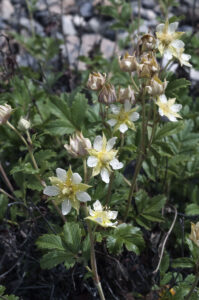
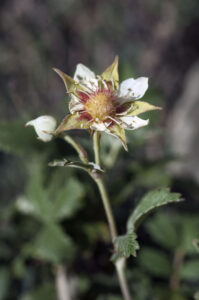
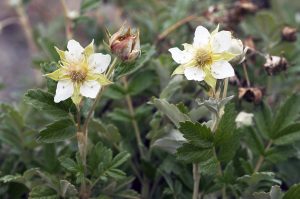
The generic name is derived from the Latin filum (‘thread’), pendera (‘to hang’), and ula, a diminutive suffix, thus ‘hanging in thin threads’, alluding to numerous tiny tubers on the root, connected by thin threads.
The popular name refers to the fragrant flowers of this genus.
Stem erect, leafy, to 1.5 m tall, clad in fine brown hairs above. Leaves to 30 cm long, pinnately divided with 3-5 pairs of lateral lobes, very unequal, often tiny, terminal lobe much larger, to 10 cm long, with 3-5 ovate lobes, pointed, margin deeply toothed.
The inflorescence is a terminal, much-branched cluster with numerous cream-coloured, tiny flowers, to 6 mm across, stalks densely hairy, petals elliptic, longer than the sepals. Blooming occurs May-August. The fruit has 5-15 free carpels, style curved.
The specific name is Latin, meaning ‘clad in’ (hairs), probably alluding to the densely downy stalks in the inflorescence.
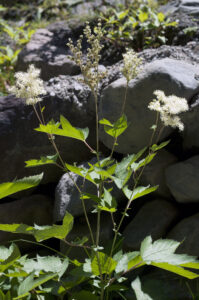
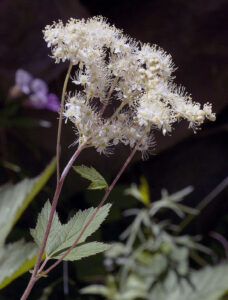
Leaves are trifoliate, strongly toothed. Stems are rooting at nodes. The fruit is highly distinctive, receptacle swollen, fleshy, red, with tiny dry carpels on the surface.
The generic name is the classical Latin word for strawberry. The English name is derived from the verb to strew, in allusion to the dense tangle of the plant’s stems, creeping over the ground.
The role of strawberry in folklore and traditional medicine is described on the page Plants: Plants in folklore and poetry.
It is found from Uttarakhand eastwards to Myanmar and south-eastern Tibet, growing in forests and shrubberies, and on shady banks, at elevations between 2,000 and 3,600 m.
The fruit is edible, but not very tasty. In Nepal, juice of the root is given in case of fever.
The specific name honours British botanist Joseph Dalton Hooker (see below).
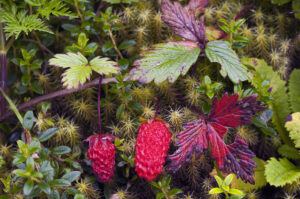
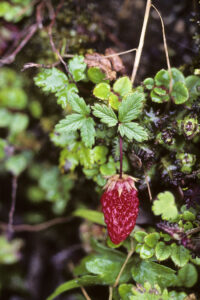
The same year, he was appointed assistant surgeon on board HMS Erebus, which, together with HMS Terror, departed on a 4-year-long expedition to Antarctica, Tasmania, and New Zealand. He had ample time to pursue his interest in botany, and his collections from the voyage were later described in Flora Antarctica (1844-47), Flora Novae-Zelandiae (1851-53), and Flora Tasmaniae (1853-59).
In 1846, he was appointed botanist to the Geological Survey of Great Britain, working on palaeobotany, searching for fossil plants in the coal-beds of Wales.
From 1847, he spent 4 years in India, mainly collecting plants for the Kew Gardens. On this journey, he described numerous plants new to science, including no less than 22 rhododendron species from Sikkim and other parts of the eastern Himalaya. In Sikkim, he and his companion, British physician Archibald Campbell (1805-1874) of the Bengal Medical Service, were held prisoners by Tsugphud Namgyal, the local ruler. This incident led to the British annexation of the Sikkim lowlands.
Publications from the stay in India include The Rhododendrons of Sikkim-Himalaya (1849-51), the series Flora Indica (from 1855), together with Thomas Thomson (1817-1878), a fellow student from Glasgow University, and The Flora of British India, published in 7 volumes (1872-1897).
Hooker also undertook other journeys, to Palestine in 1860, to Morocco in 1871, and to the western United States in 1877.
In 1855, he was appointed assistant-director of the Kew Gardens, and in 1865 he succeeded his father as full director, holding the post for 20 years. He was a close friend of the famous Charles Darwin (1809-1882).


Flowering stems erect, silky-hairy, to 20 cm long, flowers long-stalked, solitary or up to 3 together, to 2.5 cm across, sepals and epicalyx with 5 alternating lobes, lanceolate, entire, pointed, petals white, obovate, tip rounded. Blooming occurs April-August. The fruit is red, rounded, to 1 cm across, ripening June-October.
It is distributed from Afghanistan eastwards to Myanmar and south-eastern Tibet, growing in forests and shrubberies, and on open slopes, at altitudes between 1,600 and 4,000 m.
The fruit is edible, but not very tasty. In Nepal, juice of the plant is given to curb profuse menstruation. Unripe fruits are chewed for blemishes on the tongue.
The specific name is derived from the Latin nubis (‘cloud’ or ‘sky’) and colo (‘to inhabit’). Presumably, the type specimen was collected at a high altitude.
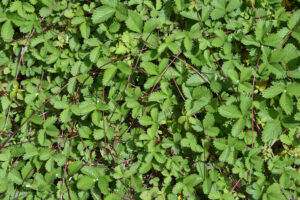
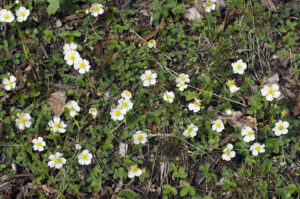
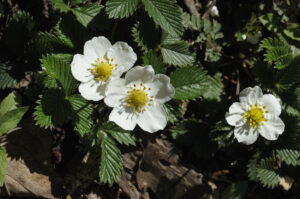
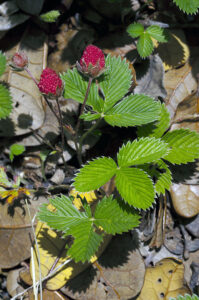
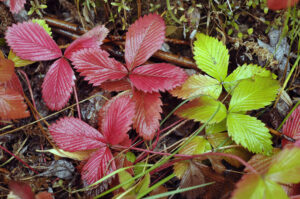
Most species have yellow flowers, some red, orange, or white. A gorgeous species with orange flowers is shown on the page Travel episodes – Chile 2011: The white forest.
At maturity, the fruits of some species are hooked at the apex, an adaptation to seed dispersal. In other species, a silky tuft of brownish hairs grows from the styles, which has given rise to a popular German name of these plants, Petersbart (‘Peter’s beard’), probably referring to St. Peter.
The generic name is the classical Latin name for avens. The English name is derived from the Latin avencia, which was the name of a kind of clover. Why it was applied to these plants is not known.
Flowering stems erect, to 50 cm tall, basal leaves to 30 cm long, pinnately divided, lobes large, paired, rounded, saw-toothed, alternating with much small ones, margin hairy, terminal lobe much larger, with 3-5 toothed lobes. Stem leaves few, very small.
Inflorescences are terminal, few-flowered clusters of erect or nodding flowers, corolla to 4 cm across, calyx-lobes short, triangular, green above, purple below, petals 5, usually yellow, sometimes red, rounded. Blooming occurs June-August. The fruit is a globular cluster of hairy achenes.
In Nepal, pounded leaves are applied to wounds.
The specific name is Latin, meaning ‘tall’.
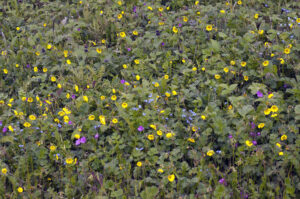
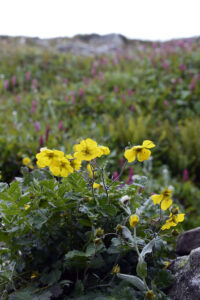
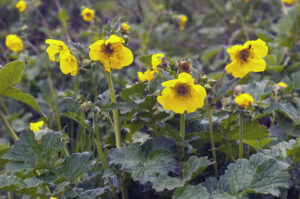
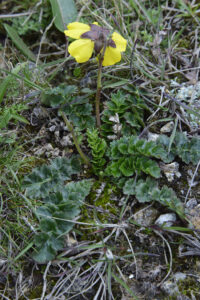

It is distributed from Afghanistan eastwards to central Nepal, found in forests and shrubberies at altitudes between 1,800 and 3,600 m.
The specific name was given in honour of British surgeon and naturalist John Forbes Royle (1798-1858), who is chiefly known for his works Illustrations of the Botany and other branches of Natural History of the Himalayan Mountains, and Flora of Cashmere.
European botanists will notice that this plant is very similar to the wood avens (G. urbanum) of Europe.
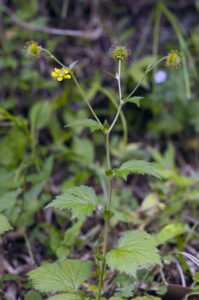
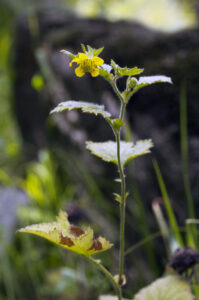
There are usually 5 petals and sepals, the sepals alternating with 5 epicalyx-lobes. The fruit is a globular head of dry carpels, each with a single nutlet.
The generic name is derived from the Latin potens (‘strong’ or ‘powerful’) and illa, a diminutive suffix. It alludes to the alleged powerful tonic and astringent properties of these plants.
The popular name is an Anglicization of the Latin quinque (‘five’) and folium (‘leaf’), thus ‘five-leaf’ – a name, which was originally referring to those species of the genus, which have 5 finger-like leaflets. Today, however, the name refers to the entire genus.
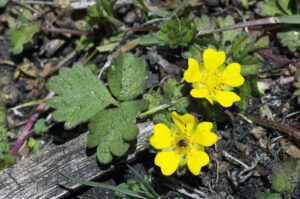
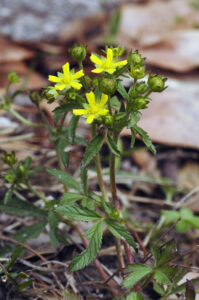
Stems slender, creeping, often reddish, sparsely hairy, rooting at the nodes. Basal leaves in a rosette, with a stalk to 20 cm long, pinnately divided, leaflets 5-11 pairs, ovate or elliptic, saw-toothed, densely silvery-hairy beneath, to 2 cm long and 1 cm broad, alternating with tiny leaflets. Stipules large, rounded. Flowers solitary, axillary, long-stalked, to 2.5 cm across, stalk to 8 cm, petals 5, yellow, obovate, tip blunt. Flowering occurs June-August. Achenes are hairy.
The specific name is derived from the Latin ‘relating to Anser’ (geese), like one of the common names presumably alluding to geese eating the leaves. The other common name refers to the leaves being silvery-hairy beneath.
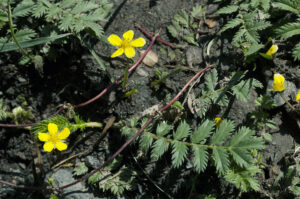
Inflorescences are terminal, stalked, with 2-3 flowers. Sepals and epicalyx-lobes almost similar, triangular-lanceolate or elliptic-ovate, silvery-hairy, corolla to 4 cm across, petals 5, obcordate, colour varying from yellow, orange, or blood-red to purple, stamens yellow or purple. Flowering takes place between May and August.
It is distributed from Afghanistan eastwards to Sikkim and south-eastern Tibet, growing in shrubberies and meadows, and on open slopes, at elevations between 2,300 and 4,600 m.
In Nepal, a paste of the root is applied in case of toothache.
The specific name is derived from Ancient Greek argyros (‘silver’) and phyllon (‘leaf’), alluding to the silvery-hairy leaves.
Plants with blood-red flowers were previously regarded as a separate species, P. atrosanguinea.
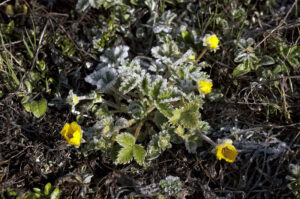
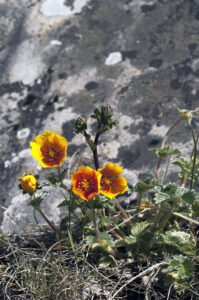

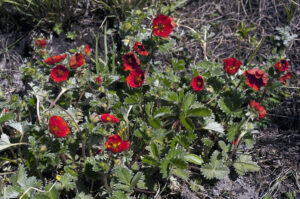
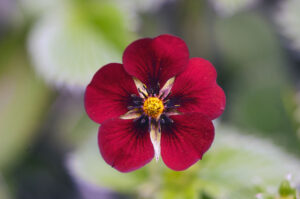
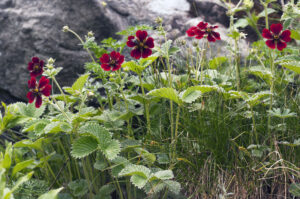
Stems several, creeping, ascending, or sometimes erect, to 15 cm long/tall, basal leaves to 16 cm long, including stalk, blade with 2-8 pairs of opposite, broadly ovate leaflets, twice pinnately divided, looking much like leaves of coriander (Coriandrum sativum, Apiaceae), reflected in the specific name. Stem leaves 1 or 2, similar.
Inflorescences are terminal, flowers solitary or up to 3 together, to 1.5 cm across, sepals and epicalyx similar, triangular-ovate, pointed, hairy, petals white, purplish-red at the base, obovate, notched. Flowering occurs July-September.
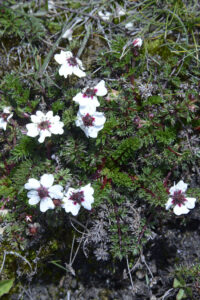
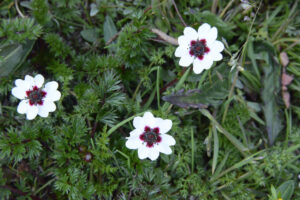
Inflorescences are terminal, flowers solitary or 2 together, to 2.5 cm across, sepals pale green, triangular, pointed, epicalyx-lobes dark green, oblong-elliptic, blunt. Petals 5, broadly obovate, yellow, slightly longer than sepals. It blooms June-September. Achenes are numerous, covered in silky hairs.
It is distributed from Kashmir eastwards to Bhutan and south-western China, growing at altitudes between 2,400 and 4,900 m. Habitats include meadows, rocks, and forest edges.
The specific name is Latin, meaning ‘wedge-shaped’, alluding to the leaflets.
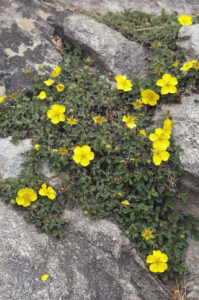
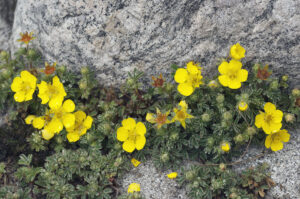
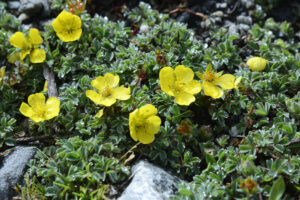
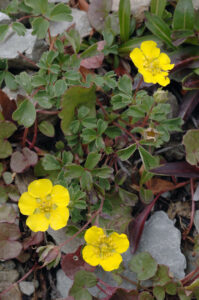
Stem erect or ascending, to 12 cm tall, downy or almost smooth, basal leaves to 7 cm long, including stalk, blade trifoliate, leaflets obovate, elliptic, or rhombic, white-woolly or sometimes almost smooth on both sides, base wedge-shaped, margin entire on inner half, with 5-7 toothed lobes on outer half, teeth ovate or elliptic, tip pointed or sometimes blunt, stem leaves similar, but much smaller, sessile.
Inflorescences are terminal, flowers solitary or up to 3 together, to 2.5 cm in diameter, sepals triangular-ovate, tip pointed, epicalyx segments oblong or elliptic, largely similar to sepals. Petals yellow, broadly obovate. Flowering takes place May-September. Carpels are densely hairy.
The specific name is derived from Ancient Greek erion (‘wool’) and karpos (‘fruit’), alluding to the hairy carpels.
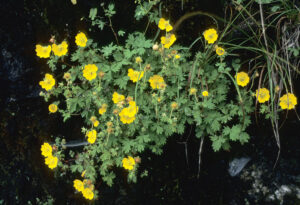
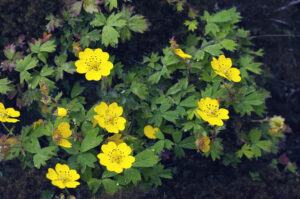
Flowers are solitary, axillary, to 2.5 cm across, stalk long, hairy, sepals ovate, hairy, long-pointed, epicalyx-lobes obovate, margin with 3-5 teeth, tip blunt, petals 5, yellow, rounded. Blooming occurs April-August. The fruit is red, strawberry-like, but dry and tasteless, to 2 cm across, ripening May-October.
It is widely distributed in open areas, including grassy slopes and along trails, from Afghanistan eastwards to northern China, Korea, and Japan, southwards to Sri Lanka, Indonesia, and the Philippines. In the Himalaya, it grows at altitudes between 500 and 3,100 m.
In India, the plant is used for fever and infections, and as an anti-coagulant.
The obsolete generic name refers to French botanist and horticulturist Antoine Nicolas Duchesne (1747-1827), professor at Versailles. He was the first botanist to describe strawberries, and he published two works, Histoire naturelle des Fraisiers (1766) and Sur la formation des jardins (1775).
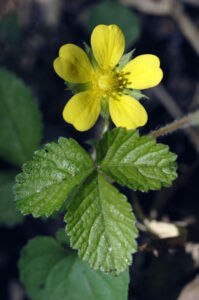
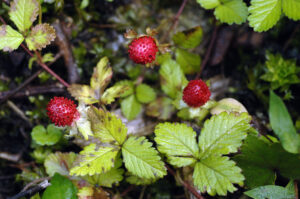
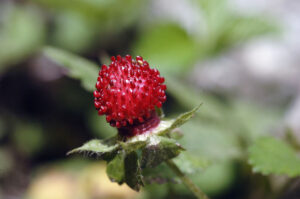
Inflorescences are terminal or axillary, with few long-stalked flowers, to 1.5 cm across, margin of sepals and epicalyx usually entire, petals obovate or rounded, yellow. Flowering occurs June-August.
It is distributed from Himachal Pradesh eastwards to northern Indochina and south-western China, growing in open forests and shrubberies, and on grassy slopes, at elevations between 1,200 and 4,800 m.
The plant is of widespread medicinal usage in India. In Nepal, the juice is used for cough, colds, and stomach problems. The powdered root is kept in the mouth in case of toothache. Juice of the root is taken for peptic ulcer, and to expel intestinal worms.
It is not clear what the specific name refers to.
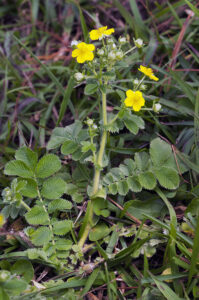
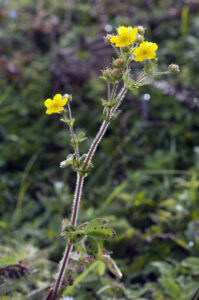
A densely tufted or mat-forming plant, stems erect, to 5 cm tall, downy. Leaves densely pinnate, basal leaves with stalk to 6 cm long, leaflets 2-9 pairs, packed densely together, pointing forward and twisted upwards, ovate, elliptic, or oblong, silky-hairy beneath, to 4 mm long and 2.5 mm broad, margin densely lobed. Stem leaves usually absent, but if present small, with entire margin. Flowers solitary, to 3 cm across, petals 5, rounded to obovate, yellow, much longer than the triangular, pointed sepals. Blooming takes place June-August.
The specific name is derived from Ancient Greek mikros (‘small’) and phyllon (‘leaf’).
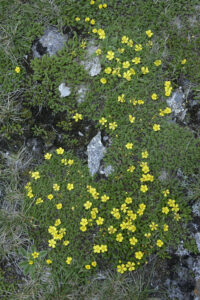
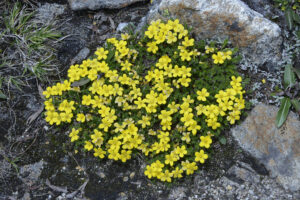
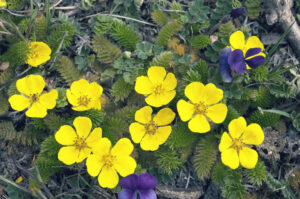
It looks like a larger edition of P. microphylla, stems erect, downy, to 35 cm tall, leaves pinnate, basal leaves with stalk to 25 cm long, leaflets 10-21 pairs, overlapping, mostly oblong, toothed, densely silky-hairy beneath, hairy or hairless above, to 3 cm long and 1.5 cm broad, stem leaves much smaller.
Inflorescences are few-flowered, flowers to 3.5 cm across, stalk to 5 cm long, sepals triangular-ovate, silky-hairy, epicalyx oblong, margin entire or 2-4-lobed, petals 5, elliptic to obovate, longer than sepals, yellow. It blooms June-September. Achenes are dark brown or blackish, to 2 mm across, forming what looks like a fruit of bramble (Rubus fruticosus) (see photo below). They ripen August-November.
In Nepal, a paste of the root is given to curb profuse menstruation. Leaf buds are boiled, and the water used for bathing in case of fever.
The specific name is Latin, literally meaning ‘pertaining to the foot’, but in a botanical context alluding to a long stalk, in this case the flowering stem.
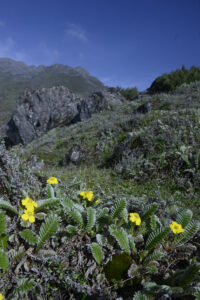
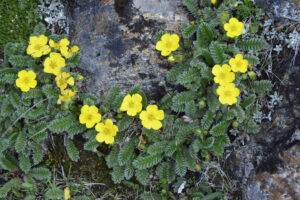
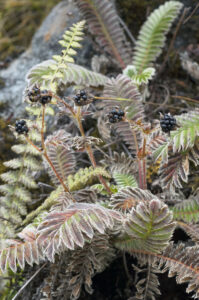
The fruit, called a hip, is highly distinctive, globular, elliptic, ovoid, or flask-shaped, with numerous carpels clustered inside the fleshy receptacle, each with 1 nutlet. The calyx is often persistent.
These plants are widely distributed in temperate and subtropical regions of the Northern Hemisphere, with a few tropical species in eastern Africa and southern and south-eastern Asia. 4 wild species occur in the Himalaya, and several others are cultivated as ornamentals.
The generic name is the classical Latin name of these plants, derived from Ancient Greek rhodon (‘rose’), probably of Persian origin.
The flower-stalk is glandular, flowers fragrant, many in terminal clusters, each to 5 cm across, petals 5, obovate, white, sepals 5, lanceolate, long-pointed, downy, often with a few lobes. Flowering occurs April-June. The hip is globular or ovoid, purplish-brown or dark red, to 1.5 cm across, hairless, shining, calyx soon falling. It ripens June-November.
It grows in forests and shrubberies at elevations between 1,200 and 2,800 m, from Pakistan eastwards to Myanmar and south-western China.
The fruit is edible.
The specific name commemorates Scottish botanist Robert Brown (see Delphinium brunonianum above).
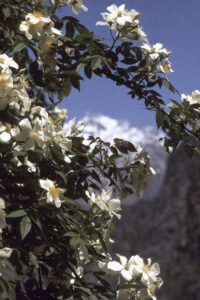
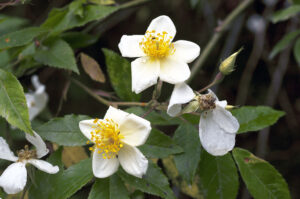
Stems erect, robust, to 5 m long, dark red or purple, prickles few, straight, mostly in pairs below leaves. Leaf-stalk downy, sparsely glandular-hairy, sometimes prickly, leaves pinnate, to 20 cm long including stalk, leaflets 7-11, oblong or elliptic-obovate, pointed, toothed, hairy and glandular beneath, to 6 cm long. Stipules ovate, usually hairless, margin glandular, toothed.
Flowers are solitary or 2-3 together, to 7 cm across, sepals 5, ovate-lanceolate, long-pointed, to 5 cm long, with leafy tip, petals 5, obcordate, pink or red. Blooming takes place June-July. The hip is flask-shaped, usually red, sometimes purplish-red, to 5 cm long, bristly-hairy, shining, calyx persistent, erect. The ripening period is from August to November.
This species is often planted as a hedge. The fruit is edible. In Nepal, a paste of the fruit is eaten, as it is believed that this will improve the eyesight. The foliage is lopped for fodder.
The specific name is derived from Ancient Greek makros (‘long’ or ‘large’) and phyllon (‘leaf’).
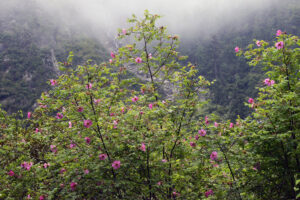
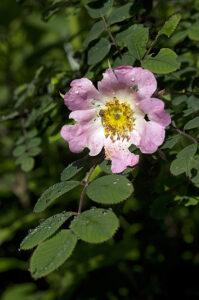
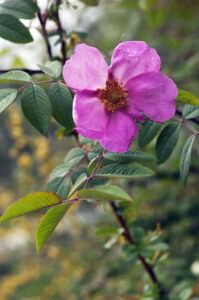
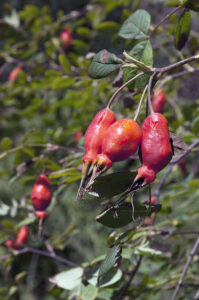
The flower-stalk is smooth, flowers solitary, axillary, white or cream-coloured, to 6 cm across, sepals 4, elliptic, long-pointed, margin entire, petals 4, obovate or obcordate. Flowering takes place between May and August. The hip is globular or pear-shaped, bright red, orange-red, or sometimes purplish-brown, to 1.5 cm across, hairless, calyx persistent, erect. It ripens July-September.
This species is found at altitudes between 1,700 and 4,600 m, from Himachal Pradesh eastwards to Myanmar and south-western China. It grows in shrubberies and open areas.
In Nepal, it is often planted as a hedge, and domestic animals feed on the leaves. The fruit is edible. A paste of the flowers is applied in case of headache, and also taken for liver problems.
The specific name is derived from Ancient Greek serikos (‘silky’). What it refers to is not obvious.

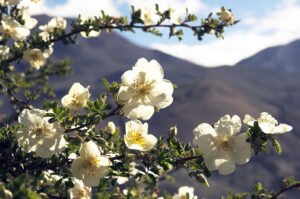
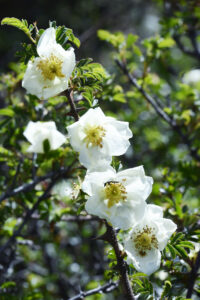
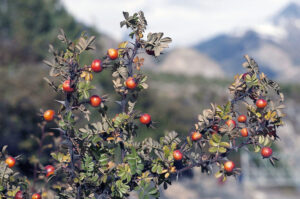
An erect shrub to 3 m tall, stems slender, purplish-brown. Prickles scattered, straight, stout, yellow, often in pairs beneath the leaves. Leaf-stalk hairless, with a few small prickles, leaves pinnate, to 4 cm long including stalk, often turning pinkish, leaflets 5-9, rounded, toothed near the tip, to 2 cm long and 1.2 cm broad, tip blunt. Stipules ovate, pointed, margin glandular.
Flowers numerous, to 7 cm across, sepals 5, triangular-lanceolate, long-pointed, glandular, petals 5, broadly obovate, pink or reddish. They appear from June to August. The hip is globular, ovoid, or flask-shaped, bright red, to 3.5 cm long, calyx persistent, spreading. Ripening period is July-September.
The fruit is edible.
The specific name was given in honour of English botanist Philip Barker Webb (1793-1854), who collected plants in Italy, Spain, Portugal, Morocco, the Canary Islands, and Brazil.
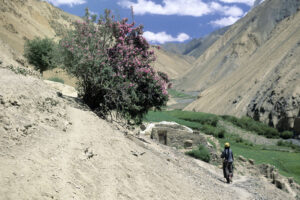
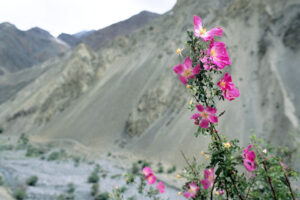
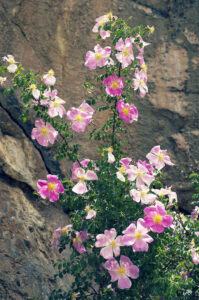
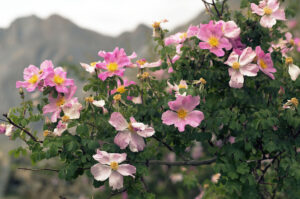
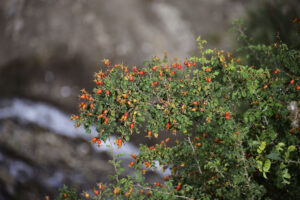
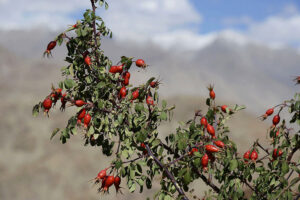
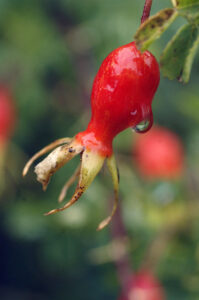
The fruit is highly distinctive, a globular head on the domed tip of the flower-stalk, consisting of fleshy carpels, usually with many nutlets.
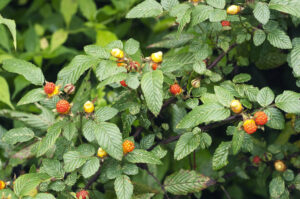
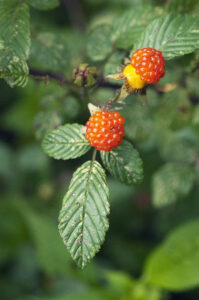
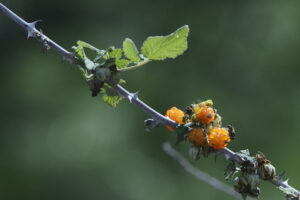
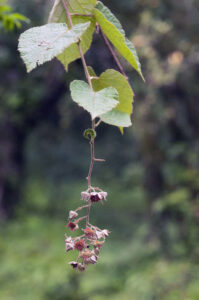
Flowers to 2.5 cm across, stalked, solitary or up to 8 together in terminal or axillary, drooping clusters, to 6 cm long. Calyx-lobes broadly ovate, pointed, woolly-hairy, to 8 mm long and broad, petals white, obovate, to 8 mm long, stamens shorter than petals. Blooming occurs April-June. The yellow or orange fruit is enclosed in the calyx, to 1.8 cm across, ripening June-August.
It is distributed from Kashmir eastwards to Myanmar and south-western China, growing in forests and shrubberies, and on open slopes, at altitudes between 1,500 and 3,500 m.
The fruit is edible.
The specific name is Latin, meaning ‘with 2 flowers’ – an odd name, as the flowers are often solitary or in clusters up to 8.
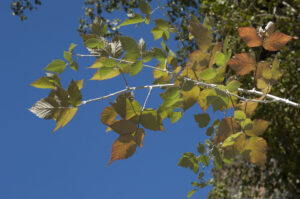
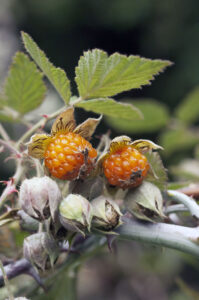
Stems creeping, bristly, to 3 m long, rooting at the nodes, lateral stems ascending, to 20 cm tall. Leaves simple, hairy, toothed, sometimes with 3-5 lobes, to 6 cm across, leaf-stalk to 10 cm long, bristly-hairy. Stipules ovate, to 1.3 cm across.
Flowers are erect, solitary or in pairs, to 3 cm across, stalk to 5 cm long, bristly-hairy, sepals leaf-like, ovate or elliptic, to 1.4 cm long and 1.1 cm broad, entire or toothed, petals white. Flowering occurs May-July. The fruit is scarlet, globular, to 1.4 cm across, ripening September-November.
The fruit is edible.
The specific name is Latin, meaning ‘with a prominent calyx’.
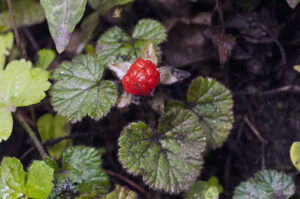
Flowers to 1.5 cm across, in dense terminal or axillary clusters, to 4 cm long, sepals shorter than petals, woolly-hairy, petals white, sometimes pink. Flowering occurs in winter and spring, between December and April. The fruit is golden-yellow, to 1 cm across, ripening April-July.
It is distributed from Pakistan eastwards to China, and thence southwards to southern Indochina and the Philippines. In the Himalaya, it grows in shrubberies and open areas at elevations between 600 and 2,600 m.
This species is planted to prevent soil erosion. Goats and sheep browse on the leaves. The fruit is sweet, eaten fresh or as marmalade. Medicinally, it is used for various ailments, including fever, diarrhoea, gastric problems, colic, cough, and dysentery. A paste of the root is applied to wounds.
The specific name refers to the leaf shape.
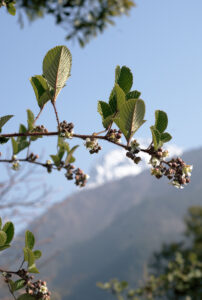
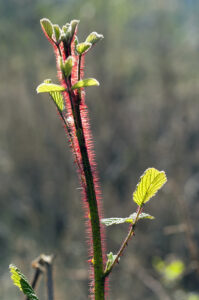
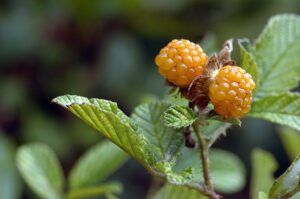
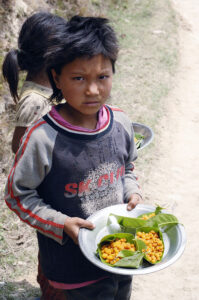
Inflorescences are axillary or terminal clusters, to 7 cm long, with few flowers, to 1.5 cm across, sepals ovate, pointed, woolly-hairy, petals pink, obovate. It blooms April-May. The fruit is red or orange, to 1 cm across, ripening July-September.
This plant is native from eastern Afghanistan eastwards to central Nepal, growing in shrubberies and open areas at altitudes between 1,500 and 2,800 m.
The fruit is edible, with a slightly acid taste. Jam is also made from it.
The specific name was given in honour of German physician and botanist Werner Friedrich Hoffmeister (1819-1845), who accompanied his friend, Prince Friedrich Wilhelm Waldemar of Prussia (1817-1849), as a personal physician on an expedition to India 1845-46. He was killed in Punjab in a skirmish with Sikhs. Hoffmeister collected numerous plants during the expedition, many of which were new to science. His material was published in 1853, titled Die Botanischen Ergebnisse der Reise seiner königl. Hoheit des Prinzen Waldemar von Preussen in den Jahren 1845 und 1846 (‘Botanical results of the travels of His Royal Highness Prince Waldemar von Preussen in the years 1845 and 1846’).
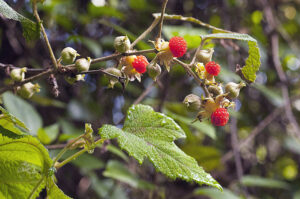
It is distributed from Uttarakhand eastwards to Sikkim, growing in grasslands and shrubberies, and on rocks, at elevations between 2,100 and 3,200 m. It is very common in Nepal.
The fruits are edible and sweet.
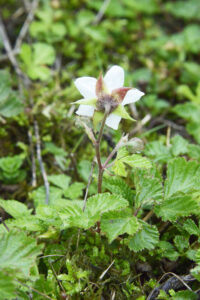
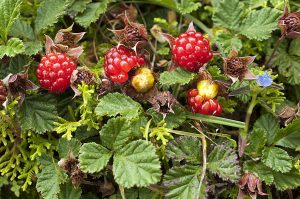
A scrambling shrub to 3 m long, stems waxy, purplish, usually with curved, purplish prickles. Leaves pinnate, leaflets 3-9, elliptic, shining, toothed, woolly-hairy beneath, margin toothed, tip pointed or blunt, terminal leaflet short-stalked, to 4 cm long, sometimes lobed, a little larger than the stalkless lateral leaflets.
Flowers grow to 1.6 cm across, arranged in branched, short, axillary or terminal clusters, calyx-lobes purplish, silky-haired, long-pointed, about same length as the pink petals. Flowering occurs April-July. Initially, the fruit is red, turning to purplish-black, to 1.2 cm across, ripening July-September.
The fruit is edible. In Nepal, unripe fruits are chewed to relieve headache.
The specific name is Latin, meaning ‘relating to snow’ – an odd name, as it is not found at particularly high altitudes. Maybe it alludes to the waxy stems.
This description includes R. foliolosus, which was previously regarded as a separate species.
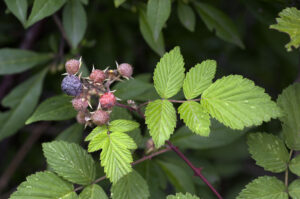
Inflorescences are terminal or axillary clusters, the terminal one very long, to 24 cm, flowers to 1.8 cm across, sepals ovate or lanceolate, to 7 mm long and 4 mm broad, pointed, petals white or yellowish, oblong, to 8 mm in diameter. Blooming takes place June-August. The fruit is dark red or blackish-purple, to 1 cm across, ripening July-October.
This plant is found in forests and shrubberies at elevations between 1,500 and 3,200 m, from Pakistan eastwards to Myanmar and south-western China.
Fruits are edible. In Nepal, a paste of the bark is applied to skin problems, a paste of the leaves to sprains.
The specific name is Latin, referring to the inflorescence.
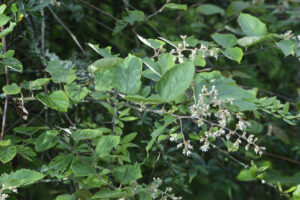
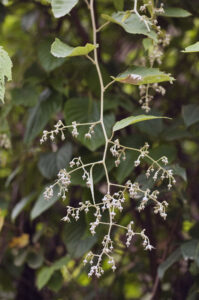
Stems to 6 m long, reddish-brown, initially downy, later smooth, with few prickles. Stipules linear or linear-lanceolate, to 8 mm long, soft-haired. Leaves stalked, trifoliate, rarely with 5 leaflets, rachis with a few minute prickles, leaflets ovate, rarely ovate-lanceolate, to 6 cm long and 4 cm wide, densely woolly-hairy beneath, base heart-shaped or rounded, margin irregularly toothed or double-toothed, tip pointed.
Inflorescences are few-flowered, flowers stalked, to 2 cm across, sepals ovate-lanceolate, to 1.5 cm long, purplish, margin downy, tip long-pointed, petals pink, ovate, to 1 cm long and 6 mm wide, tip entire or indented. The flowering period is May-August. The fruit is black, ovoid or globular, ripening July-October.
The fruit is edible. In Nepal, juice of the leaves is taken for fever.
The specific name is Latin, meaning ‘stalked’. What it refers to is not clear. The flowers are not particularly long-stalked.
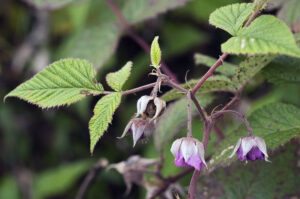
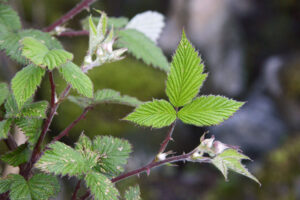
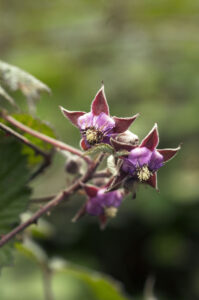
These plants resemble species of Potentilla (above), but the leaves are wedge-shaped, trifoliate or palmate.
The generic name commemorates Scottish physician and antiquary Robert Sibbald (1641-1722), who is best remembered for being the first person to describe the blue whale (Balaenoptera musculus), from a specimen stranded in the estuary of the Firth of Forth, Scotland, in 1692. Initially, it was referred to as Sibbald’s rorqual.
Inflorescences terminal, flat-topped clusters, flowers to 7 mm across. Sepals and epicalyx similar, ovate or oblong, silky-hairy, tip pointed, petals 5, obovate, pale yellow, similar in size to sepals, tip blunt. Flowering takes place May-August. The achenes are smooth.
It is distributed from Afghanistan eastwards along the Himalaya to central China and Taiwan. In the Himalaya, it grows in grasslands and rocky areas, found at altitudes between 3,000 and 4,500 m.
The specific name is Latin, meaning ‘wedge-shaped’, referring to the leaves.
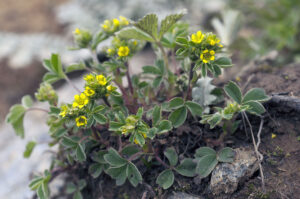
The generic name is composed of the genus name Sibbaldia (above), and probably Ancient Greek antheros (‘anther’), thus ‘with anthers like Sibbaldia‘.
Flowering stems several, prostrate or ascending, to 20 cm tall/long. Leaves pinnate, including stalk to 8 cm long, blue-green, leaflets 3-8 pairs, elliptic or obovate, to 1.5 cm long and 8 mm broad, tip blunt, pointed, or sometimes with two forks. Flowers solitary or few together, yellow, to 1.5 cm across, short-stalked, petals obovate, rounded, sepals and epicalyx-lobes elliptic or ovate, pointed. Blooming takes place May-September.
The specific name is Latin, meaning ‘two-forked’, presumably alluding to the leaflets, which often have two teeth.
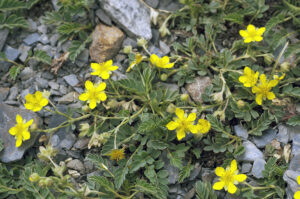
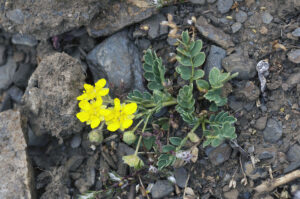
The generic name is derived from Ancient Greek gala (’milk’), alluding to the usage of yellow bedstraw (G. verum) in rennet, as its flowers are able to coagulate milk to make cheese. In his book Herbal Simples, Dr. William T. Fernie (1830-1914) writes: “The people in Cheshire, especially about Nantwich, where the best cheese is made, do use it [yellow bedstraw] in their rennet, esteeming greatly of that cheese above other made without it.”
In Norse religion, yellow bedstraw was dedicated to Frigg, goddess of knowledge, love, and marriage, who was also protector of women giving birth. It was a custom to line the childbed with this fragrant herb. When Christianity was introduced, this heathen habit was banned, but as it persisted, the Church decided to dedicate yellow bedstraw to Virgin Mary instead, claiming that this herb was lining the crib of the newborn Jesus, hence the folk name Our Lady’s bedstraw.
It was also stuffed into mattresses, from which the coumarin of the drying plants would emit a pleasant fragrance. As coumarin is toxic, it would also expel fleas and lice.
Inflorescences are terminal, or sometimes in axils of upper leaves, spreading, with up to 10 stalked flowers, corolla white, sometimes pale green, to 3 mm across, petals 4, ovate, pointed. Flowering takes place April-August. The fruit is ellipsoid, to 2 mm across, with a dense cover of white hairs.
It is widely distributed in forests and shrubberies, from Afghanistan eastwards to China and Korea, in the Himalaya found up to elevations around 4,000 m.
The specific name was given in honour of German physician and botanist Werner Friedrich Hoffmeister (1819-1845), who accompanied his friend, Prince Friedrich Wilhelm Waldemar of Prussia (1817-1849), as a personal physician on an expedition to India 1845-46. He was killed in Punjab in a skirmish with Sikhs. Hoffmeister collected numerous plants during the expedition, many of which were new to science. His material was published in 1853, titled Die Botanischen Ergebnisse der Reise seiner königl. Hoheit des Prinzen Waldemar von Preussen in den Jahren 1845 und 1846 (‘Botanical results of the travels of His Royal Highness Prince Waldemar von Preussen in the years 1845 and 1846’).
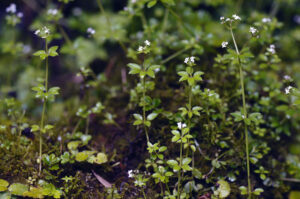
These plants were formerly included in the genus Randia, erected by Swedish naturalist Carl Linnaeus (1707-1778) to commemorate English botanist and apothecary Isaac Rand (1674-1743), director at the Chelsea Physic Garden. Thus, the generic name means ‘the Randia from the Himalaya’.
A small many-branched shrub, to 2 m tall, branches sometimes ending in a straight spine. Leaves crowded at the end of branches, to 3 cm long, narrowed to a short stalk, blade ovate, oblanceolate, or elliptic, smooth, margin entire, tip rounded or pointed.
Flowers solitary, to 1.2 cm long and 1 cm in diameter, calyx-tube to 1 cm long, with 5 narrow, pointed, reflexed lobes, to 1.5 mm long. Corolla fragrant, greenish-white or yellow, funnel-shaped, tube to 8 mm long, with 5 reflexed, pointed lobes, to 5 mm long, stigma and anthers exserted, stigma white or yellowish, spindle-shaped, anthers long, brownish with darker longitudinal streaks. Flowering occurs April-July. The fruit is globular, to 8 mm in diameter, purple or blue, calyx persistent.
In Nepal, the wood is used as fences, walking sticks, and fuel. Goats and sheep browse on the foliage. A paste of the charcoal is applied to extract spines that have been buried deep in the flesh.
The specific name is derived from Ancient Greek, meaning ‘with 4 seeds’.

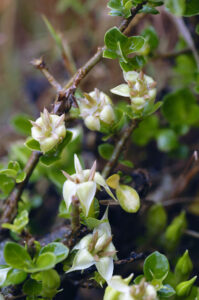
The generic name is derived from Ancient Greek leptos (‘thin’) and derma (‘skin’). It is not obvious what it refers to.
Branches are long or short, purplish or grey, with glandular hairs. Leaves sessile or short-stalked, oblong-lanceolate or ovate-lanceolate, to 10 cm long and 2.5 cm wide on long branches, much smaller on short branches, hairy, margin entire, hairy, tip pointed, midrib indented, stipules triangular, to 4.5 mm long.
Flowers are axillary or terminal, up to 5 together, calyx tube to 4 mm long, with 5 triangular lobes, to 1.5 mm long, hairy, pointed, corolla funnel-shaped, to 1.5 cm long, white or pink, turning violet or purplish with age, hairy in the throat, with 5 ovate lobes, to 1 cm long, abrupty narrowed to a sharp point. Flowering occurs June-October. The fruit is a shining capsule, stinking when crushed.
The specific name refers to Kumaon, a district in Uttarakhand. Presumably, the type specimen was collected there.
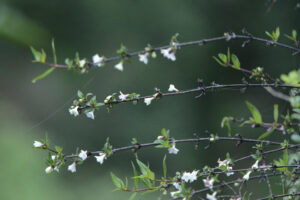
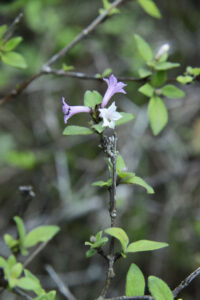
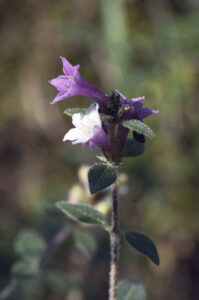
The generic name is derived from the Latin luculentus (‘brilliant’), ultimately from lux (‘light’).
The inflorescence is a terminal, many-flowered, spreading cluster, calyx lobes lanceolate, pointed, to 1.6 cm long, hairy, corolla pink, sometimes white, with a narrow tube, to 5 cm long, lobes rounded, to 1.5 cm across, margin with a few tiny teeth. Flowers occur September-October.
This beautiful plant is distributed from central Nepal eastwards to northern Indochina and south-western China, growing in shrubberies and open areas at elevations between 800 and 2,400 m. It is rather common in Nepal.
In Nepal, juice of the leaves is used for wounds, juice of the fruit for indigestion. Juice of the root is applied to the forehead in case of headache. Juice of the bark is given to cattle to expel intestinal worms. The flowers are presented as offerings in Hindu and Buddhist shrines.
The specific name is Latin, meaning ‘most pleasing’ – a very suitable name!
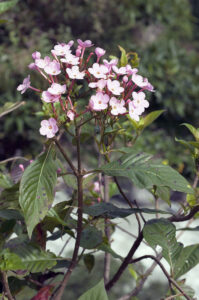

The generic name is derived from the Sinhalese mussenda, a name used for the species M. frondosa. It was first mentioned by German physician and botanist Paul Hermann (1646-1695) in his Musaeum Zeylanicum. For 15 years, he was the director of the botanical garden in Leiden.
The Himalayan species are confusingly similar, and I leave the specimens in the pictures below as unidentified.
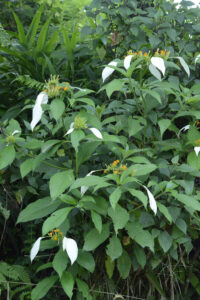
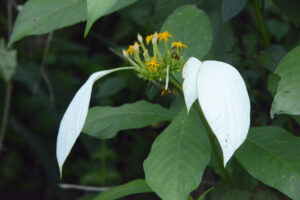
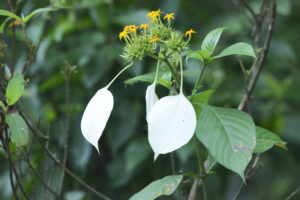
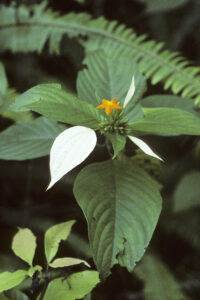
The generic name is the derived from the Sinhalese pawatta, the local term for P. indica.
An erect shrub to 4 m tall, branches smooth or sparsely hairy. Leaves stalked, blade leathery, elliptic-oblong or elliptic-lanceolate, to 23 cm long, gradually narrowed towards the base, tip long-pointed, lateral veins 5-6 pairs, conspicuous. Stipules are fused into a sheath.
Inflorescences are many-flowered, domed, terminal clusters, to 10 cm across, sepal lobes tiny, triangular, toothed, hairy, corolla white, fragrant, tube slender, to 2 cm long, lobes 4, oblong, spreading, to 8 mm long, style exserted, very long. Flowering takes place April-May. The fruit is black, globular, to 7 mm in diameter.
A decoction of the bark is used to cure intestinal obstruction, a decoction of the leaves is given for haemorrhoids, the pulverized root for dropsy.
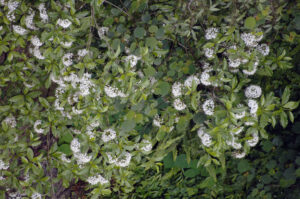
The generic name is derived from the Latin ruber (‘red’), alluding to the red dye obtained from the root of Rubia tinctorum, hence also the common name of these plants.
Flowers are arranged in many small clusters, to 10 cm long, aggregated in a large branched inflorescence, each small cluster with a leaf-like bract. Flowers to 3 mm across, corolla yellow, orange, red, or deep purple, lobes 5, lanceolate to triangular, to 2 mm long. Flowering occurs June-November. The fruit is a dark red berry, to 5 mm across.
It is distributed from Himachal Pradesh eastwards to western China. In the Himalaya, it grows at elevations between 1,200 and 2,700 m.
In Nepal, the root is used as an astringent and a tonic. A paste of the stem is applied to scorpion bites. A red dye, called manjith in Hindi, is obtained from the root.
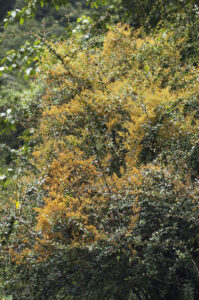
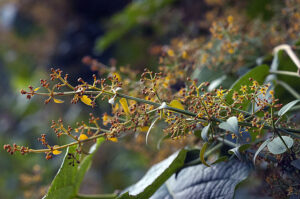
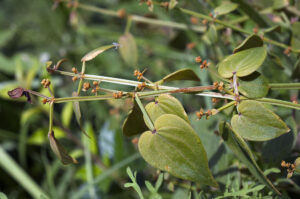
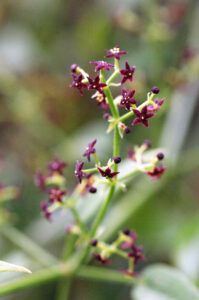
It often forms loose cushions from a woody rootstock, stems to 30 cm high, 4-angled, smooth or sparsely covered in hooked hairs. Leaves opposite, stalkless, blade ovate, elliptic, or lanceolate, to 3 cm long and 1.5 cm wide, both surfaces with short, stiff hairs, tip pointed. Inflorescences leafy, axillary or terminal, flowers solitary or few together, stalked, corolla yellow, to 8 mm across, lobes lanceolate or ovate-lanceolate, to 2.5 mm long, pointed. It blooms June-July. The fruit is a berry, to 4 mm across.
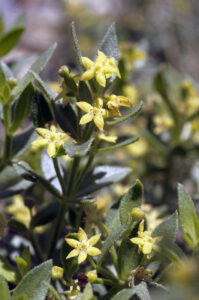
The plant has a strong foetid smell. Stem to 80 cm tall, sometimes more, reddish-brown, almost hairless. Leaves twice or thrice pinnately divided, to 15 cm long, leaflets elliptic or inverted heart-shaped, to 2.5 cm long and 1.5 cm broad, gland-dotted, margin entire.
Inflorescences are branched terminal clusters, to 60 cm long, sepals tiny, petals white, elliptic or obovate, to 6 mm long, stamens 6-8, filaments longer than petals. Flowering occurs May-October. The fruit is a follicle, to 8 mm across, splitting into fruitlets when ripe.
In Nepal, juice of the plant is applied to stop bleeding and to kill germs. It is also applied to treat scabies, curb fever, and relieve headache. Crushed leaves are pressed against aching teeth. They are also used as flea powder, and to kill lice on cattle.
The generic name commemorates Dutch-born, Prussian civil servant, agriculturalist, botanist, and physician Clemens Maria Franz Freiherr von Bönninghausen (1785-1864). He was a pioneer in the field of homeopathy.
The specific name is Latin, meaning ‘with white flowers’.
Superficially, this species resembles Thalictrum virgatum (Ranunculaceae), but the leaves are different.
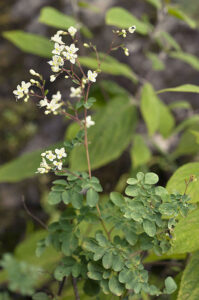
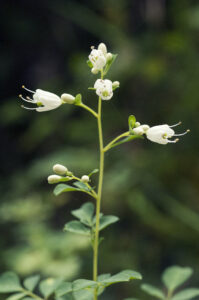
The seeds of several species are dried and used as a spice, in the Himalaya known as timur, in China as Sichuan pepper. They are also utilized in traditional medicine.
The generic name is derived from Ancient Greek xanthos (‘yellow’) and xylon (‘wood’). The English name alludes to the spines on trunk or branches of most species, and to the leaves, which superficially resemble those of the common ash (Fraxinus excelsior).
It grows to about 5 m tall, bark corky, trunk, branches, and leaf-stalks usually with long, almost straight spines, but sometimes unarmed (see third picture below). Leaves pinnate, with 3-9 stalkless, opposite, ovate-lanceolate, pointed leaflets, to 8 cm long and 2 cm broad, entire or sparsely toothed. Leaf-stalk and rachis are mostly narrowly winged, but sometimes unwinged, rusty-downy, midrib sometimes spiny below.
Inflorescences are terminal or axillary clusters, to 7 cm long, with stalked flowers, to 1.5 mm across, calyx yellow, with 6-8 pointed lobes, petals absent. Flowering takes place from March to May. The fruit is a globular capsule, purplish-red, to 5 mm across, with a few oil glands. It ripens August-October. Seeds are black, shining.
In Nepal, root, bark, leaves, and seeds are used for a number of ailments, including toothache, cough, rheumatism, and indigestion, and also to expel intestinal worms. Bark and leaves are strewn in streams to stupefy fish. Walking sticks are made from the branches, and the twigs are used for cleaning the teeth. Fruits are pickled. The seeds are dried and used as a spice, called timur.
The specific name is Latin, meaning ‘armed’, of course alluding to the vicious spines.
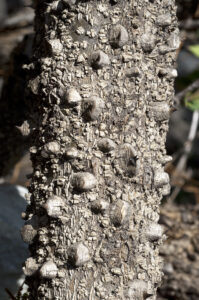
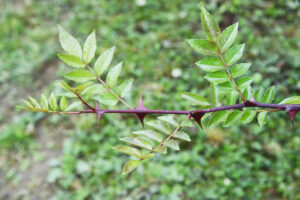
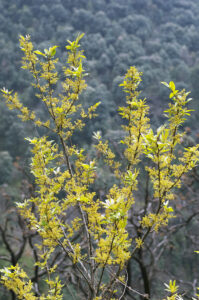
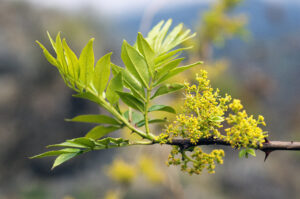
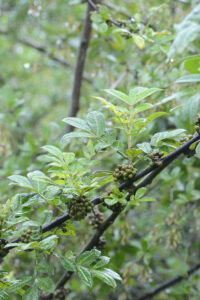
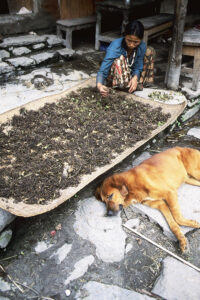
It is restricted to central and eastern Nepal, found at elevations between 2,400 and 3,100 m. Habitats include shrubberies, open areas, and edges of fields. It is quite common in the Langtang Valley, central Nepal.
In Nepal, a paste of the unripe fruit is pressed against the teeth to relieve toothache.
Z. bungeanum is widespread, found from Xinjiang eastwards to north-eastern China, southwards to Nepal and south-western China.
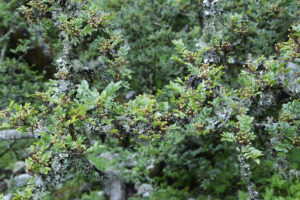
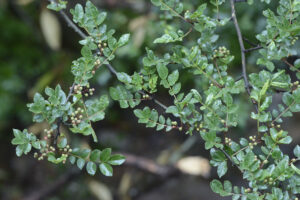
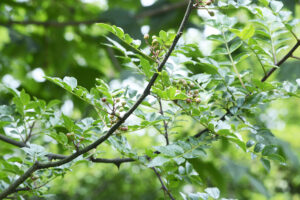
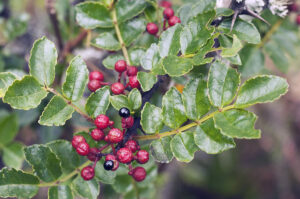
It is similar to Z. armatum, and grows in similar habitats, but is often a climber, to about 5 m long. Branches, leaf-stalk, and rachis have stout, hooked prickles, leaf-stalk and rachis unwinged, leaflets 11-19, to 12 cm long and 2.5 cm broad. Inflorescences are many-flowered branched clusters, flowers to 8 mm across, petals 4, lilac, blunt, to 5 mm long, filaments white, anthers yellow. Flowering takes place April-June, ripening of fruits June-October.
In Nepal, a paste of the unripe fruit is pressed against the teeth to relieve toothache. Fruits are pickled. The seeds are dried and used as a spice, called timur.
The specific name is derived from Ancient Greek oxys (‘sharp’) and phyllon (‘leaf’), alluding to the sharply pointed leaflets.
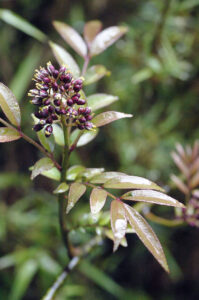
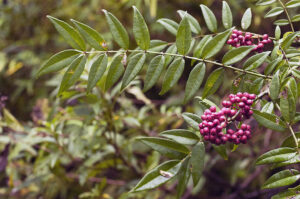
The leaves are broad, mostly heart-shaped, with a long, slender stalk, which is flattened, making the leaf rustle in the wind. Inflorescences are pendent catkins, with numerous tiny flowers clustered around a central axis, each flower surrounded by papery bracts. The flowers are wind-pollinated, seeds fluffy, spread by the wind.
Several species display brilliant yellow foliage in the autumn, examples of which are shown on the page In praise of the colour yellow.
The generic name is the classical Latin word for poplars. The common name cottonwood alludes to the fluffy seeds. The name aspen is derived from Old English æspe, originally from Proto-Germanic aspe (‘shaking’), alluding to the fluttering leaves of European aspen (P. tremula).
Flowers are greenish, male catkins to 10 cm long, bracts oblanceolate, with hairy margins, female catkins to 30 cm long. Blooming occurs March-April. The seeds are covered in long, silky hairs. They ripen April-June.
It is distributed from Pakistan eastwards to northern Myanmar and the Yunnan Province, growing in forests and open areas, and along streams, at elevations between 1,500 and 3,600 m.
This tree is often cultivated in Tibetan areas. The wood is used for construction, branches for roofs, and the foliage is cut for fodder. In Nepal, a paste of the bark is applied to muscular swellings.
The specific name is Latin, meaning ‘hairy’. It may refer to the leaf-stalk, the underside of the leaves, the bracts, or the seeds.
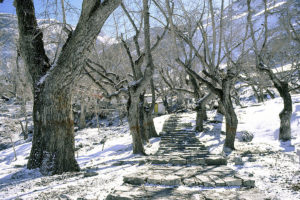
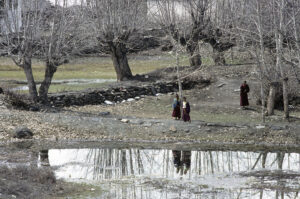
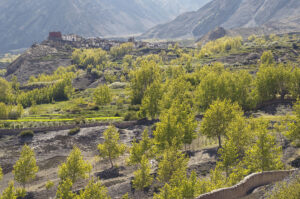
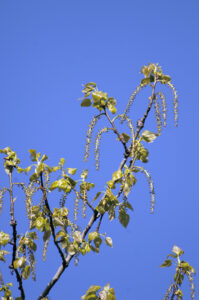
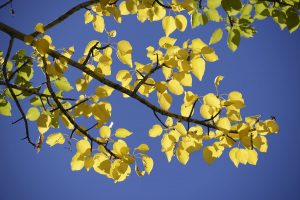
It grows to 35 m tall, with dull-grey bark, furrowed on older specimens. Young branches yellowish, smooth. Leaf buds russet-coloured, sticky, leaf-stalk to 10 cm long, flattened, blade rhombic, ovate, or triangular with a straight base, to 10 cm long and 8 cm broad, margin toothed, tip long-pointed.
Male catkins grow to 6 cm long, bracts brownish, to 4 mm long, serrated, anthers purplish-red. Female catkins to 10 cm long. Flowering takes place April-May.
In Greek mythology, Phaethon was the son of the sun god Helios. He wanted to be sure that Helios was his father, so he went to the sun god’s palace in the east. He was recognized by his father, but when he asked for permission to drive his father’s chariot for a single day, Helios warned him, saying that only he, Helios, was able to control the horses. Despite these warnings, Phaethon wanted to drive the chariot, but, as it turned out, he could not control the horses, going too close to the Earth, which might burn it, and too far from it, which might freeze it.
To save the Earth from these disasters, Zeus stroke Phaethon with a lightning bolt, killing him. His dead body fell into the river Eridanus, where his sisters, the Heliades, mourned him for several months. The gods turned them into black poplars, and their tears to amber.
The specific name is Latin, meaning ‘black’. It may refer to the numerous blackish fissures in the bark of older trees.
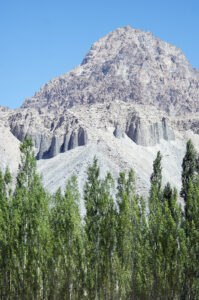
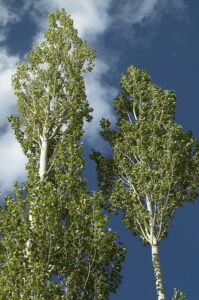
The inflorescence is a catkin, with numerous tiny flowers clustered around a central axis, each flower surrounded by papery bracts. Catkins are erect, pollinated by bees and other insects.
The generic name is the classical Latin name of willows. It probably stems from the word sal (‘salt’). However, the original meaning of sal was ‘grey’ or ‘smudged’. In the old days, salt was not white, but dirty-grey – just like the colour of the bark of the grey willow (Salix cinerea).
Identification of members of this genus is notoriously difficult, as many of them vary tremendously. They also often hybridize, which further complicates the matter. If you are able to identify any of the species in the following 7 pictures, I should be happy to hear about it. You can use the address at the bottom of the page.
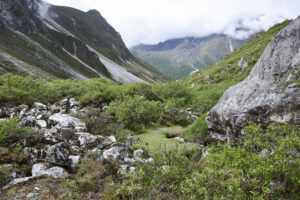
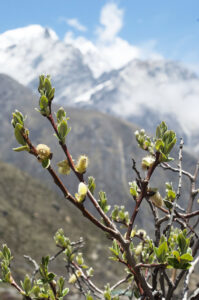
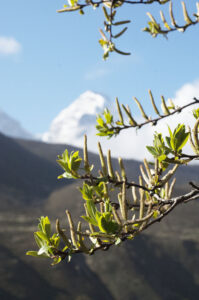
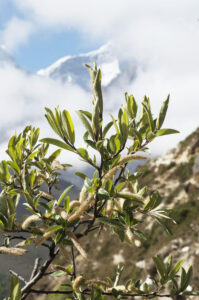
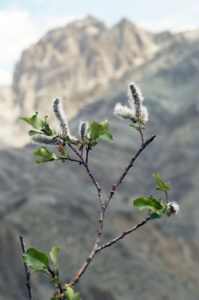
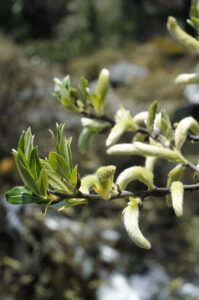
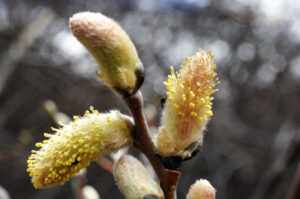
Male catkins are on short leafy stems, broadly ellipsoid, hairless, to 2 cm long, female catkins ellipsoid, to 1.5 cm long. They flower June-July. Fruiting catkins are purplish-red, ripening July-September.
It is distributed from Uttarakhand eastwards to northern Myanmar and the Yunnan Province, growing in open areas and on rocks, found at elevations between 3,400 and 4,700 m.
The specific name probably refers to the large, persistent calyx.
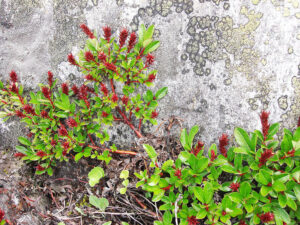
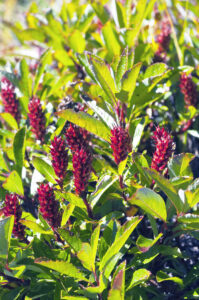
Stems creeping or ascending, to 20 cm long. Twigs hairy. Leaves elliptic-lanceolate or oblanceolate, shining, smooth, blue-green beneath, to 1 cm long and 5 mm broad, pointed, margin with a few large teeth.
Male catkins are ovoid, to 1.5 cm long, bracts reddish-purple, hairless, female catkins to 2 cm long, axis densely hairy. Flowering occurs May-June. Fruiting catkins are cylindric, purplish-red, to 5 cm long, ripening June-July.
The specific name is Latin, meaning ‘a small bush’.
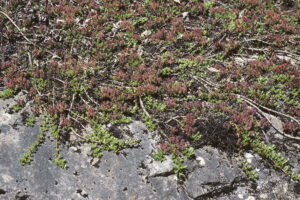
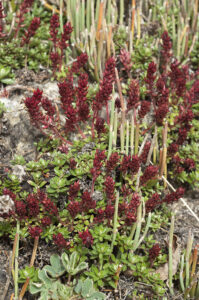
All flowers are yellow or pale green, male catkins ovoid, to 1.2 cm long, bracts broadly ovate, reddish-purple, hairy, female catkins to 1.5 cm long, hidden among the leaves. Blooming takes place June-July, ripening of fruits July-September.
It is distributed from Pakistan eastwards to Bhutan and the Yunnan Province, growing on rocks and open slopes at elevations between 3,600 and 5,000 m.
The specific name honours English botanist and gardener John Lindley (1799-1865), who published a huge number of books and articles. He specialized in orchids.
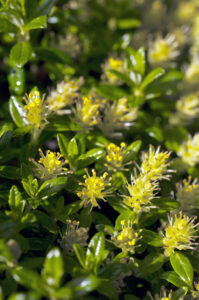
The generic name is probably the classical Latin name of these plants. The common name is derogative, meaning something like ‘inferior toadflax’, alluding to the leaves of some European members of Thesium, which resemble those of the true toadflax (Linaria).
Some authorities place this genus in the family Thesiaceae.
This plant grows in shrubberies and on dry open slopes at elevations between 2,000 and 3,400 m, found from Pakistan eastwards to Ladakh.
The specific name honours British botanist Joseph Dalton Hooker (see Fragaria daltoniana above).
T. himalense is similar, but flowers and leaves are narrower, and the bracts are smaller. It is found from Kashmir eastwards to Sikkim, at altitudes between 1,300 and 4,000 m.
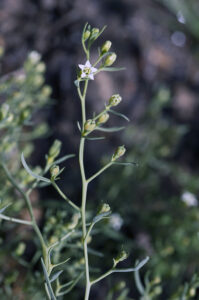
These plants are widespread in the Northern Hemisphere, with most species in Asia, others in Europe, northern Africa, and North and Central America. Only a single species occurs in the Southern Hemisphere. About 14 species have been observed in the Himalaya.
The leaves are palmate in most species, and the foliage often turns a brilliant red or yellow in autumn. A number of pictures, depicting this autumn foliage, are found on the page Autumn.
The fruit consists of two 1-seeded units, each with a long wing. When ripe, these units separate and are often propelled a considerable distance by the wind. You may read an account of the effectiveness of this spreading on the page Nature reserve Vorsø: Expanding wilderness.
The generic name is the classical Latin term for maple.
A deciduous tree, often gregarious, to 25 m tall, bark grey to pale brown, with silvery patches scaling off. Twigs red-brown, dotted. Leaves long-stalked, red when young, later dark green above, pale green or bluish-grey beneath, to 15 cm long and 20 cm broad, palmate, with 5, rarely 3 lobes, triangular in outline, base heart-shaped, margin toothed, tip pointed. Buds prominent in dormant season.
Flowers tiny, to 5 mm across, in branched clusters, sepals yellowish-green, petals whitish. Blooming occurs from March to June. The fruit is yellowish, wings diverging at an acute angle, or sometimes overlapping, to 5 cm long. Ripening takes place August-November.
The wood is utilized for a large number of items, including furniture, cups, bowls, and rifle stocks, the leaves for wrapping fruit, which makes it more durable. Over-exploitation of the timber for commercial and local use has caused the species to decline, especially in Pakistan. (Source: IUCN Red List of Threatened Species, iucnredlist.org)
In Nepal, juice of the bark is applied to swellings of muscles, and also to boils and pimples.
The specific name is Latin, meaning ‘bluish-grey’, presumably alluding to the underside of the leaves.
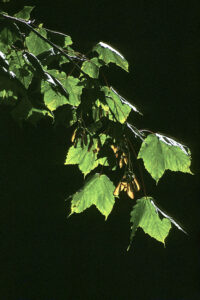
Flowers are in terminal clusters to 10 cm long. Sepals 5, ovate, petals 5, tiny, cream-coloured, yellowish-green, or reddish. Blooming takes place April-May. The fruit is yellowish or red, wings sickle-shaped, widely diverging, to 2.8 cm long and 8 mm broad. It ripens August-October.
This species occurs in forests and shrubberies at elevations between 1,800 and 3,700 m, from western Nepal eastwards to northern Indochina and south-western China. It is very common in eastern Nepal. The foliage is often lopped for fodder.
The specific name honours British physician Archibald Campbell (1805-1874) of the Bengal Medical Service, the first superintendent of the sanatorium in Darjiling. He had a great interest in ethnology and botany, corresponding with several British naturalists, including Joseph Dalton Hooker (see Fragaria daltoniana above), and Brian Houghton Hodgson (1801-1894), who described numerous new species of birds and mammals in the Himalaya.
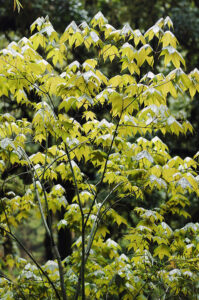
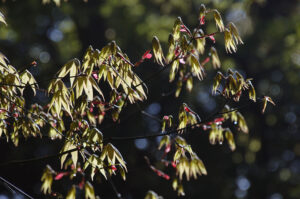
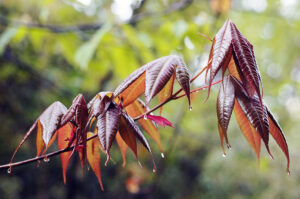
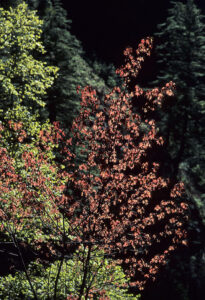
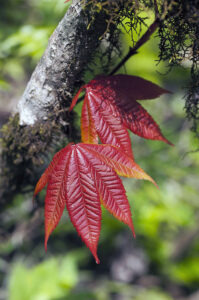
The bark is brown or greyish, grooved on older trees. Twigs stout, reddish-green with pale stripes. Leaves long-stalked, often reddish when young, later dark green above, pale green below, to 20 cm long and 15 cm across, smooth, except tufts of hairs in the vein axils on the underside, with 5-7, sometimes 3, triangular or ovate, long-pointed lobes, base rounded, margin entire. The leaves turn yellow or red in autumn.
Flowers are to 8 mm across, yellowish-green, in lax branched clusters, which appear with the young leaves, from March to May. The fruit is pink when young, wings to 5 cm long and 9 mm broad, usually widely diverging, almost horizontal. Ripening occurs August-September.
The wood is utilized to make various items, including farming implements, poles, bedsteads, and drinking cups.
The specific name refers to Cappadocia in central Turkey. Presumably, the type specimen was collected there.
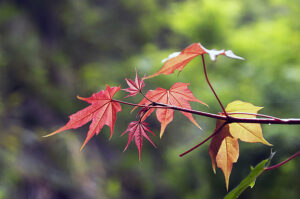
Flowers are arranged in a terminal, erect cluster, to 12 cm long, reddish or yellowish-green, hairy. Sepals tiny, ovate-lanceolate, to 3 mm long, petals linear or oblong, to 7 mm long. Flowering takes place May-June. The fruit is yellowish-brown, wings to 2.8 cm long and 9 mm broad, diverging at an acute angle. Ripening occurs in September.
It grows in forests at elevations between 1,700 and 4,000 m, distributed from Uttarakhand eastwards to Myanmar and western China.
The specific name is Latin, meaning ‘having a tail’, referring to the long, pointed lobes on the leaves.
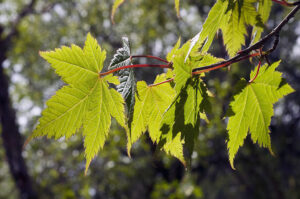
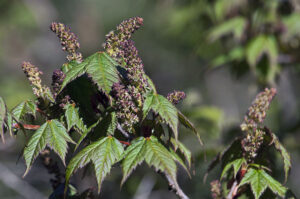
The bark is dark-grey or brownish-grey, young shoots covered in brownish hairs. Leaf-stalk greenish or purplish-green, to 15 cm long. Leaves dark-green and smooth above, greenish and hairy beneath, to 20 cm long and 23 cm across, lobes 3-5, rarely 7, ovate, pointed, base heart-shaped, margin with short, sometimes blunt teeth.
Flowers are yellowish-green, to 1 cm across, in a raceme to 8 cm long, usually appearing from February to May, before the leaves. The fruit is yellowish or brown, wings to 6.5 cm long, almost parallel or slightly spreading, covered in rusty hairs. It ripens August-September.
In the Himalaya, the foliage is often lopped for fodder.
The specific name means ‘resembling Sterculia’, presumably referring to the leaves being similar to the leaves of a species in that genus. Incidentally, Sterculia foetida, also known as skunk-tree, was named due to its foul-smelling, orange-red flowers, shown on the page In praise of the colour red. The name stems from Sterquilinus, the Roman god of fertilizer or manure.
This species is sometimes called Franchet’s maple, named in honour of French botanist Adrien René Franchet (1834-1900), who was based at the Muséum National d’Histoire Naturelle in Paris. He described numerous species from China and Japan, based on collections made by French missionaries.
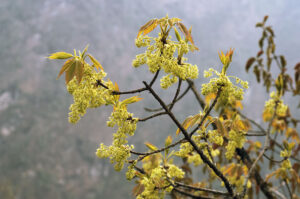
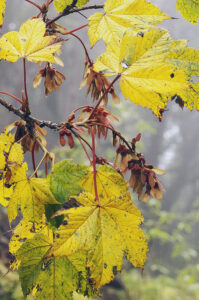
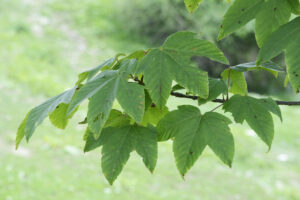
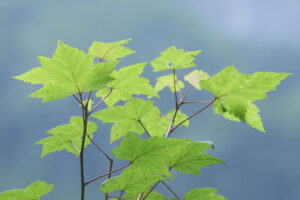
The winter buds are very large, sticky, covered in resinous scales. The large leaves are palmate. The inflorescence is very spectacular, in uprigt, almost pyramid-shaped racemes. The fruit is a capsule, containing 1-3 large, chestnut-coloured, shining seeds.
The generic name is the Latin name of the sessile oak (Quercus petraea), possibly derived from aigilops, the Ancient Greek name of an oak with edible acorns. As horsechestnut fruits are poisonous, it is indeed a bit of a mystery, why Swedish naturalist Carl Linnaeus (1707-1778) named the genus Aesculus. However, it must be pointed out that the meal is edible after boiling the fruits, and it was formerly used as cattle and chicken feed.
The common name horsechestnut comes in part from the Turkish name of the European species, at kestanesi, and the horse-part stems from the usage of the fruits to treat ailments in horses, including excessive wind. The American common name buckeye stems from an American indigenous tribe, who called the nut hetuck, which means buck-eye, alluding to the markings on the nut, which resembles the eye of a deer.
An American species of this genus, California buckeye (A. californica), is presented on the page Plants: Plants of Sierra Nevada, whereas the common horsechestnut (A. hippocastanum) is described on the page Plants: Ancient and huge trees.
Inflorescences are terminal pyramidal clusters to 40 cm long, downy. Petals 4, to 2.3 cm long, unequal, clawed, white or yellowish, with red streaks at the base, downy on the outside. There are 7 stamens, longer than the petals, slightly curved. Blooming occurs April-June. The capsule is ovoid, to 5 cm long, smooth, seeds globular, to 3.5 cm across, dark brown, shining, ripening July-November.
The native area of this species is from Afghanistan eastwards to central Nepal, where it occurs in forests at altitudes between 1,200 and 3,300 m. Elsewhere, it is widely cultivated as an ornamental.
The wood is used for carpentry, the foliage for fodder. Juice of the bark is taken as a tonic and for fever. In Nepal, juice of the bark or seed oil is applied in case of rheumatism. Oil from the seeds is applied to skin problems. A paste of the oil cake is applied to the forehead to relieve headache. The cotyledon is fed to animals to expel intestinal worms. Roasted cotyledons may be cooked as a vegetable. Ground seeds are mixed with flour to enhance the taste of the bread.
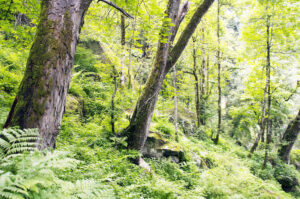
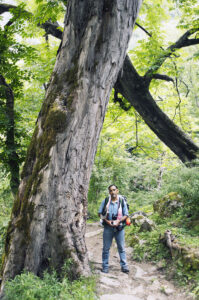
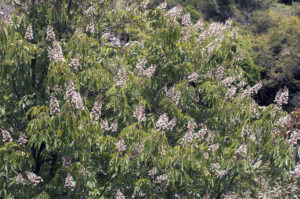
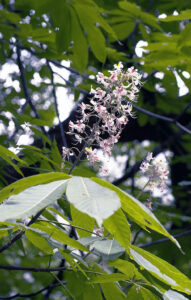
The generic name is derived from the Latin sapo (‘soap’) and indicus (‘of India’). These plants are renowned for their fruits, which have a high contents of saponin and can be used as a washing agent.
The bark is greyish-brown or blackish-brown, young branches green, hairless. The leaves are pinnately divided, including stalk to 45 cm long, smooth or downy, with 5-8 pairs of shiny, narrowly elliptic, lanceolate, or slightly falcate leaflets, to 15 cm long and 5 cm wide, papery, with 15-17 pairs of nearly parallel veins, base slightly asymmetrical, tip pointed, margin entire.
Inflorescences are large, terminal, pyramidal panicles, to 20 cm long. Flowers tiny, sepals 5, ovate, about 2 mm long, petals 5, cream-coloured or purple, lanceolate, about 2.5 mm long. Flowering takes place April-May. The fruit is almost globular, smooth, often with swellings at the stalk, to 2.5 cm across, green when unripe, orange or yellow when ripe, turning black with age. The ripening period is from August to October.
Besides its usage as a washing agent, the fruit is utilized medicinally, and for polishing silverware. The wood is used for making furniture, boards, plywood, and other items. The powdered seed is a natural insecticide, often used to rid the scalp of lice. In Nepal, a lather of the fruit is used to treat burns.
The specific name is derived from mukuroji, the Japanese name of this species.
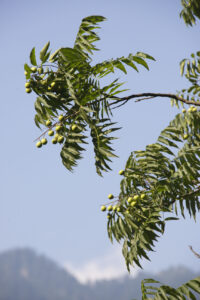
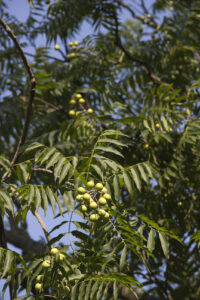
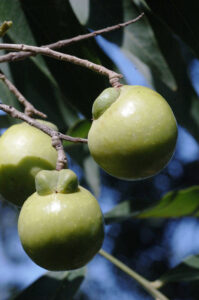
It is a deciduous, sometimes evergreen, often gregarious tree, to 40 m tall, with a broad and shady crown, noted for its bright red or scarlet spring foliage. It often spreads by suckers. The trunk, which is often crooked and slightly buttressed, may be up to 2 m in diameter. The leaves are pinnate, with 2-4 pairs of elliptic leaflets, margin entire, tip pointed or rounded.
The flowers are small, yellow, arranged in short terminal clusters. They appear in spring. The fruit is ovoid, to 3 cm long, sometimes abruptly tapering to a point.
The plant is host to a lac insect, Kerria lacca, which is native to India. The wood is very hard, utilized for construction, furniture, and houseware items. The leaves are lopped for fodder. The aril of the ripe fruit is edible, and an oil, called kusum, is extracted from the seeds. It is used for cooking and as lamp oil.
In Nepal, juice of the bark, and also the seed oil, is used for various skin diseases, and for ulcers, and the oil is applied in case of rheumatism. In India, the oil is applied to relieve headache and colds, and to promote hair growth in case of baldness.
The generic name was given in honour of Swiss botanist Johann Christoph Schleicher (1770-1834), who specialized in mosses, ferns, algae, and fungi. He founded a botanical garden in Bex.
The specific name is Latin, meaning ‘rich in oil’.
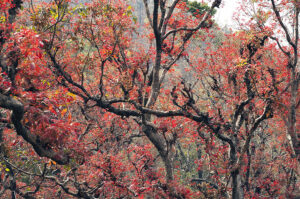
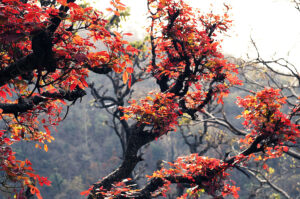
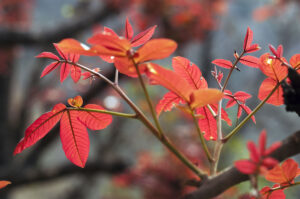
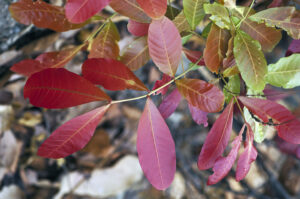
Stem ascending, hairy, to 50 cm tall, rooting at the lower nodes. Leaves alternate, broadly ovate or heart-shaped, to 10 cm long and 6 cm broad, usually hairless, densely glandular, 5-7-veined, purplish below, tip narrowed to a short point.
Flowers are tiny, green, in dense, erect, axillary, stalked, cylindric spikes, to 2.5 cm long and 6 mm broad, with 4-6 oblong or obovate white bracts at the base, to 1.5 cm long and 7 mm broad, tip rounded. Flowering occurs May-September. The fruit is globular, with 3 carpels.
In traditional Chinese medicine, this plant is called 魚腥草 (‘fishy-smelling herb’), utilized due to its antibacterial and antiviral effects, mainly for various respiratory diseases, including bronchitis and pneumonia, and also for herpes simplex and for urinary tract infections. As a paste, it is applied to various skin problems. In Japan, a decoction of the dried leaves is drunk to detoxify the body and to kill harmful bacteria.
In Nepal, juice of the root is used for indigestion and skin ailments, and it is dripped into the eyes in case of eye problems. Juice of the plant is applied to wounds of domestic animals to rid them of maggots and to accelerate healing. Elsewhere, it is used for diabetes, and as a diuretic. Tender parts and root are cooked in soups or as a vegetable, and the leaves are pickled.
The generic name was given in honour of Dutch biologist Maarten Houttuyn (1720-1798), who published a work in 37 volumes, Natuurlyke Historie of uitvoerige Beschryving der Dieren, Planten en Mineraalen, volgens het Samenstel van den Heer Linnaeus (‘Natural History with Elaborate Descriptions of Animals, Plants, and Minerals, following the Assembly of Mr. Linnaeus’, i.e. the division into animal kingdom, plant kingdom, and mineral kingdom). The specific name refers to the heart-shaped leaves.
The popular names fishwort and fish mint refer to the fishy odour of some varieties. An obsolete name of the plant is H. foetida, alluding to this smell. Cultivated varieties include forms with attractive 3-coloured foliage. These varieties are called chameleon plant, alluding to the ability of the chameleon to change colour.
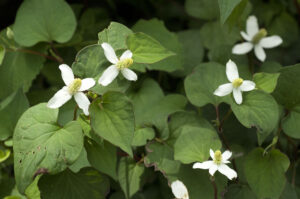
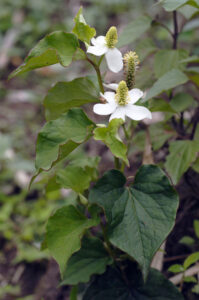
The generic name is derived from Ancient Greek a (‘not’) and stilbos (‘glittering’), alledgedly referring to the small and inconspicuous flowers. The common name alludes to the shape of the inflorescence, which, with a bit of imagination, resembles a goat’s beard. The prefix false was given to separate these plant from the quite similar true goat’s beards, genus Aruncus (Rosaceae).
Inflorescences are terminal, pyramid-shaped, branched, many-flowered, to 60 cm long, branches to 18 cm long, glandular-hairy. Petals usually absent, calyx cup-shaped, sepals 4-5, green or greenish-yellow, to 1.5 mm across, stamens 5, exserted. Blooming occurs June-September. Fruits are purplish-red, to 4 mm long, many-seeded.
It is distributed from Kashmir eastwards to northern Indochina and the Yunnan Province, and thence southwards to Borneo and Java. In the Himalaya, it grows in shrubberies, on open humid slopes, and along streams, at altitudes between 1,800 and 3,300 m.
In Nepal, juice of the plant is applied to sprains and muscular swellings. Juice of the root is given to stop excessive bleeding after delivery, and it is also used for peptic ulcer, diarrhoea, dysentery, prolapse of the uterus, and haemorrhage.
The specific name is Latin, meaning ‘growing along streams’.
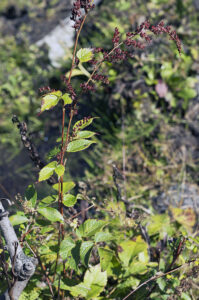
The generic name honours German botanist and physician Karl August von Bergen (1704-1759), whose most noted work is Flora Francofurtana, about the flora around Frankfurt an der Oder, published in 1750. He also wrote an essay on the rhinoceros.
Popular names of these plants include elephant’s ears, which refers to the large leaves, and pigsqueak, alluding to the sound produced, when two leaves are rubbed together.
The rootstock is very stout, creeping. Leaves all basal, short-stalked, blade obovate or rounded, base heart-shaped, at flowering to 15 cm across, enlarging to 30 cm in fruit, margin entire, with long, stiff bristles. Flowering stem erect, leafless, to 35 cm tall, inflorescence a dense, one-sided raceme, often pendulous, flowers to 2.5 cm long, calyx smooth, with blunt lobes, petals white, pink, or purplish, to 1 cm long and 4 mm broad. The flowering period is from March to July. The leaves turn bright red in autumn.
It is generally regarded as anti-inflammatory and anti-diabetic, and it may also be effective for treatment of cancer. In Nepal, juice of the plant is taken for urinary disorders, and juice of the rhizome is used for cough, colds, haemorrhoids, asthma, and urinary disorders. A paste of the rhizome is utilized for fever, colic, diarrhoea, and backache, and is also applied to boils. Juice of the leaves is dripped into the ears in case of earache. Members of the Gurung tribe drink a decoction of the rhizome for gout, and to improve digestion. The flowers are pickled.
The specific name is Latin, meaning ‘hairy’, alluding to the leaf margin.
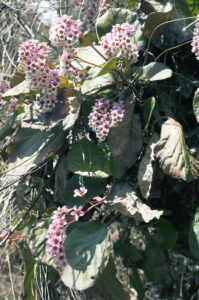
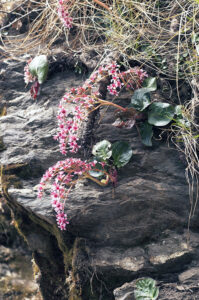
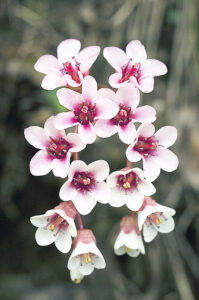
It grows in forests, shrubberies, and open areas, and on rocks, from central Nepal eastwards to Myanmar and the Yunnan Province, found at elevations between 3,600 and 4,800 m. It is common in eastern Nepal and Sikkim.
Bergenin from the plant is used medicinally.
The specific name is Latin, meaning ‘becoming purple’, alluding to the flowers.
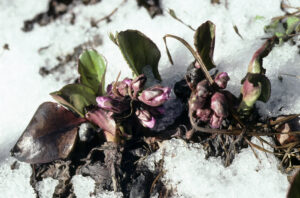
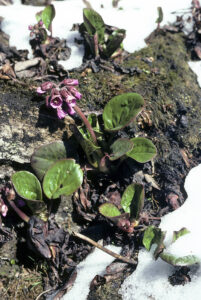
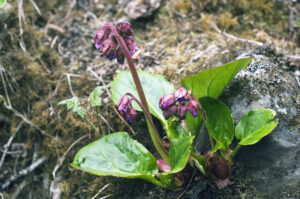
The generic name is derived from Ancient Greek khrysos (‘gold’), splen (‘milt’, ‘spleen’), and ion, a diminutive suffix, thus ‘the little golden one, shaped like a spleen’, alluding to the upper leaves of most species. The common name water carpet refers to the fact that many species in the genus form dense growths in wet areas.
Identification of members of this genus is notoriously difficult, and the plants in the pictures below are only tentatively identified.
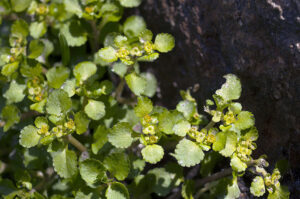
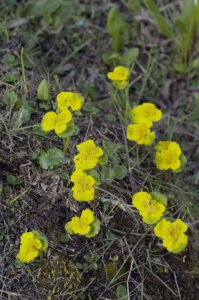
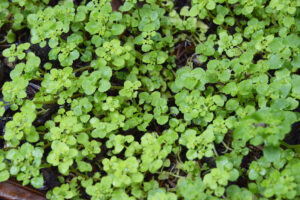
The generic name is derived from Ancient Greek mikros (‘small’) and anthos (‘flower’)’.
Almost all leaves are in a basal rosette, short-stalked, blade ovate, to 2 cm long and 1 cm wide, margin rounded-toothed or entire, smooth or downy. Stem leaves 1-2, if present at all, bract-like, lanceolate, sessile.
The flowering stem is erect, to 10 cm high, downy, flowers solitary or 2-3 together, stalked, bract leaf-like, to 5 mm long, linear, entire or toothed. Sepals ovate, to 4 mm long, smooth, pointed, reddish or pale green, petals as long as the sepals, ovate or elliptic, white with yellow dots near the base, filaments white, anthers orange, stigma pink. Flowering occurs June-September.
The specific name is Latin, meaning ‘the false (Micranthes) pallida’ – it is very similar to that species.
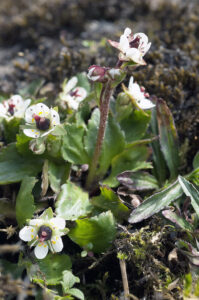
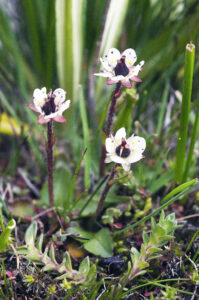
The generic name commemorates United States Rear Admiral John Rodgers (1812-1882), who commanded American troops in 1871 in the so-called Korean Expedition, known in Korea as the Shinmiyangyo (‘Western disturbance in the Shinmi Year’). In reality, this ‘expedition’ was a military action, whose mission was to ascertain the fate of the merchant ship General Sherman, which had gone missing while visiting Korea in 1866, and to demonstrate American power over a weaker nation. The Americans ‘peacefully’ entered Korean waters for survey and trade aboard heavily armed warships, ignoring repeated diplomatic requests to respect Korean sovereignty.
Stem to 1 m tall, leafy, leaves pinnately divided, leaflets 5-11, obovate or oblanceolate, to 20 cm long, margin sharply toothed, tip long-pointed. Inflorescence is a many-branched terminal cluster of numerous stalkless flowers, white, to 8 mm across, petals absent, calyx glandular-hairy, lobes lanceolate-triangular, stamens exserted. Flowering takes place June-July.
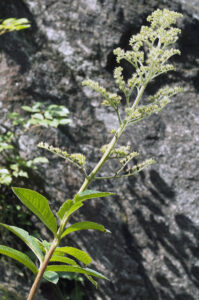
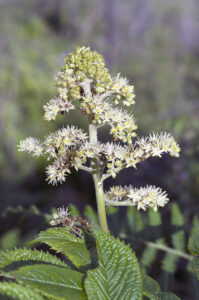
Literally, the generic name means ‘stone-breaker’, from the Latin saxum (‘rock’) and frangere (‘to break’). Rather than referring to the rocky habitat of many saxifrage species, it probably indicates the usage of one or more species for treatment of kidney stones and the like.
Many members of the genus are described on the page Plants: Flora of the Alps and the Pyrenees.
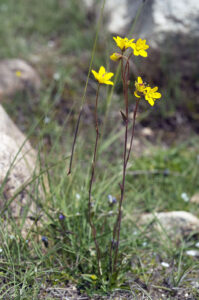
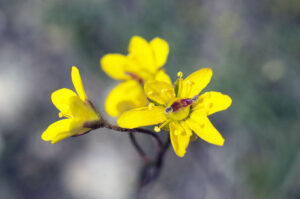
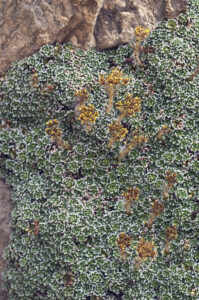
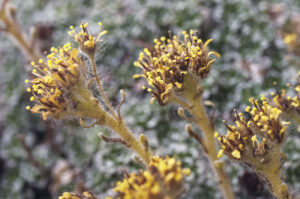
It grows in grasslands and on rocks at elevations between 3,400 and 5,500 m, found from western Nepal eastwards to Bhutan and south-eastern Tibet.
The specific name commemorates Scottish botanist Thomas Anderson (1832-1870), director of the botanical garden in Calcutta (today Kolkata).
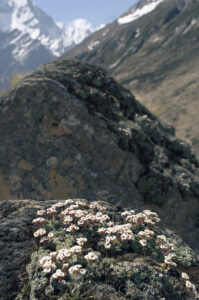
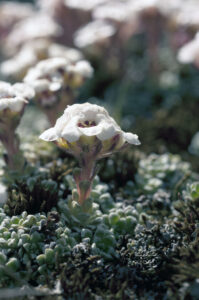
Flowers are solitary or 2-3 together, stalk long or short, glandular-hairy, petals golden-yellow, obovate or elliptic-ovate, to 9 mm long and 5 mm broad, sepals much shorter, to 5 mm long and 3 mm broad. Anthers reddish or dark brown. It blooms July-August.
It grows in a wide variety of habitats, including forests, banks, rock crevices, and grasslands, found at elevations between 3,000 and 5,000 m, from Uttarakhand eastwards to northern Myanmar and south-western China.
The specific name is derived from Ancient Greek brachys (‘short’) and podos (‘foot’). It may refer to the stem being covered in leaves all the way down, leaving the ‘foot’ of the plant very short.
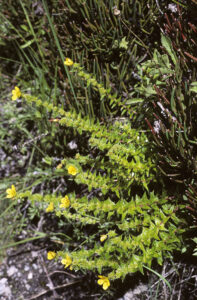
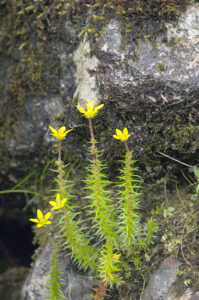
It is often a dense tangle of numerous red, slender, leafless runners, from which small, star-shaped, bright yellow flowers peep out. Basal leaves in a rosette, greyish-green, linear-lanceolate, stiff, to 1.3 cm long and 2.5 mm broad, margin with stiff hairs.
Flowering stems erect, red or purplish-brown, to 16 cm tall, stem leaves few, linear-lanceolate or oblong. Flowers usually 2-4 (sometimes up to 9) in a lax cluster, stalks glandular-hairy, petals bright yellow, elliptic, oblong, or lanceolate, to 8 mm long and 4 mm broad, sepals much smaller. Flowering occurs June-September.
The specific name probably commemorates Scottish botanist Robert Brown (see Delphinium brunonianum above).
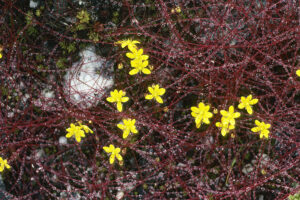
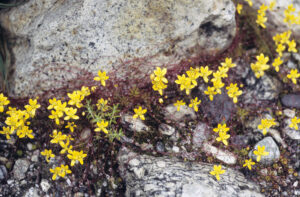
It is found from Pakistan eastwards to Bhutan and south-eastern Tibet, growing in stony areas and scree at altitudes between 3,900 and 5,200 m. It is common in Kashmir.
The specific name honours French botanist and geologist Venceslas Victor Jacquemont (1801-1832), who explored several areas in India, including Ladakh. He died of cholera in Bombay (today Mumbai), only 31 years old.
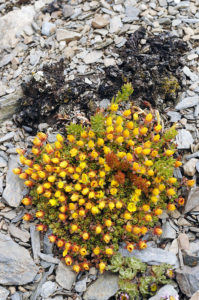
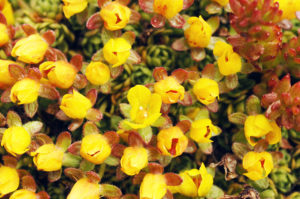
Inflorescences are axillary or terminal, to 8 cm long, with 1 to 12 flowers, stalk to 5 cm long, glandular-hairy, sepals erect or spreading, ovate or elliptic, to 5.5 mm long and 3 mm wide, glandular-hairy, petals obovate, bright yellow, often with tiny orange dots, to 1 cm long and 5 mm wide, tip rounded. Flowering period is August-September.
This plant grows in shrubberies and on open slopes at elevations between 3,500 and 4,500 m, distributed from Kashmir eastwards to Bhutan and south-western China.
The specific name was given in honour of British veterinary surgeon and botanist William Moorcroft (1765-1825), who explored several areas in the Himalaya and Central Asia. He was the first European to make botanical collections in western Tibet and Kashmir.
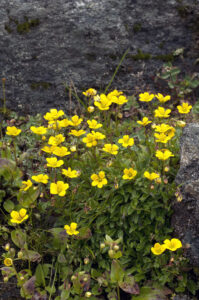
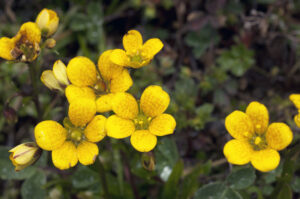
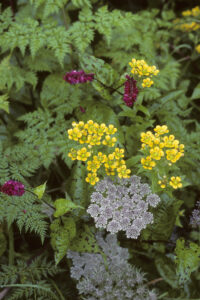
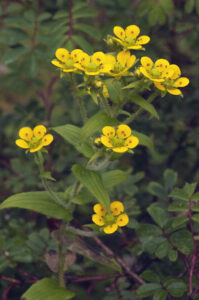
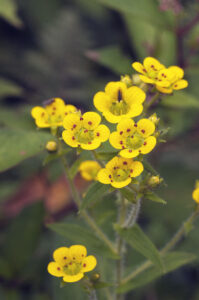
It is very similar to S. brunonis (above), but the runners are densely glandular-hairy, the basal leaves form a rosette, blade spathulate, to 1 cm long and 3 mm broad, margin with stiff bristles (not glandular), and a conspicuous terminal bristle.
Flowering stems grow to 5 cm tall, stem leaves densely overlapping, smaller than basal ones, upper stem and leaves glandular-hairy. Inflorescence is a terminal, dense cluster of up to 6 flowers, sepals erect, ovate, to 2.5 mm long and 1 mm wide, densely glandular-hairy, petals yellow, obovate or elliptic, to 4.4 mm long and 2.2 mm wide. It flowers July-August.
The specific name is Latin, meaning ‘with a small point’, alluding to the terminal bristle on the lower leaves.
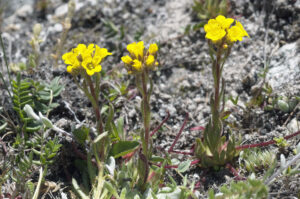
It is distributed from Himachal Pradesh eastwards to Bhutan and south-eastern Tibet, found in shrubberies and on open slopes at elevations between 1,900 and 4,900 m. It is common in Nepal.
The specific name is composed of the genus name Parnassia, and the Latin folius (‘leaf’), thus ‘with leaves like Parnassia‘. This genus is described on the page Himalayan flora 1, Celastraceae.
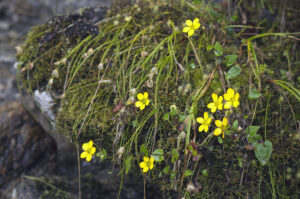
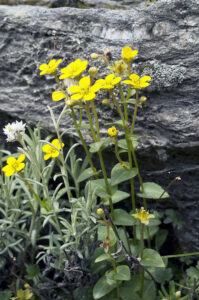
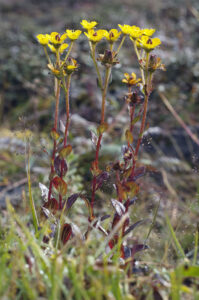
Stems are densely crowded, forming cushions to 50 cm across. Leaves gathered in rosettes, blade narrowly elliptic, to 3 mm long and 1.4 mm wide, leathery, hairless, with a lime gland, margin hairy, tip pointed.
The flowering stems, to 6 cm high, are hidden among the leaves, flowers terminal, solitary, sessile, sepals c. 1.5 mm long, ovate, blunt, glandular-hairy, petals oblong or obovate, to 5 mm long and 3 mm wide, white with yellowish or green base, margin undulating, sometimes lobed. It blooms June-August.
The specific name is Latin, meaning ‘pillow-like’, alluding to the plant’s cushion-form.
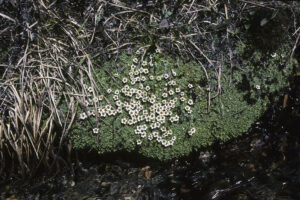
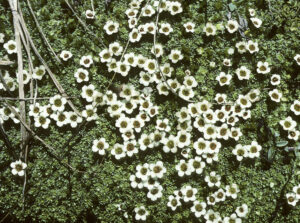
In Flowers of the Himalaya, by Polunin and Stainton, the distribution area of this species is central Nepal, at elevations between 3,300 and 3,800 m. If my identification of the plant in the picture below is correct, the area should also include eastern Nepal. Its habitat is stony areas.
The specific name was given in honour of British surgeon and naturalist John Forbes Royle (1798-1858), who is chiefly known for his works Illustrations of the Botany and other branches of Natural History of the Himalayan Mountains, and Flora of Cashmere.
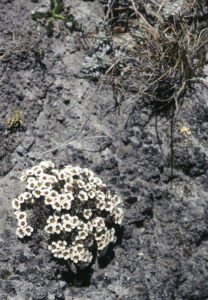
Inflorescences are terminal, usually few-flowered clusters, flowers with a long, glandular-hairy stalk, sepals erect, lanceolate or oblong, to 4 mm long and 1.8 mm wide, glandular-hairy, tip pointed or blunt, petals obovate, to 1.5 cm long and 5 mm broad, white with green veins in the throat. Flowering occurs May-August.
It is very widely distributed, from south-eastern Europe across the Middle East to central China, and from Russia eastwards to the Pacific Ocean, Alaska, and extreme north-western Canada. In the Himalaya, it grows at elevations between 3,000 and 5,000 m. Habitats include shrubberies, rock crevices, and damp open places.
European botanists will notice that this plant is quite similar to meadow saxifrage (S. granulata) of Europe.
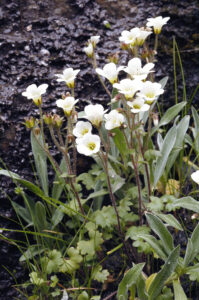
It is very similar to S. mucronulata (above), but the leaves are usually purplish-red, and the basal leaves do not have the long bristles along the margin, but instead shorter glandular hairs along the margin and on the surface. The plant is to 17 cm tall, petals to 1.2 cm long and 7.5 mm wide, yellow. Blooming takes place June-September.
The specific name is derived from Ancient Greek stenos (‘narrow’) and phyllon (‘leaf’).
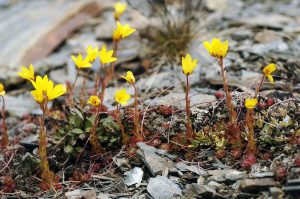
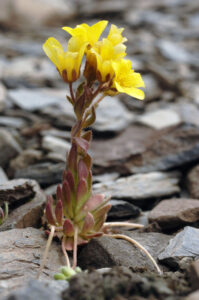
Flowers are solitary or in clusters with up to 10 flowers, sepals spreading, later reflexed, ovate or elliptic, to 3 mm long, with a short, sharp point, petals ovate or elliptic, to 5.5 mm long and 2.5 mm broad, pointed, white towards the tip, yellow towards the centre, sometimes spotted reddish-brown. Flowering occurs July-September.
It is distributed from Uttarakhand eastwards to northern Myanmar and south-western China, growing in forests and shrubberies, on banks, and on mossy rocks, at altitudes between 1,800 and 4,300 m. It is quite common in Nepal at lower altitudes.
The specific name is Latin, meaning ‘lean’ or ‘thin’ – a suitable name!
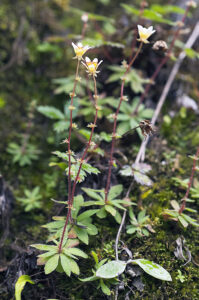
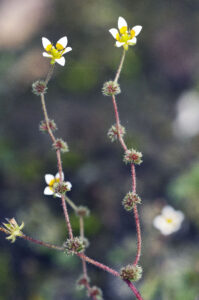
Previously, the family was much larger, comprising about 275 genera with more than 5,000 species. Following genetic research, the major part has been moved to other families, especially Plantaginaceae and Orobanchaceae.
These plants were formerly placed in the family Loganiaceae.
The generic name commemorates English priest and botanist Adam Buddle (1662-1715), an authority on mosses. The English name refers to the fact, that the fragrant flowers are much visited by butterflies.
Inflorescences are dense, cylindrical, terminal or axillary clusters, to 25 cm long, calyx bell-shaped, to 4.5 mm long, lobes triangular, corolla tubular, white, sometimes flushed with pale violet or green, tube to 1 cm long, downy, lobes 4, spreading, to 6 mm long, rounded. Flowering takes place November-April.
It is distributed from Pakistan and India eastwards to central China, and thence southwards through Indochina to Indonesia and New Guinea. In the Himalaya, it is common in open areas and shrubberies at lower elevations, between 300 and 1,800 m.
In Nepal, juice of the plant is applied to skin problems. Squeezed leaves are strewn in rivers to stupefy fish. The flowers are a source of perfume. They are brought as offerings in Hindu and Buddhist shrines. In Nepali, this species is called Bhimsen pati, dedicated to Bhimsen, the Newar god of trade.
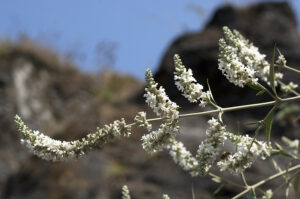
A variable shrub, to 5 m tall, all parts densely woolly-hairy. Leaves stalked or sessile, stalk often winged, to 4 cm long, blade lanceolate or ovate, usually less than 12 cm long, sometimes to 20 x 8 cm, base mostly rounded or heart-shaped, margin undulating, with large, rounded teeth, or sometimes lobed, tip pointed or blunt. It blooms from March to June.
Inflorescences are terminal clusters, sometimes interrupted, to 20 cm long, calyx bell-shaped, to 9 mm long, lobes ovate or triangular, to 2 mm long, corolla lilac, pale violet, or purple, with an orange throat, tube to 1 cm long, with short rounded lobes, margin often undulating.
The wood is used as fuel.
It is not clear what the specific name refers to.
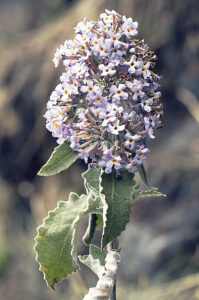
Inflorescences are terminal or axillary, branched and leafy panicles, to 25 cm long and 12 cm wide, flowers fragrant, calyx bell-shaped, to 4 mm long, lobes rounded or triangular, tiny, corolla to 1.2 cm long, white, pink, or pale mauve, with an orange throat, lobes rounded, spreading, to 2.5 mm long. It flowers in spring, between February and May.
It is distributed from western Nepal eastwards to northern Indochina and central China. In the Himalaya, it occurs at altitudes between 900 and 3,000 m, groaing in open forests and shrubberies.
In Nepal, a decoction of the leaves is used for fever, diarrhoea, and dysentery. In winter, the foliage is utilized as fodder. Young leaves are strewn in rivers to stupefy fish.
The specific name informs us that the inflorescences are panicles.
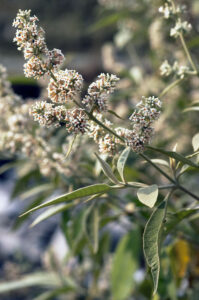
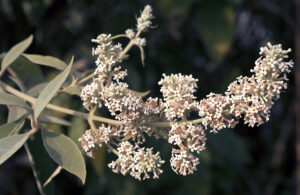
The generic name is derived from the Latin scrofulae, i.e. glandular swellings in the throat. These plants have lumps on the roots, which resemble scrofula swellings. Therefore, according to the Doctrine of Signatures, the Almighty God had placed these lumps to inform people of their usage against scrofula. Others maintain that it was the throat-like shape of the flowers of these plants that caused followers of the Doctrine to use it for scrofula.
The word scrofulae is Latin, a diminutive of scrofa (‘a breeding sow’), stemming from the belief that swine were often subject to this disease. Another, quite fanciful interpretation, compares the glandular swellings to little pigs.
The English name comes from the obsolete word fig (‘piles’) and wort. Presumably, the common figwort (S. nodosa) was used as a treatment for piles, also called haemorrhoids.
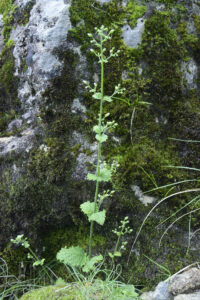
It is distributed from Afghanistan eastwards to western Nepal, growing on dry stony slopes at elevations between 2,600 and 5,000 m. It is common in Ladakh and Lahaul.
The specific name was given in honour of American zoologist and museum collector Walter Norman Koelz (1895-1989), who participated in several expeditions to the Himalaya and Tibet 1930-1946. During these trips, he collected about 30,000 birds and about the same number of plants.
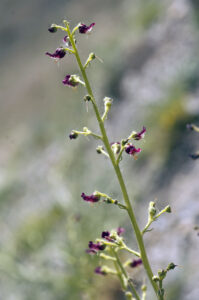
It is easily identified by the densely clustered, bright yellow flowers, and the leaves, which are hugging the ground as a means of protection against the strong winds that often blow on the Tibetan Plateau. All leaves are basal, forming a rosette close to the ground, blade thick, heart-shaped or ovate, to 8 cm across, wrinkled due to the strongly impressed veins, margin irregularly toothed.
The inflorescence is less than 5 cm tall, clustered at the centre of the rosette, calyx lobes 4, linear-lanceolate, corolla tubular, bright yellow, tube to 2.5 cm long, with 5 rounded, spreading, wavy lobes, margin with tiny teeth. Flowering occurs June-August.
The specific name was given in honour of Scottish physician and botanist George Watt (1851-1930), who worked in India in the field of economic botany. He published several volumes, titled The Dictionary of Economic Products of India.
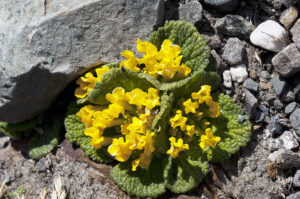
These plants have large flowers with 5 petals and 4-5 stamens, the filaments usually dense woolly-haired and often brightly coloured.
The generic name is probably a corruption of barbascum, from the Latin barba (‘beard’), in allusion to the shaggy foliage of many of the species, or maybe to the often woolly filaments. In his book The Popular Names of British Plants, Richard Chandler Prior (1809-1902) states that the word mullein was moleyn in Anglo-Saxon, and malen in Old French, derived from the Latin malandrium, i.e. the malanders (leprosy). He continues: “The term malandre became also applied to diseases of cattle, to lung diseases among the rest, and the plant being used as a remedy, acquired its names of mullein and bullock’s lungwort.”
The role of these plants in folklore and traditional medicine is described on the page Plants: Plants in folklore and poetry.
The stem is unbranched, leaves with yellowish woolly hairs, basal and lower stem leaves stalked, blade oblanceolate or oblong, to 15 cm long and 6 cm wide, margin entire, wavy, tip long-pointed. Upper stem leaves gradually decreasing in size upwards, becoming stalkless, base of blade winged down the stem.
Inflorescences are terminal or axillary, erect, dense, cylindric, woolly spikes, to 30 cm long, calyx to 7 mm long, with lanceolate lobes, corolla yellow, to 2.5 cm across, with 5 rounded, spreading lobes, stamens 5, filaments woolly-haired. In the Himalaya, flowering takes place from May to September.
In Nepal, a poultice of the root is taken to treat muscular swellings, and also diarrhoea. A paste of the plant is used for asthma, sore throat, cough, and constipation, and it is applied to wounds and skin rashes. The leaves are strewn in rivers to stupefy fish.
The specific name was first used by Greek scholar and botanist Theophrastos (c. 371-287 B.C.), in the form thapsos, for an unknown plant, growing in the Ancient Greek town of Thapsos, Sicily.
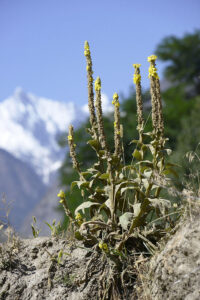
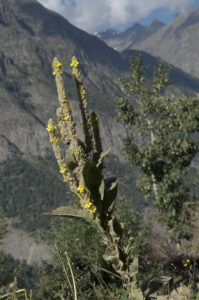
The fruit is a berry, bright red in most species.
The generic name is the Ancient Greek name of an unknown plant. The common names are derived from Old English brer, the term for thorny bushes.
These plants vary significantly, making them notoriously difficult to distinguish.
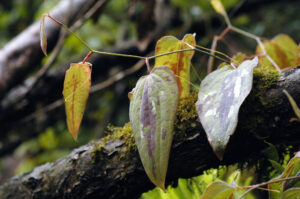
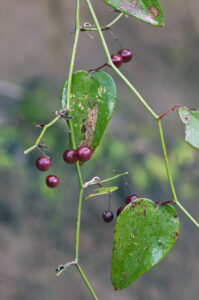
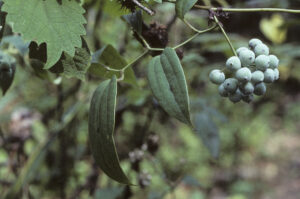
The generic name is derived from Ancient Greek anisos (‘unequal’) and odous (‘tooth’), presumably alluding to the leaves.
Stem to 2 m tall, branched above, leaf stalk to 4 cm long, leaves ovate or elliptic, to 25 cm long and 10 cm wide, underside often wolly-haired, margin entire, wavy, tip pointed.
It is distributed from Kashmir eastwards to south-western China, growing at elevations between 2,700 and 4,300 m. It is common on grazing grounds and around herders’ camps, and in fallow fields and wastelands.
In China, root and seeds are used medicinally for alleviating pain and spasms. In Nepal, smoke from burning seeds is inhaled to cure wounds in the nose. The foliage is collected and dried as winter fodder for yaks.
The specific name is derived from stramonium, the classical Latin term for thorn-apple (Datura, below), and folium (‘leaf’), thus ‘with leaves like thorn-apple’.
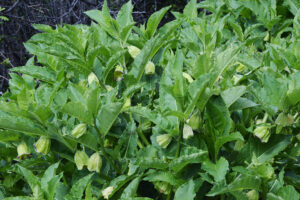
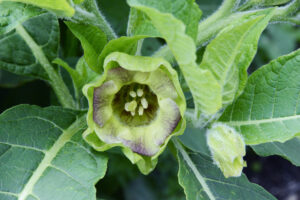
The generic name commemorates Dutch botanist and physician Sebald Justinus Brugmans (1763-1819), who is especially remembered for his expertise in the treatment of gangrene. The common name alludes to the trumpet-shaped flowers, which, however, are very poisonous, hence Angel’s, presumably the Death Angel.
It is native to Brazil, but is widely cultivated elsewhere due to the gorgeous flowers. In the Himalaya, it has become naturalized along fields and trails in the lower valleys, up to elevations around 1,700 m.
The specific name is derived from the Latin suavis (‘sweet’) and olens (‘fragrance’).
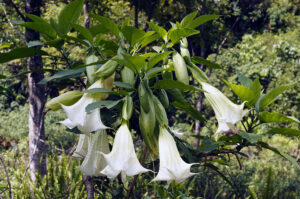
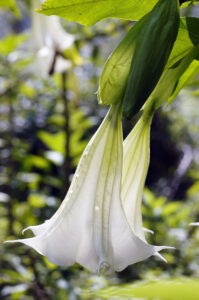
The generic name is the Hindi name of these plants, usually spelled dhatura. The common name alludes to the extremely spiny fruit.
It is a shrubby herb, foetid, to 1.5 m tall, smooth. Leaves stalked, blade broadly ovate, to 18 cm long and 14 cm broad, base asymmetric, with large teeth, tip pointed. Flowers are erect, short-stalked, to 12 cm long and 7.5 cm across, calyx tubular, with 5 ribs and lobes, to 6 cm long, corolla funnel-shaped, white or pale purple, greenish at the base, with 5 long-pointed lobes. It flowers between March and September. The capsule is globular or ovoid, to 7 cm long and 5 cm wide, covered in vicious spines. Ripening takes place June-November.
Soap is made from the seeds. Seeds and leaves are used as an anaesthetic, and for headache, arthritis, pain, and cough. In Nepal, a paste of leaves and seeds is applied to boils and sores. Leaves are pounded with water and applied to relieve headache. Juice of the flower is dripped into the ear to relieve earache. Juice of the fruit is applied to fight dandruff and hair loss. Smoke from frying seeds inhaled for toothache. Powdered fruits, mixed with bread, are used to kill mad dogs.
The specific name is the classical Latin term for thorn-apple, probably derived from the Latin struma (scrofulous tumor), for which an unknown species of the nightshade family was used as a cure.
The entire plant is extremely poisonous – a fact reflected in most of its popular English names, including mad apple, devil’s apple, hell’s bells, devil’s trumpet, devil’s weed, and devil’s snare. The popular names Jimsonweed and Jamestown weed refer to Jamestown, Virginia, where British soldiers, in 1676, attempted to suppress an armed rebellion by Virginia settlers. Some of the soldiers consumed thorn-apple, and as a result they spent the following 11 days in altered mental states, related on the page Plants: Plants in folklore and poetry.
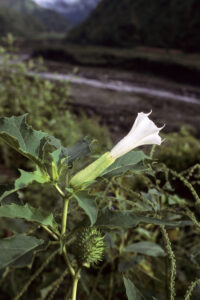
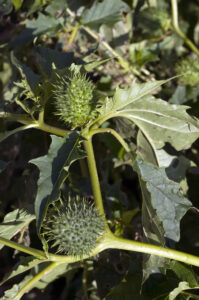
The generic name is derived from Ancient Greek hys (‘swine’) and kyamos (‘bean’), thus ‘hog bean’. It was told that pigs could eat these plants without being harmed. The English name seems to imply that chickens die from eating them.
This plant is native from the Mediterranean eastwards across the Middle East to central Siberia, Central Asia, and China, but has become naturalized in almost the entire Europe, the Americas, and Australia. In the Himalaya, it grows in waste areas and fallow fields, and along trails, found at elevations between 2,000 and 3,600 m.
An herb to 1 m tall, with a foetid smell, all parts covered in sticky glandular hairs. Basal leaves stalked, to 30 cm long, soon withering, blade elliptic, ovate, or oblong, coarsely and irregularly toothed or lobed, tip pointed. Stem leaves similar, but stalkless, to 10 cm long and 6 cm broad, margin lobed or entire.
Flowers are short-stalked, calyx funnel-shaped, to 1.5 cm long, with unequal triangular lobes, enlarging to 2.5 cm across in fruit, becoming hard and spine-tipped, encircling the capsule. Corolla bell-shaped, to 3 cm long and across, dull yellow with darker yellow or purple veins, and a dark purple centre. Stamens are exserted. In the Himalaya, flowering takes place May-September, and the fruits ripen July-October.
All parts are very poisonous. Leaves and seeds are used for treatment of spasms, pain, asthma, and whooping cough. Soap is made from the seeds. The plant plays a significant role in European folklore and traditional medicine, described on the page Plants: Plants in folklore and poetry.
The specific name is Latin, meaning ‘black’, presumably referring to the dark purple throat of the flower.
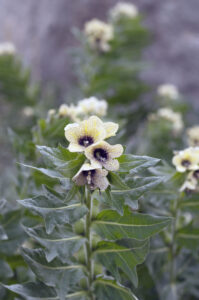
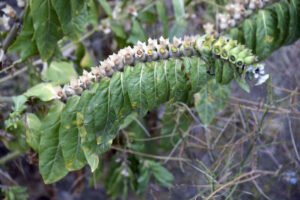
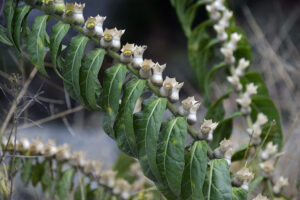
The generic name honours Greek poet, physician, and grammarian Nicander of Colophon, in Greek Nikandros of Kolophonios (2nd Century B.C.), who wrote in prose as well as verse, including two works on medicinal plants.
It is native to western South America, but has become naturalized in many parts of the world. In the Himalaya, it mainly grows along trails and fields, and in villages, found up to elevations around 2,600 m.
In Nepal, seeds are boiled, and the filtered water is taken for fever.
The specific name alludes to the resemblance of the fruits to those of tomatillo, genus Physalis, derived from Ancient Greek physa (‘bubble’), referring to the inflated calyx that surrounds the fruit. The common name also alludes to the fruit.
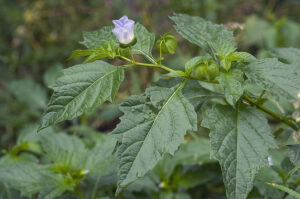
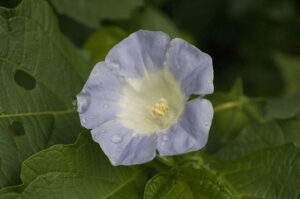
Anchored off the coast of what is today called Cuba, in November 1492, Cristoforo Colombo (1451-1506), in English known as Christopher Columbus, wrote in his journal that his messengers had seen natives carrying “some sort of cylinder, in which sweetly smelling herbs were glowing. These, they supposed, were dried herb stalks, covered by an equally dry but broader leaf. The people sucked the opposite end of the cylinder and, as it were, drank the smoke. Although this apparently intoxicated them, it also seemed to protect them from fatigue. The natives called these cylinders tabacos.”
The generic name commemorates French diplomat and scholar Jean Nicot de Villemain (1530-1604), who was the first person to send tobacco seeds to France. The French king promoted its usage, as smoking was believed to protect against illness, particularly the plague.
It grows to 1 m tall, stem branched. Leaves sessile, variable in size, 9-28 cm long, 3.5-9.5 cm wide, elliptic, oblong, or oblanceolate, margin entire, sometimes wavy. Inflorescences terminal, lax, to 15 cm long, flowers short-stalked, calyx to 9 mm long, with linear-lanceolate lobes, corolla pink, to 1 cm across, with a very slender tube to 4 cm long, and 5 spreading, pointed lobes. Blooming takes place between March and August.
The specific name refers to the leaves, which resemble those of some species in the genus Plumbago.
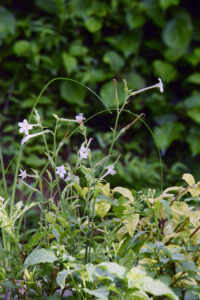
The generic name is derived from Ancient Greek physa (‘bubble’) and chlaina, a cloak worn by women in Ancient Greece. The name refers to the inflated calyx that surrounds the fruit.
This species is distributed in dry stony areas, from south-western Tibet and Pakistan eastwards to central Nepal, found at elevations between 2,400 and 4,600 m. It is common in Ladakh and Lahaul.
In Ladakh, seeds are used as a vermifuge, leaves in treatment of ulcer and eye diseases. The plant is an excellent source of atropine.
The specific name is Latin, meaning ‘very tall’.
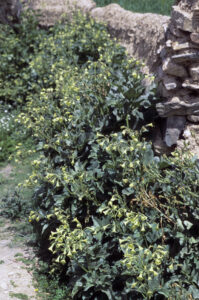
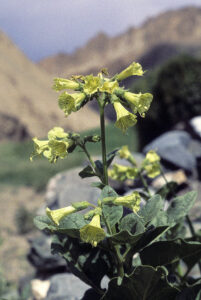
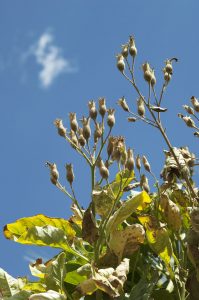
The generic name is of unknown origin, possibly derived from the Latin sol (’sun’) referring to the fact that plants of this genus prefer to grow in sunny places. The popular name is a corruption of an ancient Germanic name of these plants, Nachtschatten, of unknown meaning. As Schatten also means ‘shadow’ in German, the name nightshade was introduced, but apparently this is a misnomer.
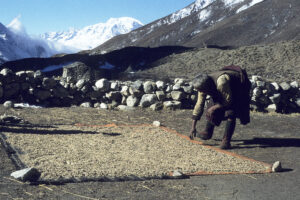
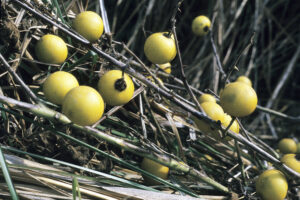
Inflorescences are axillary or terminal, many-flowered panicles, flowering stalk often branched, to 1.8 cm long, calyx cup-shaped, to 5 mm long, downy, lobes ovate or lanceolate, to 3 mm long, corolla white, to 1.5 cm long and across, lobes ovate or lanceolate, to 1 cm long, anthers erect, yellow, to 7 mm long. Fruit a yellow berry, smooth, to 1.5 cm across. Flowering and ripening of fruits take place year-round.
This plant is is native from Mexico eastwards across Central America to northern South America and eastern Brazil, but has been widely introduced elsewhere in warmer areas. In the Himalaya, it may be found up to altitudes around 2,000 m, growing in open areas, shrubberies, and fallow fields, and along trails.
Unripe fruits are pickled in Nepal. They are edible after cooking. In China, they are used medicinally for improving eyesight, leaves for treating skin diseases. In Nepal, juice of the plant is used for fever, cough, respiratory diseases, rheumatism, dropsy, and gonorrhea. Juice of the root is given to stop vomiting. Juice of the flowers is dropped into watering eyes. A paste of the ripe fruit is applied to the forehead to treat headache.
Two meanings of the Latin torvus are ‘fierce’ and ‘harsh’. The name may refer to the toxicity of nightshade species.
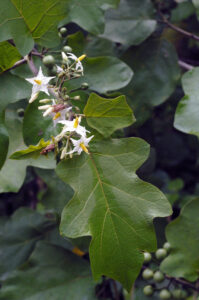
The generic name is derived from Ancient Greek symplokos (‘connected’ or ‘entwined’), alluding to the connected stamens and their adnation to the petals of the type species, S. martinicensis.
I have been told that the roots of certain species were formerly utilized in Nepalese witchcraft.
Inflorescences are terminal and axillary, much-branched panicles, to 10 cm long, hairy. Flowers to 1 cm across, fragrant, calyx tube to 1.5 mm long, with lobes to 1.5 mm long, petals 5, snow-white, elliptic or oblong, spreading, to 5 mm long and 2.5 mm broad, tip rounded. Stamens very numerous, causing the flower to look fluffy. Flowering occurs April-June. The fruit is ovoid or globular, to 6 mm long, bright blue, smooth.
This plant is grows in forests and shrubberies, distributed from north-eastern Pakistan eastwards across the Himalaya to northern China and Japan, and thence southwards to Taiwan and Indochina. In the Himalaya, it occurs at elevations between 1,000 and 2,700 m.
In Nepal, juice of the bark is applied to sprains and muscular swellings. Foliage is lopped for fodder. The bark yields a yellow dye.
The specific name refers to the inflorescences.
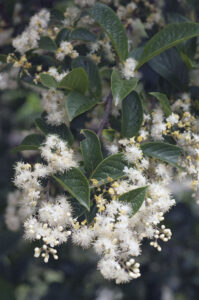
Leaf stalk to 2 cm long, blade narrowly elliptic, to 12 cm long and 3 cm wide, leathery, shining, base wedge-shaped, margin entire or sometimes with glandular teeth, tip long-pointed.
Inflorescences are small, to 4 cm long, calyx lobes ovate or triangular, sparsely silky-hairy, to 1.8 mm long, corolla yellowish-white, to 5 mm long, petals spreading, to 5 mm long. Stamens very numerous, causing the flower to look fluffy. Flowering takes place September-November. The drupe is brownish, cylindric or ellipsoid, to 1 cm long, smooth, crowned with the persistent calyx lobes.
In Nepal, oil from the seeds is applied to boils and burns.
The specific name is Latin, meaning ‘with leaves like Pyrus‘ (pears).
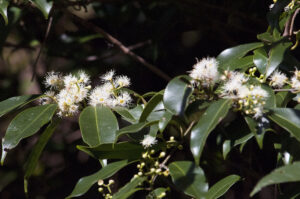
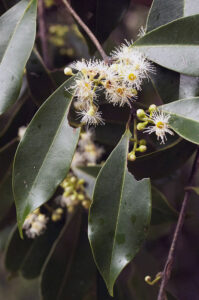
Inflorescences are downy-hairy spikes, to 3 cm long, borne in leaf axils, calyx lobes broadly ovate, to 1 mm long, with hairy margin, corolla to 6 mm across, snow-white, stamens very numerous, causing the flower to look fluffy. It blooms from April to July. The drupe is ellipsoid, to 1.2 cm long and 5 mm broad, initially green or yellowish-brown, blue-black at maturity.
It is distributed from Uttarakhand eastwards to northern Indochina and central China, growing in forests and shrubberies at elevations between 1,000 and 2,700 m.
In Nepal, oil from the seeds is used in cooking. The bark is boiled, and the water is applied to treat dislocated bones.
The specific name is Latin, meaning ‘with numerous branches’.
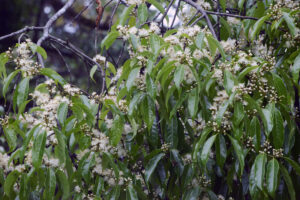
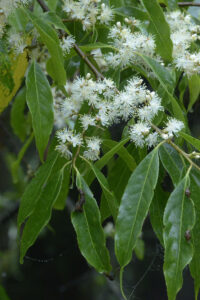
Many of the species grow on saline or alkaline soils. The leaves are often scale-like.
The flowers are arranged in long spikes. The seeds have long white hairs.
The generic name is composed of Ancient Greek myrike, the term for tamarisk, derived from Arabic murr (‘bitter’), and aria, a suffix that can be translated as ‘belonging to’ or ‘close to’.
Flowers are in terminal spikes, to 8 cm long, sepals lanceoalate or ovate, to 6 mm long, petals purplish-violet or purplish-red, obovate or elliptic, to 7 mm long. Bracts green, longer than flowers. Flowering takes place March-August. The capsule is conical, blue-green, to 1.5 cm long, ripening August-November.
It is distributed from central Nepal and southern Tibet eastwards to the Yunnan Province, growing on stony slopes, among rocks, and along gravelly streams, found at elevations between 2,600 and 4,600 m.
In Nepal, a paste of the plant is taken for colds, and is also applied in case of an aching back.
The specific name presumably refers to the flower colour.
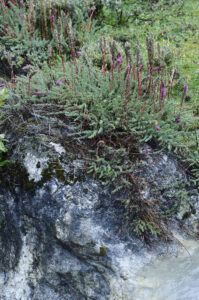
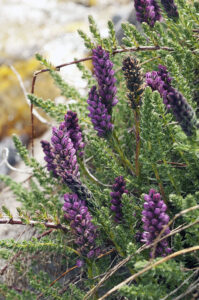
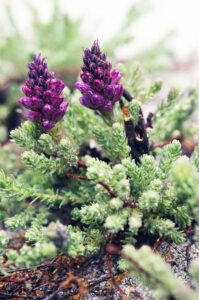
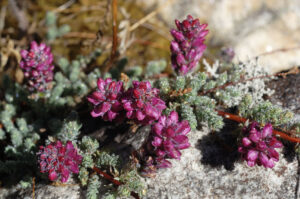
A shrub to 5 m high, erect. Old branches are purplish-brown, reddish-brown, or greyish-brown, twigs yellowish-green or reddish-brown. Leaves bluish-green, with salt glands, blade lanceolate or elliptic, to 8 mm long and 2 mm broad, margin entire, with a narrow membrane, tip rounded or pointed.
Flowers are arranged in lateral spikes, to 15 cm long, sepals oblong or elliptic, to 5 mm long, petals pink or purplish-red, elliptic to oblong, to 7 mm long. It blooms May-July. The capsule is conical, to 1 cm long and 3 mm broad., ripening July-August.
The specific name is Latin, meaning ‘scaly’, alluding to the tiny leaves.
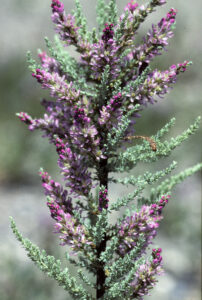
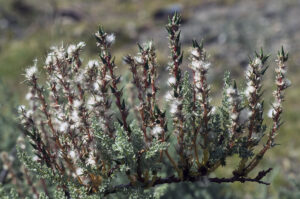
Stem to 5 m tall, old branches reddish-brown or dark purple, twigs green or reddish-brown. Leaves usually on the twigs, blade lanceolate or elliptic, to 1.5 cm long and 3 mm broad, margin entire, with a narrow membrane, tip rounded or pointed.
Flowers are in lateral spikes, to 25 cm long, inner part often sterile, sepals triangular, to 3 mm long, petals white, pink, or purplish-red, elliptic, to 7 mm long. Flowering occurs June-August. The capsule is conical, bluish-green, to 1 cm long and 3 mm broad, ripening August-September.
The generic name is composed of myrike, the Ancient Greek term for tamarisk, and tama(risk).
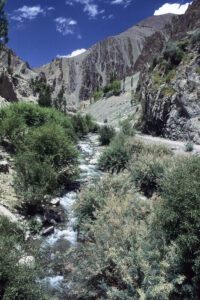
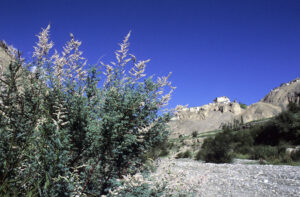
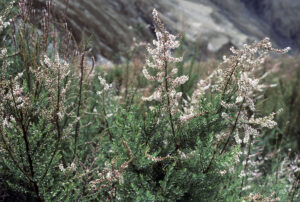
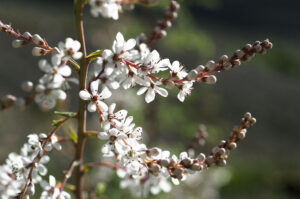
These trees have reddish bark, often peeling into large flakes. Needles are linear, flat, dark green above, pale green below, to 4 cm long and 3 mm broad. The cones are highly modified, each one containing only a single seed, surrounded by a bright red, fleshy, berry-like aril, which is edible. The seed, however, is very poisonous.
The generic name is derived from the Ancient Persian word for yew, taxs (‘bow’), referring to the fact that the Persians, and also the Scythians, made bows from its wood. The ancient Norse peoples also made bows from the wood, which were named dan, giving rise to the name of one of these peoples, the Danes.
The English name is derived from an ancient Proto-Indo-European word for these trees.
Male cones are ovoid, to 8 mm across, pink when ripe, later turning brown. Female cones axillary, solitary, with an aril that surrounds the seed, initially green and hard, becoming succulent and bright red, to 1.2 cm long and 9 mm across. Flowering occurs March-May, ripening of cones August-December.
It is distributed from eastern Afghanistan eastwards to western Nepal, occurring at elevations between 1,700 and 3,400 m. It mainly grows in the understorey of forests, occasionally on open slopes.
The wood is used for planks, beams, door and window frames, furniture, axles, tool handles, cups and other utensils. The wood is also burned as incense, and branches are used as fuel. A dye is extracted from the bark. The leaves yield a fish poison. The ripe aril is edible and sweet. The seeds, however, are very poisonous to humans, but are eaten by birds.
It is endangered due to over-exploitation.
The specific name is Latin, meaning ‘twisted’, presumably alluding to the growth of some specimens.
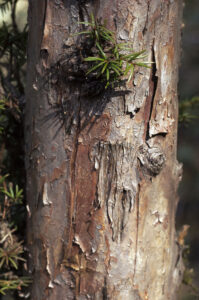
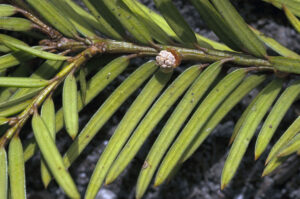
The generic name is derived from Ancient Greek skiazein (‘to overshadow’) and the suffix ma, alluding to the dense foliage of these trees.
It is common in Nepal, where it is called chilaune (’itching’). Beneath the bark, mature trees have a layer of hairs, which irritate the skin.
The bark is rough, dark grey, young branches greyish-brown, smooth, densely covered in white lenticels. Leaves short-stalked, blade elliptic or oblong, to 18 cm long and 7.5 cm broad, leathery, dark green and shining above, pale green below, base broadly wedge-shaped, margin entire or sparsely toothed, tip pointed, midvein impressed, veins reddish below.
Flowers are axillary, short-stalked, solitary or up to 3 together, fragrant, to 4 cm across, sepals rounded, to 3.5 mm across, petals white, broadly obovate, to 2 cm long and broad, tip rounded, stamens numerous, yellow. It blooms between April and June. The fruit is globular, woody, to 2 cm across, splitting into 5 valves, ripening November-April. It remains on the tree for many months.
This species is widely cultivated. In Nepal, the wood is used for construction and implements, and as fuel. Alcohol is made from the flowers. The toxic bark is chopped up and sprinkled into the water to stupefy fish, which float to the surface. Juice of the plant is used for gastric problems, peptic ulcer, and gonorrhoea. Root and young leaves are used for fever. A paste of the bark is used for wounds and scorpion bites, and it is fed to animals to rid them of liver flukes and intestinal worms.
The specific name was given in honour of Danish physician and botanist Nathaniel Wallich (see below).
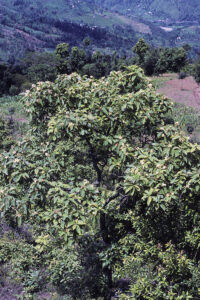
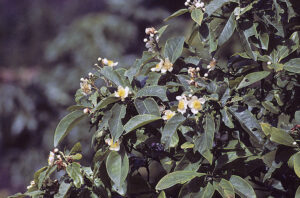
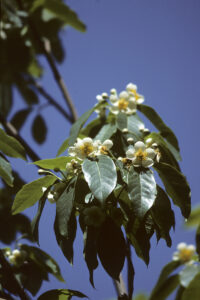
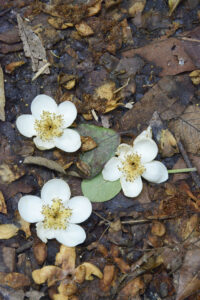
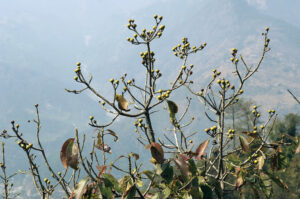
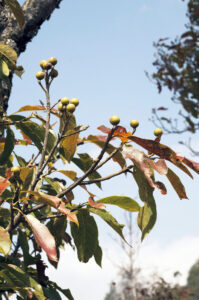
Wallich was involved in the early development of the Royal Botanic Garden, Calcutta, serving there until 1846, when he retired from the service. He went on numerous expeditions, and also offered his assistance to many plant collectors, who made a stop in Calcutta on their way to the Himalaya. Wallich prepared a catalogue of more than 20,000 plant specimens, and he published two books, Tentamen Florae Nepalensis Illustratae and Plantae Asiaticae Rariores.
After his retirement he stayed in London, where he became vice-president of the Linnean Society.

Many species are widely cultivated due to their extremely fragrant flowers. The fruit is a berry-like drupe.
The generic name is the classical Greek name of the laurel tree (Laurus nobilis). The name was given in allusion to the leaves of D. laureola, whose leaves resemble laurel leaves.
In Greek mythology, Daphne was a naiad, who was loved by the god Apollon. He pursued her until she grew exhausted and cried out to Gaia for help. The goddess transformed her into a laurel tree, which Apollon then adopted as his sacred plant.
Inflorescences are terminal or axillary, dense, stalkless clusters, with up to 12 fragrant flowers, white with pink or purplish tinge, tube silky-haired, to 1.2 cm long, with 4 broad, pointed, spreading lobes, to 8 mm long. In var. glacialis, the flowers appear before the leaves, sometimes in winter. In its broadest sense, the species flowers from October to April. The fruit is an ellipsoid drupe, to 8 mm long and 5 mm broad, black when ripe, which is between March and May.
It is found in forests and shrubberies, from Uttarakhand eastwards to northern Indochina and south-western China, and also in Bangladesh. In the Himalaya, it grows at elevations between 1,500 and 3,500 m.
In Nepal, paper and rope are made from the inner bark. Bark and leaves are strewn in rivers to stupefy fish. Juice of the root is used for fever and intestinal problems, a decoction of the bark also to relieve fever. Powdered seeds are taken to expel intestinal worms.
The specific name is derived from the Nepali name of the plant, bhulu swa.

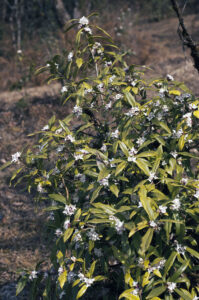
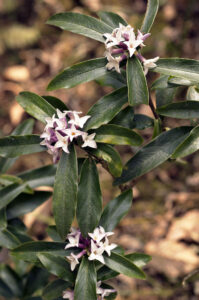
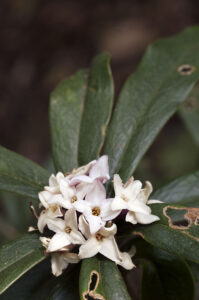
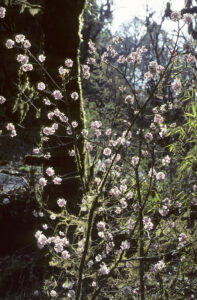
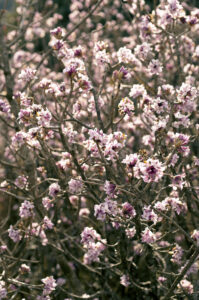
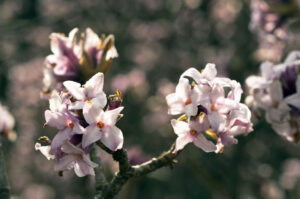
The generic name commemorates Irish botanist Michael Pakenham Edgeworth (1812-1881), who specialized in seed plants and ferns. He spent most of his life working in India.
It has numerous long, reddish-brown branches. Leaves short-stalked, elliptic or lanceolate, to 12 cm long and 3.5 cm broad, hairless above, silky-hairy beneath, narrowed to a short stalk, margin entire, tip long-pointed, lateral veins 8-9 pairs, prominent.
Inflorescences are dense, globular, pendent clusters, terminal or axillary, to 5 cm across, hairy, with up to 50 fragrant flowers. Corolla tube to 2 cm long, densely silky-hairy, lobes 4, ovate, golden-yellow, fading to whitish, to 3.5 mm long and 2.5 mm broad. It flowers in winter and spring, between November and April. The fruit is an ovoid drupe, densely downy, ripening April-May.
In Nepal, paper is made from the inner bark. Bark and leaves are strewn in rivers to stupefy fish.
The specific name honours Scottish botanist George Gardner (1810-1849), who is mainly known for his collections in Brazil and Sri Lanka (then Ceylon). His works include Musci Britannici, or Pocket Herbarium of British Mosses arranged and named according to Hooker’s “British Flora”, and Travels in the Interior of Brazil, principally through the Northern Provinces and the Gold Districts, during the years 1836-41. His material from Sri Lanka was never published due to his early death, which took place in Kandy, caused by apoplexy.
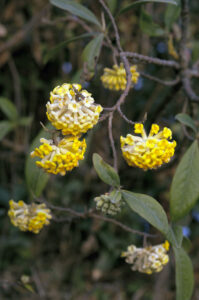
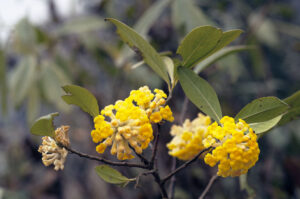
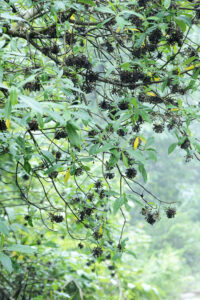
Stems many, clustered, erect, leafy, to 30 cm tall, green or purplish, hairless, base woody. Leaves alternate, numerous, overlapping, elliptic or lanceolate, papery, to 2.8 cm long and 1 cm broad, hairless, base rounded or wedge-shaped, margin entire, tip pointed, lateral veins 4-6 pairs.
Inflorescences are terminal, many-flowered, globular clusters, surrounded by an involucre of leaf-like bracts. Flowers fragrant, buds and the slender, cylindric, prominently ribbed tube, to 1.5 cm long, are reddish-purple, lobes 5, spreading, white or yellowish, ovate or oblong, to 4 mm long, usually with red veins. Flowering takes place April-July. The drupe is conical, dry, to 5 mm long and 2 mm broad, downy on upper part, enclosed in the persistent calyx.
In Nepal, a decoction of the root is used for asthma, aching joints, and skin problems, and also to expel phlegm and parasites. A decoction of bark is applied to sprains. Rope and paper are made from the root fibers. In traditional Chinese medicine, the root is used for treatment of tumours, and to destroy internal parasites, expel water retention, and clear phlegm.
The generic name commemorates German naturalist and explorer Georg Wilhelm Steller (1709-1746), born Stöhler, who participated in the Russian Great Northern Expedition (1733-1743), also known as the Second Kamchatka Expedition, led by Danish explorer Vitus Jonassen Bering (1681-1741). Steller is considered a pioneer of Alaskan natural history.
The specific name is derived from Ancient Greek chamai (‘near the ground’) and jasme (‘jasmine’), given in allusion to the low growth and the jasmine-like flowers.
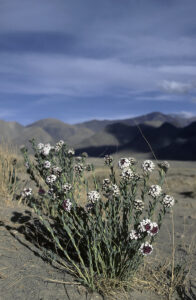
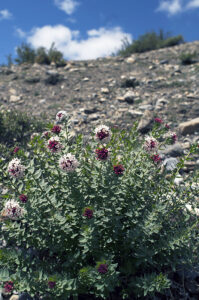
The generic name honours Swedish botanist Johan Emanuel Wikström (1789-1856). Between 1822 and 1855, he published 32 volumes, entitled Öfversigt af botaniska arbeten och upptäckter för åren 1820-51 (‘Overview of botanical works and discoveries for the years 1820-51’).
Inflorescences are terminal or axillary, globular clusters, 4-10-flowered, stalk to 2 cm long, sometimes with 2 tiny, leaf-like bracts. Flowers yellow, tubular, to 1.5 cm long, lobes 4, oblong, to 2.2 mm long, silky-hairy outside. They appear between May and September. The drupe is ovoid, to 4.5 mm long, black when ripe.
This plant is distributed from Afghanistan eastwards to northern Myanmar, and also in Bangladesh and Sri Lanka. In the Himalaya, it grows in shrubberies and open forests at altitudes between 1,800 and 3,500 m.
In Nepal, paper is made from the bark.
The specific name is Latin, meaning ‘becoming grey’. What it alludes to is not clear.
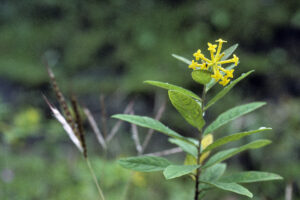
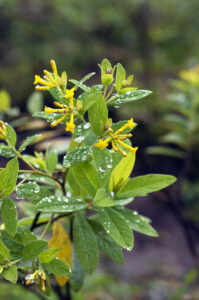
The fruit is a nutlet, surrounded by a wide, papery wing, to 1.5 cm across.
The generic name is the classical Latin word for elm.
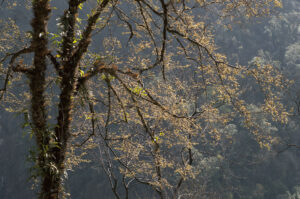

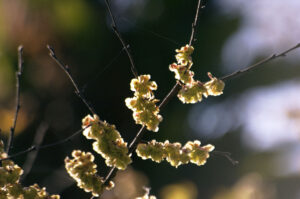
The genus was named in honour of German botanist and physician Georg Rudolf Böhmer (1723-1803), professor of botany and anatomy at the University of Wittenberg. He published a 5-volume work on natural history with the title Bibliotheca scriptorum historiae naturalis.
Stem to 3 m tall, leaves opposite, unequal in size and shape, ovate, rounded, or almost lanceolate, to 18 cm long and 12 cm wide, often covered in short, stiff hairs, base rounded or heart-shaped, margin saw-toothed, tip abruptly narrowed to a long point. Inflorescences are tiny globular heads, spaced along thin unbranched stalks from the leaf axils, to 20 cm long, pendulous or erect. Flowers occur June-September.
The specific name is Latin, meaning ‘with pendulous inflorescences’. Well, they are sometimes erect!
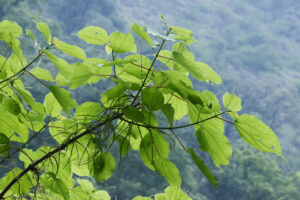
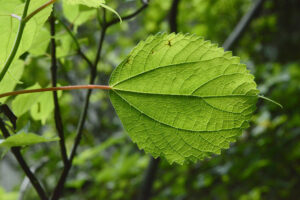
Inflorescences are tiny globular heads, spaced along thin unbranched stalks, pendent from the leaf axils, to 20 cm long. Blooming occurs from May to July.
It is distributed from Uttarakhand eastwards to Bhutan, growing at forest margins, and in shrubberies and shady ravines, found at altitudes between 1,000 and 2,300 m.
In Nepal, tender parts are cooked as a vegetable, and the foliage is lopped for fodder. Juice of the leaves is applied to boils.
The specific name is derived from the Latin ter (‘three times’) and folium (‘leaf’). What it refers to is not clear. The leaves are opposite.
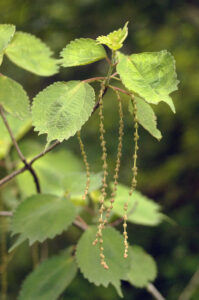
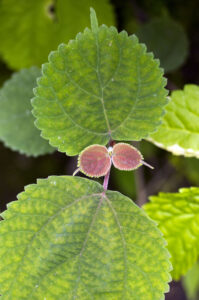
Inflorescences are spikes with tiny, globular, interrupted clusters of small greenish-white or pink flowers, male ones erect, to 15 cm long, female ones pendulous, to 30 cm long, style exserted, very long and thread-like. Flowering takes place July-October.
This variety is distributed from the Indian Subcontinent eastwards to Indochina. It is very common in the Himalaya, growing in forests and shrubberies, and along streams, at altitudes between 800 and 2,700 m. The species, in its wider sense, is found in Tropical Asia, New Guinea, eastern Australia, Tropical Africa, and Madagascar.
In Nepal, juice of the root is given to treat bloody dysentery. A paste of the bark is applied to boils. Juice of the leaves is applied to wounds. A decoction of the plant is given to cattle to treat diarrhoea and dysentery. A strong fibre is obtained from the bark, excellent for making rope and fishing nets.
The specific name is derived from the Latin virga (‘staff’), presumably referring to the straight inflorescences of this plant. The variety name is derived from Ancient Greek makros (‘long’ or ‘large’) and stakhys (‘spike’).
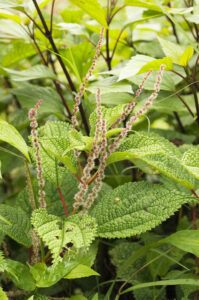
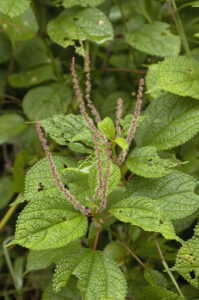
These plants are without stinging hairs. Male and female flowers are on separate plants. Fruit fleshy, resembling raspberries (Rubus).
The genus name commemorates Frenchman Justin Prosper de Bregeas (born around 1807), naval officer on board the corvette La Bonite during a scientific expedition to the Far East and other places 1836-37. The botanical results of the trip were published by Charles Gaudichaud (1789-1854) in the book Voyage autour du monde : exécuté pendant les années 1836 et 1837 sur la corvette La Bonite (‘Journey around the Earth, carried out in the years 1836 and 1837, on board the corvette La Bonite’).
Stem to 5 m tall, branches and leaf-stalks softly white-haired, leaves alternate, stalked, lanceolate, to 15 cm long and 3 cm broad, white-woolly beneath, rough above with prominent impressed veins, margin toothed, tip long-pointed.
Inflorescences are in stalkless axillary clusters to 1 cm across. Calyx of male flowers bell-shaped, streaked orange-red and white, downy, 4-lobed, stamens 3-5, exserted, anthers pale purple. Female flowers with narrowed mouth, stigma like a tuft of hairs. Blooming occurs March-June. The amber or orange fruit is fleshy, raspberry-like, to 1.5 mm across, ripening May-July.
In Nepal, the wood is used for fuel, and rope is made from the bark. Foliage is lopped for fodder. Ripe fruits are edible and sweet.
The specific name refers to a place in Yemen. The species was described by Swedish naturalist Pehr Forsskål (1732-1763) during a Danish expedition to Yemen and other places in the Middle East 1761-67. Forsskål often applied local Arabic names to the plants and animals that he described. His fascinating, albeit short life is related on the page People: Pehr Forsskål – brilliant Swedish scientist.
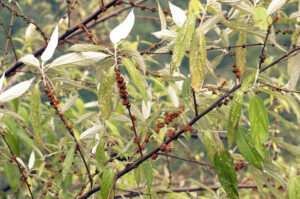
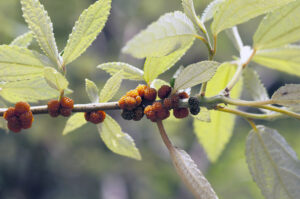
These plants are without stinging hairs.
The generic name is derived from Ancient Greek elatos (‘protruding’), and stemon (‘thread’), in a botanical context referring to stamens.
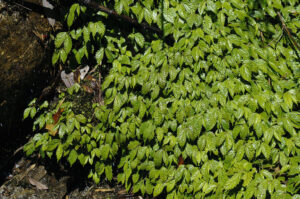
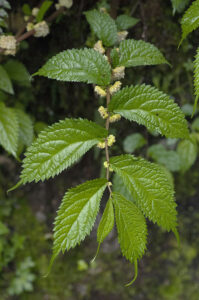
A small herb, stems ascending or erect, usually unbranched, hairy, to 20 cm tall/long. Leaves usually smooth, elliptic or lanceolate, with unequal base, one side wedge-shaped, the other rounded, to 6 cm long and 2 cm wide, margin lobed towards the long-pointed tip, two major veins arising at the base of the blade.
Male and female inflorescences are on separate plants, axillary, solitary, simple, male ones to 2 mm across, female ones to 5 mm across. Flowering takes place between June and October.
The specific name is derived from Ancient Greek monos (‘one’) and andros (‘man’), thus ‘with one male’, alluding to the male flowers having a single stamen.
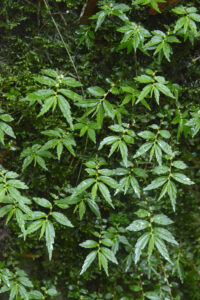
These plants are shrubby herbs with stinging hairs.
The generic name was given in honour of French agricultural chemist Jean Pierre Louis Girardin (1803-1884), who became professor of applied chemistry in Rouen in 1828. He published a number of works, including Nouveau manuel de botanique (‘New Manual of Botany’, Paris 1827).
Male and female inflorescences may be on the same plant or on separate plants, densely armed with stinging hairs. Male flowers are in axillary, branched spikes, yellowish or reddish, each side-branch to 11 cm long, female spikes spreading or dense, pale green, to 28 cm long. Flowers tiny, yellowish or greenish, to 2 mm across, appearing July-October.
It is distributed from the Indian Subcontinent eastwards to north-eastern China and Korea, and thence southwards to Indonesia, and also in Africa south of the Sahara and in Madagascar. In the Himalaya, it may be observed in shrubberies and open areas, along trails, and in villages, at altitudes between 1,200 and 3,000 m.
Tender parts may be eaten as a vegetable, and the seeds are roasted and pickled. It is cultivated in India for its stem fibres, which supply excellent bast to make cloth, bags, rope, and fishing nets. The plant yields a blue dye. In north-eastern India, the seeds are strewn in rivers to stupefy fish.
In Ayurvedic medicine, it is used as a diuretic and laxative, to treat headache, arthritis, rheumatism and allergy, and to expel intestinal parasites. In Nepal, juice of the root is used for constipation, juice of the leaves for headache, aching joints, and fever. Ash of the plant is applied to ringworm and eczema.
The specific name is Latin, meaning ‘with diverse leaves’. The common name alludes to a mountain range in southern India.
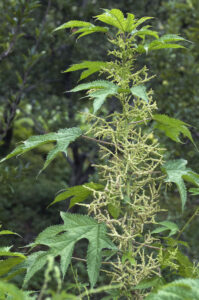
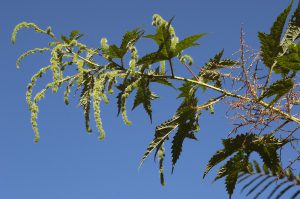
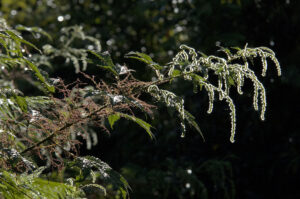
These plants are without stinging hairs.
The generic name is derived from Ancient Greek lekane (‘bowl’) and anthos (‘flower’), presumably alluding to the rounded inflorescence.
Stems creeping or ascending, often rooting at the nodes, branched, hairless, fleshy, to 70 cm long. Leaves short-stalked, opposite, unequal, ovate or lanceolate, to 15 cm long and 6.5 cm broad, margin saw-toothed, nerves impressed, prominent. Flowers tiny, pink, in a globular cluster on a saucer-like receptacle, sometimes up to 7 cm across, often borne on a leafless stalk to 30 cm tall. Blooming takes place July-October.
In Nepal, young shoots are cooked as a vegetable. The foliage is fed to cows to increase milk production. Juice of the plant is given for fever. The pounded root is applied to sprains.
The specific name alludes to the long inflorescence stalk.
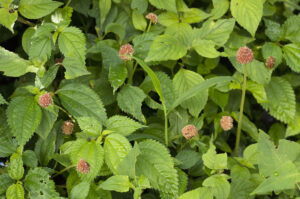
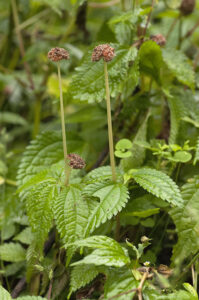
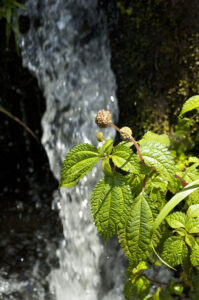
These plants are without stinging hairs.
The generic name is derived from the Latin pilleus (‘felt cap’). In Roman times, the soldiers wore hats with felt along the brim. In this genus, the stigma is a tuft of felt-like hairs.
Male and female inflorescences may be on the same plant or on separate plants, flowers tiny, white or pinkish, in axillary, much-branched, spreading clusters, stamens 4, white, stigma with a tuft of hairs. Flowering occurs June-September.
It is distributed from Pakistan eastwards to northern Myanmar and the Yunnan Province, growing in shady forests and shrubberies at altitudes between 1,000 and 3,000 m.
The specific name is Latin, meaning ‘written’ or ‘drawn’, alluding to the beautiful nerve pattern on the leaves.
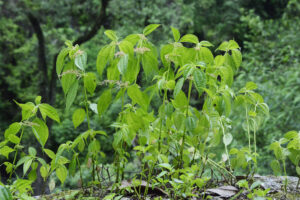
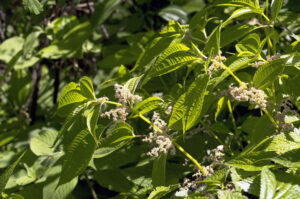
Stem erect, often branched, densely hairy, to 60 cm tall. Leaves opposite, stalked, elliptic or ovate, downy, to 15 cm long and 10 cm broad, with 3 longitudinal and many lateral impressed veins, base asymmetric, rounded or wedge-shaped, margin toothed, tip long-pointed. It blooms May-August.
Flowers tiny, greenish-white, pinkish, or purple. Male inflorescence a widely branched, spreading cluster, to 16 cm long, female clusters to 6 cm long.
In Nepal, tender parts are cooked as a vegetable.
The specific name is Latin, meaning ‘growing in shady places’.
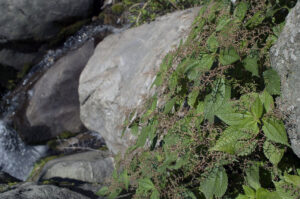
These plants have stinging hairs.
The generic name is the classical Latin word for nettles, of unknown origin. Previously, it was supposed to originate from uro (‘to burn’), alluding to the stinging hairs, but this has since been rejected, since that verb has a stem ending in ‘s’, and so should have been ustica instead. (Source: A. Ernout & A. Meillet 1985. Urtica, in Dictionnaire étymologique de la langue latine: histoire des mots, 4th ed., Paris 2001)
It is distributed from Pakistan eastwards to Bhutan and south-western China, growing at elevations between 1,000 and 4,500 m. Habitats include shrubberies, streamsides, villages, and along trails.
In Nepal, this plant is used medicinally for a large number of ailments, including asthma, fever, jaundice, cough, and colds. Young parts are cooked as a vegetable or in soup. Dried plants are collected for fodder. Stem fibres are used to make bags, fishing nets, and rope.
The specific name is Latin, meaning ‘glowing’. What it refers to is not clear.
The nettles in the pictures below are tentatively identified to U. ardens. However, they might instead be the widespread common nettle (U. dioica), which is very similar, but tends to have reddish, more downy stems.
The role of nettles in European folklore is related on the page Plants: Plants in folklore and poetry.
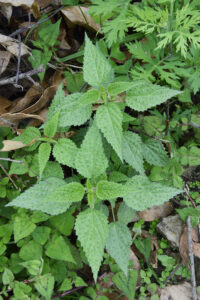
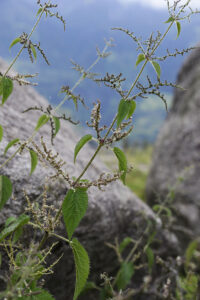
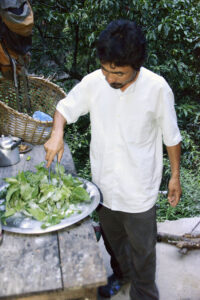

The generic name was given in honour of Italian physician, botanist, and poet Gualdo Tadino (1529-1590), better known as Castore Durante da Gualdo. He was chief physician of Pope Sixtus V. The common name alludes to the fruits, which are sometimes tear-shaped.
An erect, ascending, or scrambling shrub, to 3 m tall, branches usually spiny, downy when young, spines to 1.5 cm long. Leaves opposite, short-stalked, ovate, elliptic, or lanceolate, to 6.5 cm long and 3.5 cm wide, base wedge-shaped, margin entire or sometimes with a few rounded teeth.
Inflorescences are terminal, pyramidal, branched clusters of tubular, fragrant, lavender or pale blue flowers with paler centre and tube, to 1 cm long and across, lobes rounded, spreading. Calyx brown, half as long as the tube, with tiny linear lobes. In the Himalaya, flowering occurs between May and December. The fruit is a drupe, orange or yellow when ripe, globular or sometimes tear-shaped, to 5 mm across.
Unripe berries are toxic and are known to have killed children, dogs and cats. Birds, however, are not harmed by them. In Nepal, an infusion of the leaves is used to reduce fever and is also regarded as a diuretic.
Other common names of this plant include pigeon berry and skyflower, and in Tonga the fruit is known as mavaetangi (‘tears of departure’).
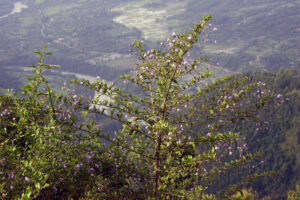
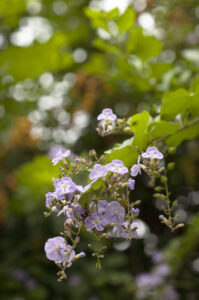
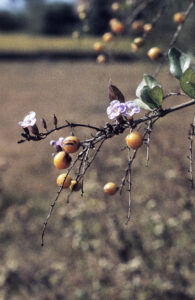
In Late Latin, and in several dialects in Italy and Switzerland, lantana was the name of members of the genus Viburnum, and the name was also used in 1583 by Flemish physician and botanist Rembert Dodoens (1517-1585) for the Guelder rose (Viburnum opulus). Swedish naturalist Carl Linnaeus (1707-1778) applied the name to the new genus, presumably because he found some similarities between the two genera.
Inflorescences are dense terminal umbels, to 3 cm across, flowers to 8 mm across, of many different colours, including red, orange, yellow, pink, or white, often several colours in a single inflorescence. Corolla tube to 1 cm long, with 4 spreading lobes, rounded or pointed, often of unequal size. In the Himalaya, it flowers June-October. The fruit is a globular drupe, to 5 mm across, fleshy, black, shining.
It is native to the American tropics, but due to its pretty flowers it has been introduced almost worldwide. In warmer countries it often escapes, and as it is toxic to grazing animals, it often forms large thickets, out-competing natural vegetation. It is regarded as a pest in many places, particularly so in Corbett National Park, Uttarakhand. In the Himalaya, it is found in cultivated areas, forests, and shrubberies, and along trails, up to elevations around 1,500 m.
Ripe fruits are edible. In Nepal, a decoction of the plant is used for rheumatism, and juice of the plant is taken for malaria. A decoction of the root is used for influenza, mumps, and cough. Juice of the leaves is applied to eczema, a paste of the leaves to sprains. An infusion of the flowers is used for cough, colds, fever, and jaundice.
The specific name is a Latinized form of Ancient Greek kamara, meaning ‘with an arched cover’. It is not clear what it refers to.
This plant has a number of alternative common names, including feston rose plant and West Indian lantana. Two of the flower colour forms, red and yellow, have given rise to the name Spanish flag, due to the similarity of these colours to the ones in the Spanish national flag.
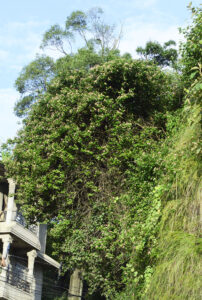
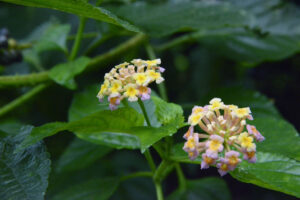
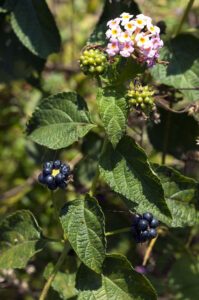
The generic name, and with that the English name, is explained in various ways. According to one authority, it is derived from the Latin verber, meaning rod or stick. Thus, it seems, Swedish naturalist Carl Linnaeus (1707-1778) applied the name Verbena to V. officinalis in allusion to its stiff, rod-like branches and stem. Others claim that it stems from verbena, the Roman name of altar plants. A third source says that it is derived from the Celtic word ferfaen, meaning ‘to drive away stones’ – it was thought that the plant was an effective remedy for kidney stones.
An erect herb, to 1.4 m tall, rather woody at the base, branched above, branches 4-angled, rough. Leaves narrowed to a stalk, to 4 cm long, blade ovate, obovate, or oblong, to 8 cm long and 5 cm broad, hairy, margin coarsely toothed or often deeply pinnately lobed, upper leaves sessile. Spikes slender, terminal, to 20 cm long, calyx to 4 mm long, glandular-hairy, corolla pale pink or purplish, tube to 8 mm long, unequally 5-lobed, hairy. Blooming occurs June-October.
Vervain tea is taken for headache, migraine, nausea, urinary tract infection, and menstrual irregularities, and also for anxiety and nervous tension. It is an excellent remedy for poor appetite and has been used successfully to treat anorexia nervosa. It is also an effective diuretic, and it is said to improve liver and gall bladder functions. In Nepal, a paste of the root is applied to the forehead to treat headache. In Pakistan, the root is used as a cure for scorpion and snake bite.
Originally, the specific name was derived from officina (‘workshop’, or ‘office’), and the suffix alis, which, together with a noun, forms an adjective, thus ‘made in a workshop’. However, in a botanical context, the word denotes plants species that were sold in pharmacies due to their medicinal properties.
The role of the plant in European folklore is related on the page Plants: Plants in folklore and poetry.
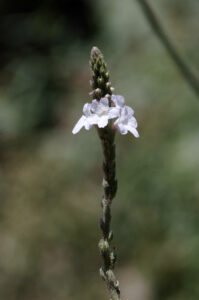
In the past, the genera Sambucus and Viburnum constituted the family Sambucaceae, but were then transferred to the honeysuckle family (Caprifoliaceae), and later to the moschatel family (Adoxaceae), which is today called Viburnaceae. The previously accepted genera Sinadoxa and Tetradoxa have been merged with Adoxa.
The generic name is derived from Ancient Greek sambuca, the name of an ancient instrument of Asian origin. The soft pith was removed from the twigs to make flutes. The name elder is derived from Anglo-Saxon aeld, meaning ’fire’ – the hollow stems were used to kindle a fire. The popular names pipe tree and bore tree stem from the habit of removing the pith of elder branches to produce pipes. The same procedure would make pop-guns, which were popular among small boys. English herbalist Nicholas Culpeper (1616-1654) writes: ”It is needless to write any description of this, since every boy that plays with a pop-gun will not mistake another tree for the elder.”
Elders in folklore, and their usage in folk medicine, is described on the page Plants: Plants in folklore and poetry.
A woody herb with striated stems, growing to 2 m tall, usually gregarious and often forming large clumps. The pinnately divided leaves are to 30 cm long, usually with 9 elliptic or lanceolate, sharply toothed leaflets, to 15 cm long, often long-pointed.
The tiny white flowers, to 5 mm across, are arranged in terminal, many-branched, flat-topped clusters, to 25 cm across. It blooms between May and September. The fruit is a globular, berry-like drupe, to 5 mm across, orange or red, ripening August-October.
The berries are edible.
In a botanical context, the term adnate refers to a structure, which is fused to a structure different from itself. What it refers to in this species is not clear.

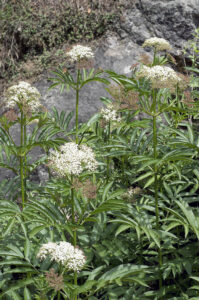
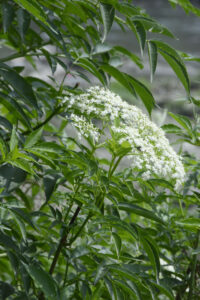
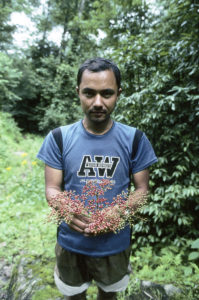
This plant is common on open slopes and grazing grounds in the western parts of the Himalaya, distributed from Afghanistan eastwards to Himachal Pradesh, at altitudes between 1,500 and 3,600 m.
Fruit, root, and leaves are utilized medicinally.
The specific name was given in honour of Scottish surgeon and botanist Robert Wight (1796-1872), who spent most of his life in southern India, where he was the leading botanical taxonomist, describing 110 new genera and 1,267 new species. He published a series of illustrated works in Madras, including the six-volume Icones Plantarum Indiae Orientalis (1838–53), the Illustrations of Indian Botany (1838–50), and Spicilegium Neilgherrense (1845–51).
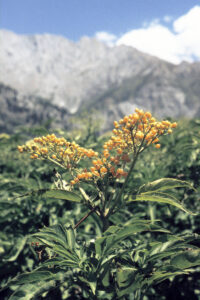
The generic name is the classical Latin name of a European species, Viburnum lantana, described on the page Plants: Flora of the Alps and the Pyrenees.
Inflorescences appear with the leaves, a rather small, terminal, umbel-like cluster, to 10 cm across. The corolla, to 8 mm across, is red or pink outside, pure white inside, tube to 6.5 mm long, the spreading lobes to 4 mm long. Flowering occurs April-June. Initially, the ellipsoid fruit is red, later turning black, to 1.2 cm long and 6 mm wide. Ripening period is from July to October.
This species is distributed in forests and shrubberies, from Afghanistan eastwards to Bhutan, at altitudes between 1,800 and 3,600 m.
The specific name is Latin, meaning ‘with leaves like Cotinus‘, i.e. the smoke tree (Cotinus coggygria). This shrub is described on the page Plants: Flora in Turkey.
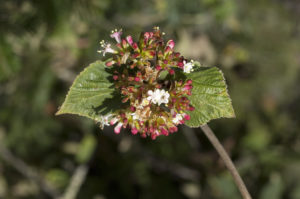
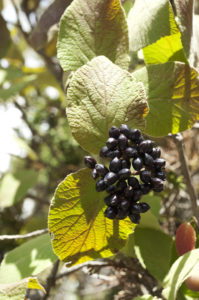
Leaves are always opposite, elliptic or oblong-lanceolate, usually to 6 cm long and 3 cm wide, the mid-vein raised on the underside, lateral veins 4-9, margin with tiny teeth towards the apex. The flowers are arranged in stalked, branched, pendent clusters at the ends of smaller branches. The corolla is white, cream, or pink, tubular, to 8 mm long, with spreading lobes to 2 mm long. Blooming occurs April-June. The fruit is ellipsoid, to 8.5 mm long and 6 mm wide, initially red, later turning purplish or blackish, ripening August-September.
The fruit is edible. In Nepal, juice of the root is taken for cough.
The specific name is Latin, meaning ‘reddening’, presumably alluding to the berries, which are initially red, later turning purplish or blackish.
V. nervosum (below) is quite similar, but may at once be identified by its short corolla tube.
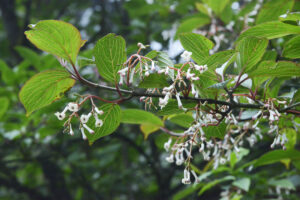
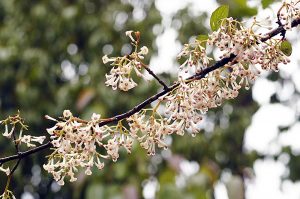
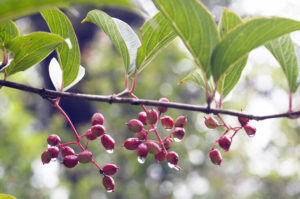
The flowers are very showy, in dense clusters, to 7 cm across, at the end of young branches, usually appearing before the leaves. The corolla is pinkish-white, to 1 cm across, tube to 1.3 cm long. The fruit is edible, ellipsoid, to 2 cm long and 8 mm broad, initially red, later black, ripening June-July.
It is distributed from Pakistan eastwards to Bhutan and south-eastern Tibet, at altitudes between 2,700 and 4,300 m. It is quite common in forests and shrubberies in the western Himalaya.
The specific name is Latin, meaning ‘large-flowered’.
Trees in the western Himalaya were formerly regarded as a separate species, V. foetens, but are now considered a form of V. grandiflorum.
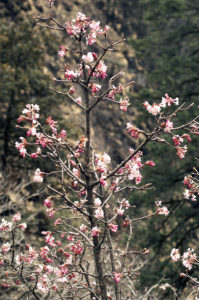
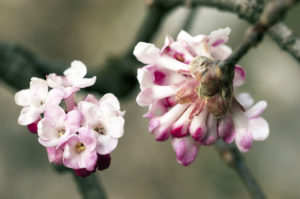
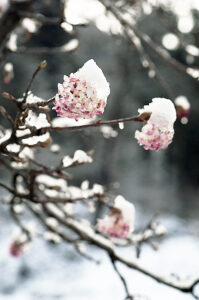
Young branches are covered in a dense layer of greyish-brown short hairs. Leaves are opposite, ovate, long-pointed, to 15 cm long and 6 cm wide, underside covered in a dense layer of stellate hairs, veins conspicuous, impressed, margin with a few faint teeth. Inflorescences appear later than the leaves, an umbel-like, terminal. semi-globular cluster, to 10 cm across. Corolla white, to 4 mm across, tube to 1.5 mm long, with spreading lobes. Flowering occurs June-August. The edible fruit is dark red or scarlet, shining, ellipsoid, to 8 mm long, ripening September-October.
In Nepal, juice of the berries is used for indigestion. The fruit also yields a dye. Walking sticks are made from the branches.
The specific name may be derived from the Sanskrit mulya, which has many meanings, including ‘valuable’.
Formerly, this plant was known as V. stellulatum, alluding to the stellate hairs on the young branches and leaves.
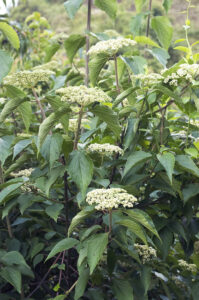
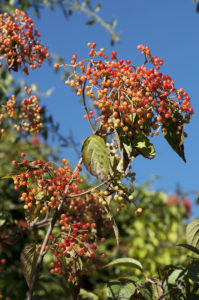
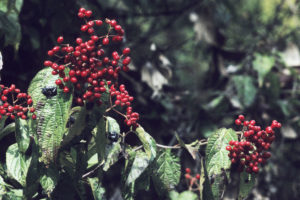
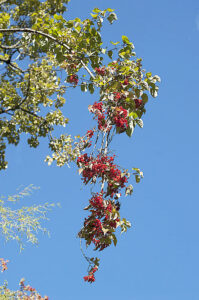
The flowers often appear before the leaves. They are arranged in terminal, umbel-like clusters, to 15 cm across. The calyx is greenish, with small red-brownish glands, and the corolla is white or pinkish, to 8 mm across, tube to 4 mm long, lobes spreading, to 8 mm long. It blooms April-June. The fruit is ovoid, initially yellow or red, purplish-black when mature, to 9 mm long and 7 mm broad. The ripening time is September-October.
It grows in forests and shrubberies at elevations between 2,100 and 4,500 m, from Uttarakhand eastwards to south-western China and northern Vietnam.
The fruit is edible.
The specific name refers to the impressed nerves on the leaves.
V. erubescens (above) is quite similar, but may at once be identified by its long corolla tube.
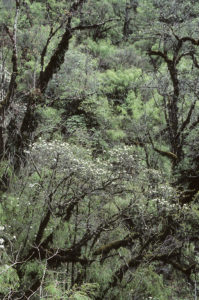
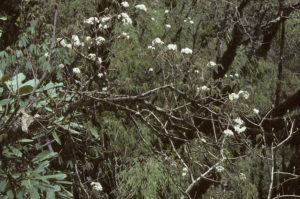
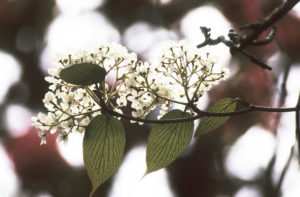
The flowers have 5 very unequal petals, the lower one larger, spurred. The fruit is a capsule, splitting along 3 seams.
The generic name is the classical Latin term for violets.
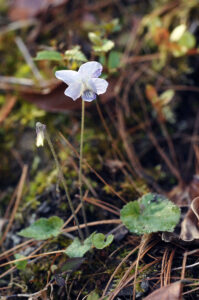
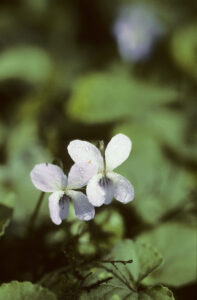
Stem erect or ascending, to 15 cm tall, leafy, slender, with 3-5 nodes. Basal leaves several, long-stalked, blade ovate or kidney-shaped, slightly downy, to 2 cm long and 3 cm broad, margin rounded-toothed, tip rounded. Stem leaves short-stalked, smaller, stipules ovate or oblong, to 6 mm long.
Flowers are solitary or paired, to 1.5 cm across, bright yellow with dark-brown streaks or a blotch near the centre, sepals oblong, pointed or blunt, to 8 mm long, spur short, cylindric, to 3 mm long. Flowering takes place May-August.
The specific name is Latin, meaning ‘with two flowers’. However, the flowers are often solitary.
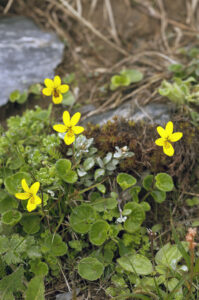
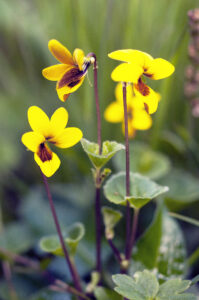
Flowers grow to 1.5 cm across, violet or pale violet, centre often whitish, with a tuft of hairs, lower petal with dark violet streaks. Sepals linear-lanceolate, hairy, to 1 cm long, spur compressed, blunt, to 4 mm long. It blooms between March and June.
This plant is found at elevations between 1,500 and 2,400 m, from Kashmir eastwards to Bhutan. Habitats include shrubberies, forests, and shady slopes.
The specific name is Latin, meaning ‘becoming grey’. It refers to the grey-hairy leaf-stalk and blade.
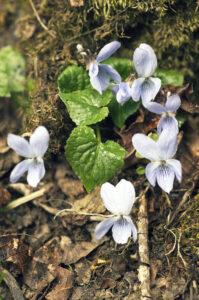
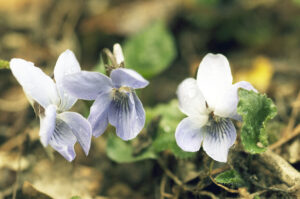
It is very similar to V. canescens (above), but the leaves are larger and long-pointed. Stem very short, with runners rooting at nodes. Leaves almost basal, long-stalked, blade ovate or lanceolate, to 6 cm long and 4 cm broad, hairy or almost hairless, margin toothed, tip long-pointed. Stipules lanceolate, toothed, brown or green, long-pointed, to 1.5 cm long.
Flowers are axillary, long-stalked, to 1.5 cm across, petals obovate, purplish or whitish, the centre streaked purple, with a tuft of hairs, lower petal with dark violet streaks. Spur blunt, whitish, to 6 mm long, sepals lanceolate, hairy, to 7.5 mm long. The flowering period is long, from February to August.
In Nepal, juice of the plant is used for fever and wounds. A paste of the plant or juice from the root is applied to boils on the fingers. Fresh flowers are chewed to treat lung and gall bladder problems.
The specific name is Latin, meaning ‘hairy’. It is not clear what it refers to.
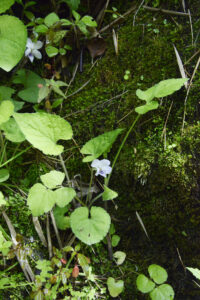
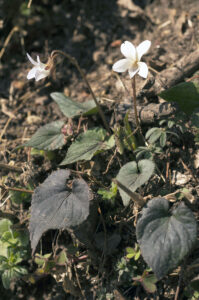
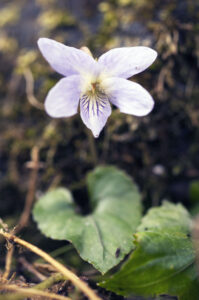
It has a rather restricted distribution, found from central Nepal eastwards to Bhutan and south-eastern Tibet, growing on forest banks and mossy rocks at elevations between 2,100 and 3,000 m. It is quite common in Nepal.
The specific name was given in honour of Danish physician and botanist Nathaniel Wallich (see Schima wallichii above).
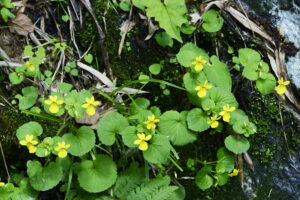
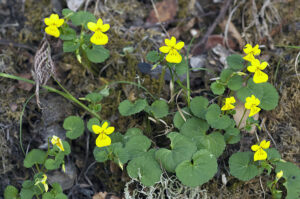
The fruit is a fleshy berry.
The generic name is derived from Ancient Greek Parthenos, another name for the Greek goddess Artemis, protector of suffering women, originally from parthenios (‘virgin-like’), in the form parthenium applied to a number of plants that were utilized for menstruation troubles; and kissos (‘ivy’), thus freely translated as ‘the ivy-leaved plant used for menstruation problems’, or maybe ‘Artemis’s ivy’.
Inflorescences are in terminal or axillary, much-branched clusters, petals ovate to elliptic, yellowish-green, to 2.5 mm long and broad. Blooming occurs March-July. The fruit is a black berry, globular or obovoid, to 8 mm across, ripening August-October.
It is epiphytic, or growing on rocks, found from Pakistan eastwards to China and Taiwan, and thence southwards to Java. In the Himalaya, it occurs at altitudes between 1,800 and 3,800 m.
In Nepal, a poultice of the root is applied to dislocated bones. The foliage is gathered for fodder.
The specific name is Latin, meaning ‘somewhat heart-shaped’. Presumably, it refers to the leaflets.
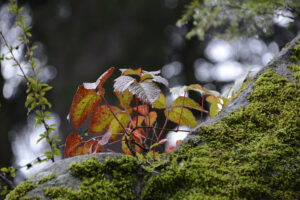
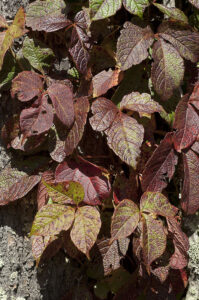
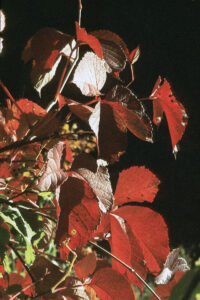
The basal sheaths overlap to form a stem-like pseudostem. The leaves have a ligule, a flap, where the blade meets the stalk or sheath. The flower structure of this family is unique. The calyx is tubular, with 2-3 teeth, the corolla tube has 3 petal-like lobes, the uppermost often larger than the 2 lateral, spreading lobes. The flowers are often showy, subtended by bracts. There is only one fertile stamen, the other 2 are fused to form a lip with 2-3 lobes. The fruit is a capsule. Many species have fruits at ground level. The seeds are often surrounded by a fleshy layer, the aril.
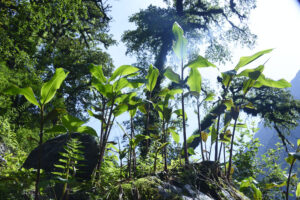
The generic name honours English engineer and palaeontologist Proby Thomas Cautley (1802-1871), best known for conceiving and supervising the construction of the Ganges Canal, stretching about 350 miles from Haridwar to Kanpur and the Yamuna River. He also participated in fossil expeditions in the Siwalik Hills, finding remains of numerous animals, including a hippopotamus, a crocodile, a sabre-toothed tiger, a giant elephant, and an ostrich.
It is distributed from Himachal Pradesh eastwards to northern Myanmar and south-western China, growing in forests and on moist rocks, at altitudes between 1,100 and 2,800 m. It is often epiphytic.
In Nepal, the stem pith is cooked as a vegetable, and juice of the rhizome is used for stomach trouble.
The specific name is Latin, meaning ‘having a spike’, alluding to the inflorescence.
C. gracilis, also found in the Himalaya, is quite similar, but has green, much shorter bracts.
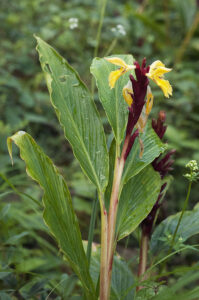
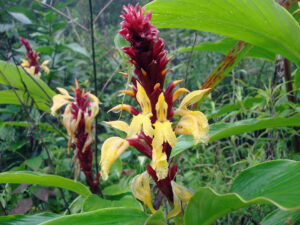
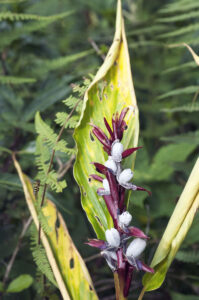
It is generally believed that the generic name is derived from Ancient Greek hedys (‘sweet’) and chion (‘snow’), alluding to the fragrance and snow-white flowers of the type species H. coronarium.
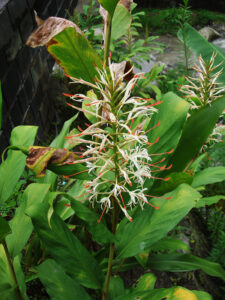
Pseudostem to 2 m long, leaves lanceolate, to 50 cm long and 8 cm broad, tip pointed. Ligule to 2.5 cm long. The inflorescence is a dense, erect, cylindrical, terminal spike, bottlebrush-like, to 30 cm long. Bracts oblong, green, to 3.5 cm long.
Flowers are bright orange-red or red, corolla-tube to 3 cm long, lobes reflexed, linear, to 3 cm long. Lip obovate or rounded, to 2 cm wide, deeply lobed. Stamens protruding, filament bright red or orange, to 5 cm long. Flowering occurs June-August. The capsule is globular, orange-red, to 2 cm across, seeds black, aril red. It ripens in October.
The specific name is Latin, meaning ‘scarlet’, alluding to the flowers of some specimens. However, the species often has orange flowers (as in the picture below), hence the former name aurantiacum, derived from Provençal French auranja, which can be traced back to Persian nareng, the term for the orange (Citrus sinensis).
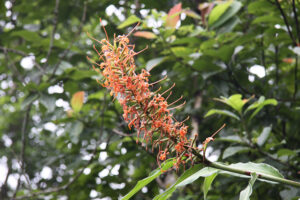
It grows in forests at elevations between 1,800 and 2,800 m, from central Nepal eastwards to Arunachal Pradesh and south-eastern Tibet.
It is cultivated as an ornamental. In Nepal, plates are made from the leaves, and the foliage is strewn in stables as animal beds.
The specific name is Latin, meaning ‘dense-flowered’.
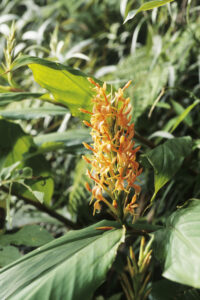
Pseudostem to 2.5 m long, leaves oblong, long-pointed, white-powdered beneath, to 70 cm long. The inflorescence is a dense, erect, terminal spike, to 45 cm long. Bracts large, oblong, brown, to 4 cm long. Flowers pale yellow or lemon-yellow, corolla-tube to 5 cm long, lobes reflexed. Lip wedge-shaped, to 3 cm long, with 2-3 teeth. Stamens are twice as long as lip, to 6.5 cm long, filaments reddish-orange. It blooms August-September.
In Nepal, juice of the rhizome is taken for indigestion and fever.
The specific name honours Scottish botanist George Gardner (1810-1849), who is mainly known for his collections in Brazil and Sri Lanka (then Ceylon). His works include Musci Britannici, or Pocket Herbarium of British Mosses arranged and named according to Hooker’s “British Flora”, and Travels in the Interior of Brazil, principally through the Northern Provinces and the Gold Districts, during the years 1836-41. His material from Sri Lanka was never published due to his early death, in Kandy, due to apoplexy.
In Hawaii, this species is called kahili, alluding to the similarity of the inflorescence to the large feather-topped staff, formerly carried by the king’s escorts.
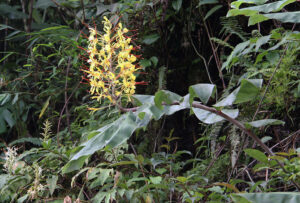
Pseudostem to 1.5 m long, leaves 4-7, oblong or lanceolate, pointed, to 40 cm long and 10 cm broad. Ligule to 2.5 cm long, membranous. Flowers are arranged in a dense, erect, terminal spike, to 25 cm long. Bracts green, oblong, to 3 cm long. Calyx to 3.5 cm long, split on one side, with 3 teeth. Flowers white or yellowish with orange or brownish base, fragrant, corolla-tube to 8 cm long, lobes linear, to 2.5 cm long. Lip yellowish, sometimes purplish-red, filaments pale reddish, shorter than the lip. Flowering occurs June-September. The globular capsule, to 2.5 cm across, has orange markings, seeds black, aril red. Ripening takes place October-November.
Perfume is made from the rhizome. In Nepal, juice of the rhizome is used for fever, elsewhere for diarrhoea and toothache.
The specific name is Latin, meaning ‘having a spike’, alluding to the inflorescence.
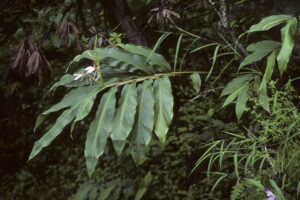
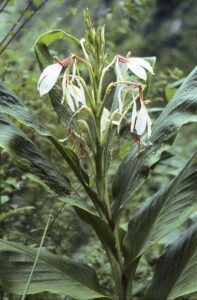
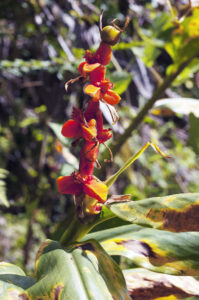
This species is native from Uttarakhand eastwards to north-eastern India and northern Myanmar, growing in forests and shrubberies at lower elevations, up to around 1,200 m.
The specific name means ‘formed like a thyrse’, derived from Ancient Greek thyrsos, a wand wreathed in ivy and vine-leaves with a pine-cone at the top, carried by devotees of Dionysos, the wine god. The fruit somewhat resembles a pine cone.
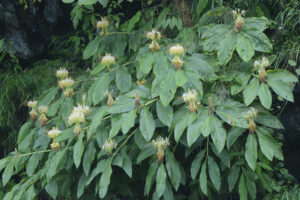
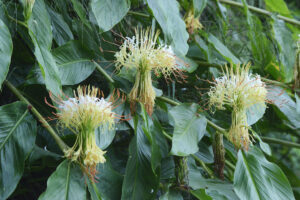
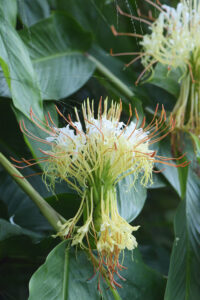
The generic name commemorates English banker, lawyer, and botanist William Roscoe (1753-1831), who founded the botanical garden in Liverpool, and he donated large amounts for research at the Kew Gardens in London. He also wrote a collection of poems for children, titled The Butterfly’s Ball, and the Grasshopper’s Feast.
It is gregarious, often forming large growths in forests and on open slopes, at elevations between 2,400 and 4,000 m. It is distributed from Pakistan eastwards to Arunachal Pradesh. It is very common in Nepal.
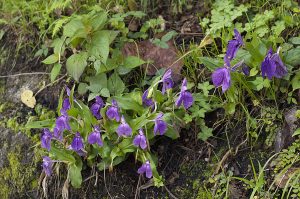
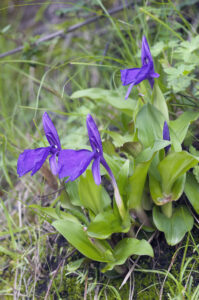
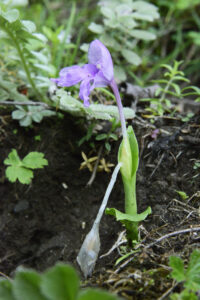
It is distributed from eastern Nepal eastwards to Bhutan and south-eastern Tibet, growing in forests and on open slopes at altitudes between 2,100 and 4,900 m.
The specific name is Latin, meaning ‘with a small ear’, alluding to the leaves.
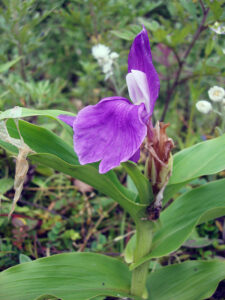
This plant is restricted to central Nepal and an adjacent area of southern Tibet, growing in forests and on open slopes at elevations between 1,200 and 2,600 m. It is quite common in Nepal.
The specific name is Latin, meaning ‘with a head’, alluding to the dense inflorescence.
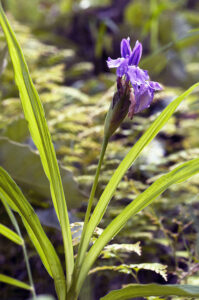
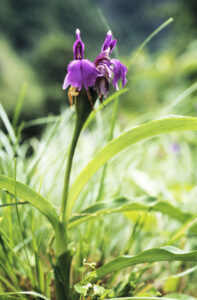
Pseudostem to 50 cm tall, chocolate-brown when old. Leaves 4-8, in 2 ranks, linear, oblong, or lanceolate, sometimes sickle-shaped, keeled, to 20 cm long, only slightly eared at base, tip pointed.
Flowers are few in a terminal spike, stalks enclosed in the upper leaf sheaths, pale lilac, mauve, pink, or white, usually only 1-2 flowers open at a time. Corolla-tube to 5 cm long, upper lobe forming a narrow hood, side-lobes narrow. Lip to 6.5 cm long and 5 cm wide, with 2-3 lobes, not deflexed. Flowering takes place June-September.
In Nepal, boiled tubers are eaten. Tamang people of the Rasuwa District feed the tuber to animals with indigestion.
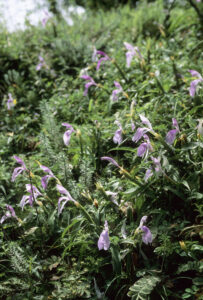
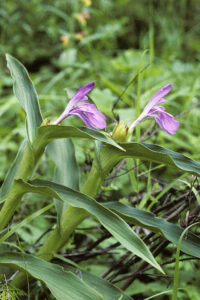
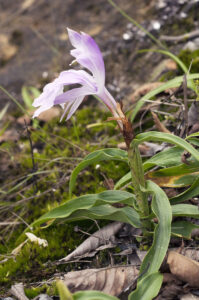
The generic name is derived from Ancient Greek zingiberis, stemming from the Indian word singabera, which was probably adapted from inchi-ver, the ancient Dravidian name of this spice in two South Indian languages, Tamil and Malayalam.
The common name is a corruption of the generic name.
This plant is restricted to lower valleys, occurring from Uttarakhand eastwards to Sikkim, found in shrubberies and along forest margins at elevations between 450 and 1,600 m. It is prominent in the Lower Marsyangdi Valley, central Nepal.
The specific name is derived from Ancient Greek khrysos (‘gold’) and anthos (‘flower’), thus ‘with golden flowers’.
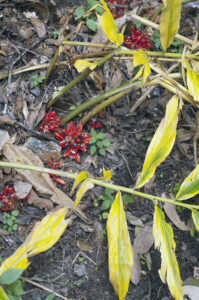

Fruits of these plants are spiny carpels.
The generic name stems from Ancient Greek tribolos, the classical term for several plants with spiny fruits, and also the term for a weapon called caltrop (see below).
A prostrate herb, very variable, branches to 60 cm long, spreading, silky-hairy or hairless. Leaves opposite, pinnately divided, to 5 cm long, stipules lanceolate or sickle-shaped, to 5 mm long. Leaflets 6-16, ovate or oblong, entire, to 12 mm long and 8 mm broad, pointed or blunt.
Flowers are yellow, sometimes white with yellow centre, to 1.5 cm across, sepals ovate or lanceolate, to 6 mm long and 3 mm broad, pointed, persistent, petals obovate, to 8 mm long and 4 mm broad, blunt. Stamens 10, filaments to 5 mm long. The flowering period is from May to August.
The fruit is to 1 cm across, with 2 long and 2 short, very strong spines, which are able to penetrate a bicycle tyre, giving rise to the popular name puncture vine. When the fruit is lying on the ground, at least one thorn is always pointing upwards, so that it may stick to a foot of a passing animal. If a furry animal, like a sheep, lies down in an area with these fruits, several of them will stick to its fleece. In this way, the seeds are dispersed. Much damage has been done to the feet of livestock by these fruits. Ripening takes place June-September.
In Ancient Greece, the fruits were called caltrop, which was also the term for a small metal weapon with several spikes, of which one was always pointing upwards. During warfare, these caltrops were spread on roads and footpaths to prevent traffic of the enemy’s soldiers, horse riders, and horse-drawn vehicles.
Formerly, this species was much utilized in traditional medicine, described on the page Plants: Plants in folklore and poetry.
The specific name is Latin, literally meaning ‘pertaining to the ground’, but in a botanical context ‘growing near the ground’.
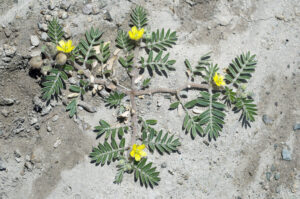
In this section, I have benefitted from the book Ferns – The Beauty of Nepalese Flora, by Vidya Laxmi Gurung, Sahayogi Press, Kathmandu, 1991. Unfortunately, the photographs are black-and-white.
As opposed to flower plants, ferns multiply by spores, which are formed in sporangia, a word derived from Ancient Greek spora (‘seed’) and angeion (‘vessel’). Sporangia are grouped in sori, usually found on the underside of the leaf blade. Young sori are normally covered by a layer of protective tissue. Leaves of ferns are called fronds, and the leaf-stalk is named stipe.
In the Himalaya, many fern species are utilized medicinally, and young specimens of other species are cooked as a vegetable.
Below are seven pictures of unidentified species. If you are able to identify any of these, please let me know. You can use the address at the bottom of the page.
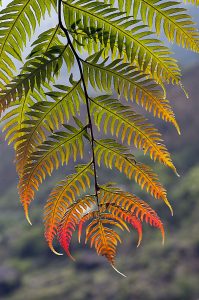
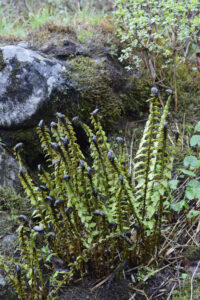
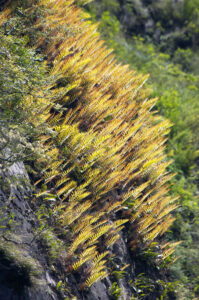
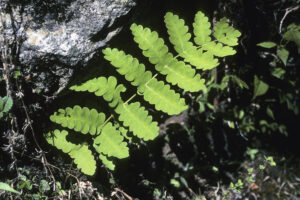
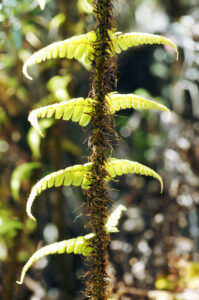
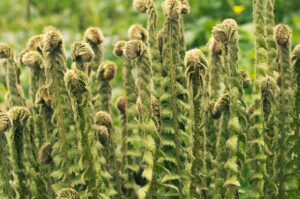
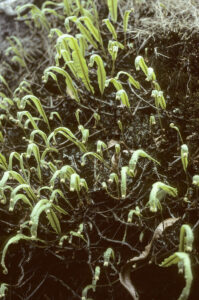
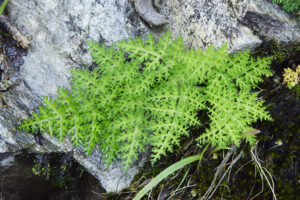
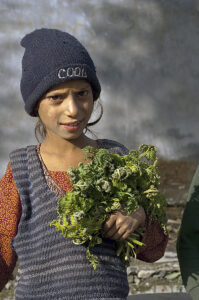
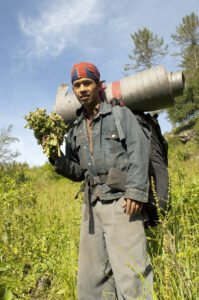
The generic name is derived from Ancient Greek alsos (‘grove’) and philos (‘to love’), thus ‘fond of growing in small woods’.
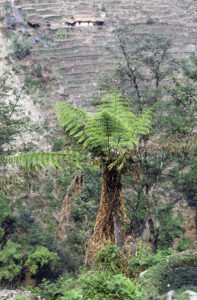
The generic name is derived from Ancient Greek polys (‘many’) and stikhos (‘row’), alluding to the many pinnae of these plants.
This plant is restricted to Himalayan forests, from Pakistan eastwards to Bhutan. It is very common, growing at altitudes between 1,900 and 3,000 m.
In Nepal, tender parts are cooked as a vegetable.
The specific name is Latin, meaning ‘scabby’, undoubtedly referring to the many scales along the leaf-stalk and mid-rib.
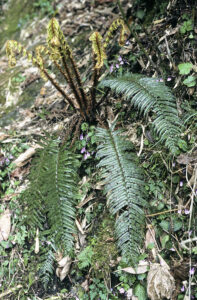
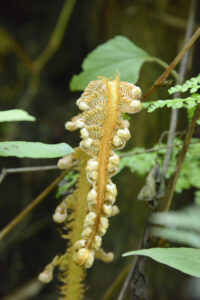
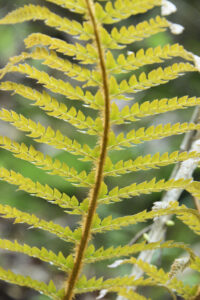
The generic name is derived from Ancient Greek dis (‘twice’), kranion (‘skull’), and pteron (‘wing’), thus ‘two-headed wing’, referring to the dividing branching pattern (see picture below).
Leaf-stalk and mid-rib are dark brown, pinnae pale green, often shining, ultimate ones lanceolate, to 25 cm long and 7 cm wide, with 25-40 lanceolate lobes on each side, to 7 cm long and 6 mm wide, divided almost to the mid-rib, margin entire, tip rounded. The sori are in a row on both sides of the mid-rib.
This plant grows in sunny areas in forests, often on steep slopes in disturbed habitats. It is widely distributed, from the Indian Subcontinent eastwards to Japan, and thence southwards to Australia. It also occurs in Africa south of the Sahara, on Madagascar, and on many islands in the Pacific. In the Himalaya, it is found at altitudes between 900 and 3,000 m.
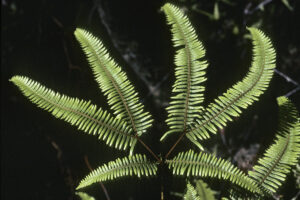
The generic name is derived from Ancient Greek diplous (‘double’) and pterygion, diminutive of pteryx (‘wing’), alluding to the opposite pinnae of the genus, which resemble wings (see picture of withering pinnae below).
This species is found at forest margins and on open slopes, in the Himalaya at elevations between 800 and 3,000 m. It occurs from Nepal eastwards to central China and northern Indochina, and also on the island of Hainan.
It was previously known as Gleichenia gigantea.
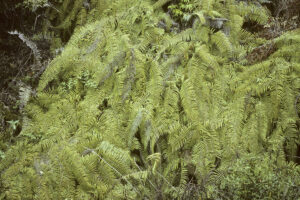
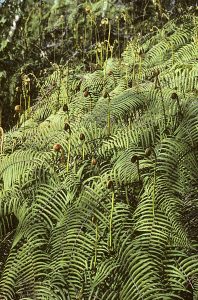
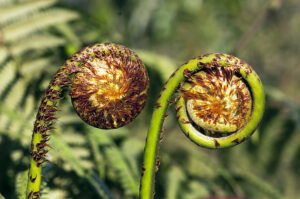
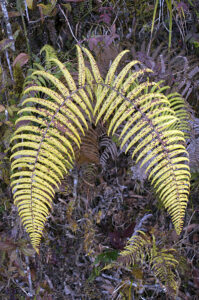
The generic name is derived from Ancient Greek, meaning ‘with toothed sori’.
It mainly grows in disturbed areas, including forest clearings and landslides, and along trails and roads. In the Himalaya, it may be found up to elevations around 2,400 m.
Fronds are pale green, leaf-stalk to 30 cm long, blade ovate or lanceolate in outline, to 50 cm long and 20 cm wide, divided 3 or 4 times, pinnae 15-20 pairs, short-stalked, alternate, ovate or lanceolate, 3-pinnate at base, tip pointed, terminal pinnae to 4 mm wide, tip rounded or flat, with tiny lobes. Sori clustered on terminal pinnae.
In Nepal, a paste of the plant is applied to cuts and wounds.
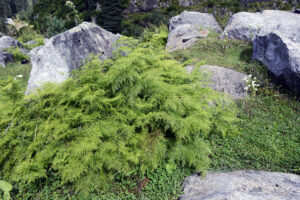
The generic name alludes to the nerves on the leaves, which resemble those on the leaves of oleander (Nerium oleander).
It occurs in forests, epiphytic or growing on rocks at elevations between 1,200 and 3,500 m, distributed from the Himalaya eastwards to northern Indochina and south-western China.
In Nepal, a paste of the rhizome is applied to the forehead to cure headache, and also used to treat dislocation of bones.
The specific name was given in honour of Danish physician and botanist Nathaniel Wallich (see Schima wallichii above).
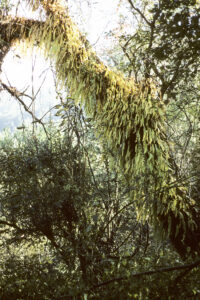
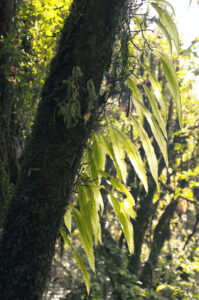
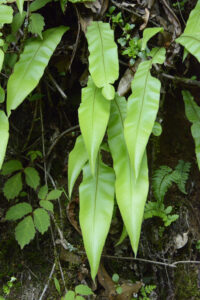
The origin of the generic name is uncertain. It may be an old French name of a type of fern. A more colourful theory is that it stems from an English folk tale of a boatman, named Osmund, who hid his wife and children in a patch of royal fern during the Danish invasion.
The native range is from the western Himalaya eastwards across northern Indochina and China to Taiwan, and thence northwards to Japan and south-eastern Siberia (Ussuriland). It often forms large growths on hillsides, in the Himalaya chiefly at elevations between 1,600 and 3,400 m.
Some authorities regard this plant as a subspecies of the eastern North American O. claytoniana.
The specific name is derived from the Latin pilus (‘hair’) and osus (‘full of’), thus ‘very hairy’.
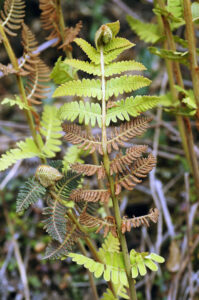
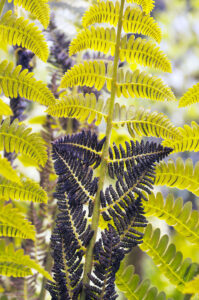
The genus was named in honour of Dutch botanist Monique Bosman (born 1958), who first characterized this group in her 1991 monograph of Microsorum.
This species mostly grows on rocks, and also in soil, rarely as an epiphyte. It is found in forests, from the Indian Subcontinent eastwards to Japan, and thence southwards through the Philippines to Sulawesi. In the Himalaya, it occurs at elevations between 400 and 2,700 m.
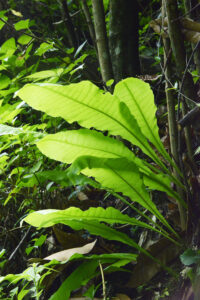
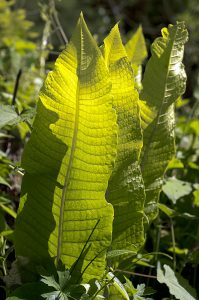
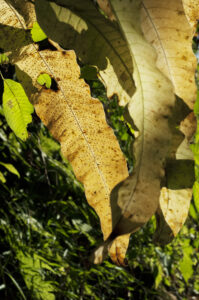
The generic name is derived from Ancient Greek dryas, meaning ‘with a leaf-shape like oak’.
This species has a wide distribution, from Uttarakhand eastwards to China, and thence southwards through Indochina, with an isolated population in Java. It is epiphytic or sometimes growing on rocks, in the Himalaya occurring at elevations between 500 and 2,500 m.
It is much utilized in traditional Nepalese medicine, in which a paste, made from the rhizome, is applied to treat backache, headache, sprains, and dislocated bones. In traditional Chinese medicine, it has been utilized for various ailments, including deafness, tooth ache, diarrhoea, involuntary urination, bone fractures, and hair loss.
The specific name is Latin, meaning ‘resembling’. It is not clear what it refers to.
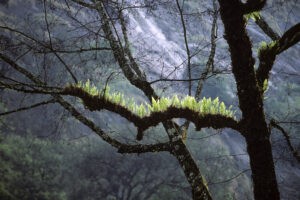
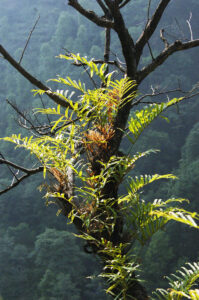
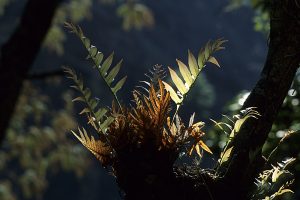
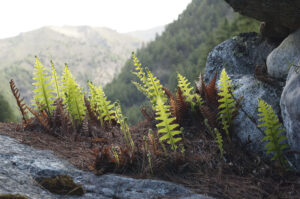
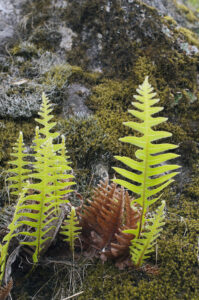
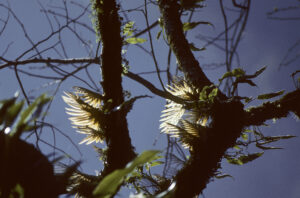
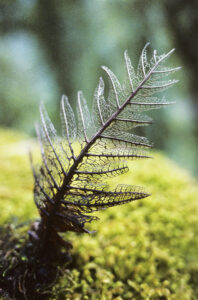
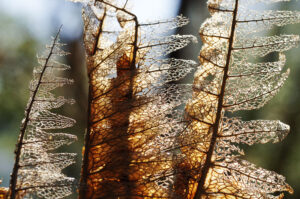
These plants closely resemble members of the genus Polypodium and were previously included in it.
The generic name is derived from Ancient Greek gonia (‘angle’) and phleps (‘vein’). Presumably, these plants have angled veins.
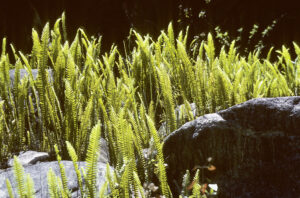
The generic name is derived from Ancient Greek lepis (‘scale’), thus ‘with scaly sori’.
The leaf-stalk is short, occasionally to 7 cm long, blade linear, leathery, usually 20-30 cm long, sometimes to 60 cm, and to 2.5 cm wide, widest at the middle. The sori are in a row on both sides of the mid-rib, dark, circular, to 3 mm across.
The specific name is derived from the Latin lorum, genitive lori (‘leather strap’ or ‘rein’), thus ‘strap-formed’, alluding to the frond shape.
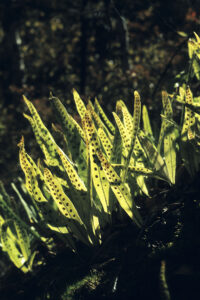
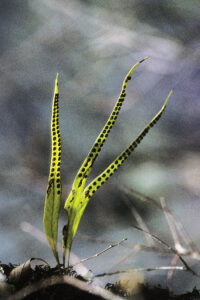
The generic name stems from Ancient Greek pyrrhos (‘flame-coloured’), ultimately from pyr (‘fire’), alluding to the reddish tint of the star-shaped hairs on some of the species.
Grows in forests as an epiphyte, on rocks, or in soil, found at elevations between 1,000 and 3,500 m. It is distributed from Uttarakhand eastwards to northern Indochina and the Yunnan Province.
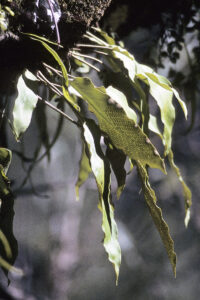
The generic name is derived from Ancient Greek adiantos (‘not wet’), but was also the ancient name of the maidenhair fern, whose leaves are indeed water-repellent. The connection with women stems from the pagan tests in Ancient Greece. In one of these tests, a woman could prove herself innocent of what she was accused for, if she could dip her hair into water without getting it wet – just like the leaves of maidenhair fern.
Fronds are bright green, to 40 cm long and 11 cm across, stalk slender, black, glossy, to 20 cm long, blade mostly twice pinnate below the middle, but only once pinnate above the middle, pinnae 3-5 on each side, to 2 cm wide and 1 cm long, with 2-4 lobes. The sori are situated along the upper margin of lobes on the fertile segments.
Around the world, this species is popular as a garden ornament. In Nepal, it is much utilized as a medicinal plant. A paste of it is applied to the forehead in case of headache, and to the chest to relieve chest pain. It is also applied to boils. Juice of the frond, mixed with honey, is taken for cough. It is also used for irregular menstruation.
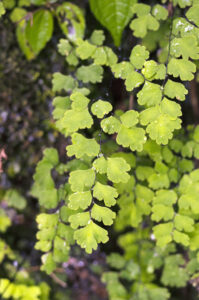
In 1753, Swedish botanist Carl Linnaeus (1707-1778) named these plants Lycopodium, derived from Ancient Greek lykos (‘wolf’) and pous (‘foot’). Apparently, he likened the tip of the branches to a wolf’s paw.
I have not been able to identify any species in the Himalaya.
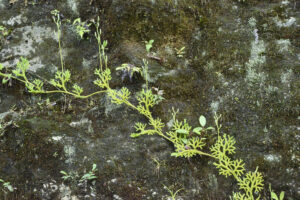
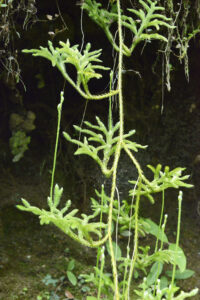
The alga or the cyanobacterium is attached to the thread-like mycelium of the fungus, which is again attached to the soil, or to stones or trees. Thus, the alga or cyanobacterium is protected from most enemies, and in return it provides the fungus with essential carbohydrates that the fungus cannot produce. The mycelium, however, is able to obtain certain nutrients from the soil or from the air, which benefit the alga or cyanobacterium.
An unknown number of lichens occur in the Himalaya. I have only been able to identify members of two families. Below are 5 pictures, depicting unidentified lichens.
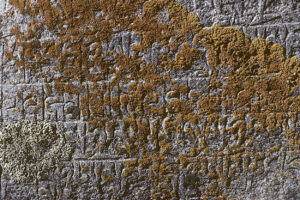
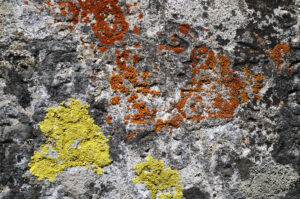
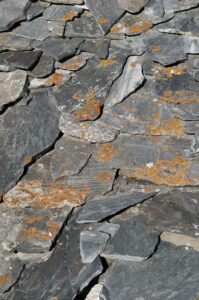
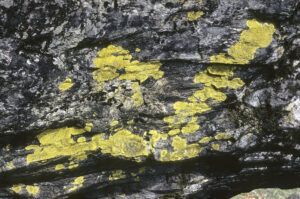
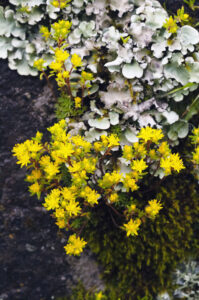
In his book Flora Danica, from 1648, Danish physician and herbalist Simon Paulli (1603-1680) gives this fascinating account of old-man’s-beard lichen: ”But above all other kinds of moss [lichens], which grow in the forests on trees, rocks and other places, the most famous one is Usnea, sev Muscus cranii humani, meaning: ’That moss which grows on human skulls’, which, although rarely, is sometimes found on the skulls of miscreants, who have been beheaded, or otherwise done away with, and whose heads have been placed on a stake.”
The generic name derives from Arabicʾ ušna (‘moss’). In former days, botanists didn’t distinguish between mosses and lichens, see above caption.
The specific name is Latin, meaning ‘very long’.
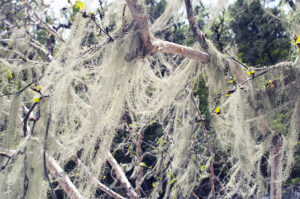
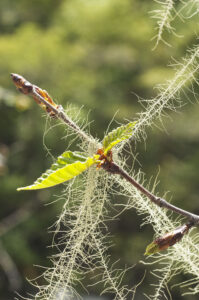
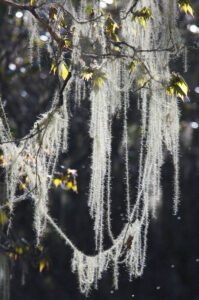
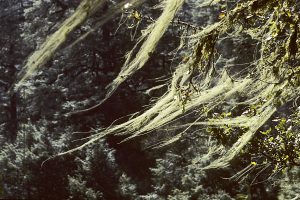
Previously, these organisms constituted a separate family, Lobariaceae, but have lately been moved to Peltigeraceae.
The generic name is Latin, meaning ‘lobed’, ultimately derived from Ancient Greek lobos (‘a lobe of the liver’), alluding to the lobed thallus. The name lungwort likewise refers to the thallus, the surface of which resembles that of a lung.
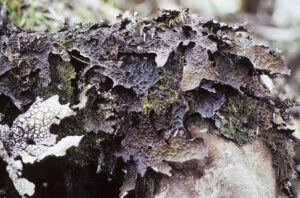
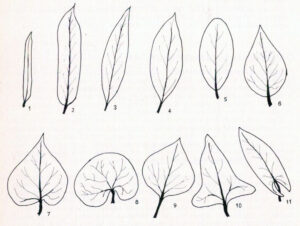
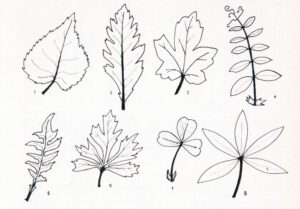
Male organs in a flower are called stamens, divided into a long, thread-like filament and a terminal anther, from which the pollen, tiny grains containing the male cells, is spread.
The female organ is called a carpel, comprising the egg-producing ovary, an often long, columnar style, on the end of which sits the stigma, which receives the pollen during fertilization.
